It seems we can’t find what you’re looking for. Perhaps searching can help.
Sign Up for newsletter!
Subscribe to get the latest eBook!
Hotline







As Monolithic architecture solutions face flexibility, customization, and scalability challenges, businesses are increasingly exploring more adaptable architectures, like Headless Commerce.
Alongside this, the concept of ‘Composable Commerce’ has gained prominence as a robust model to cater to the evolving needs of businesses and the swiftly changing market.
So, what exactly it is, and how does it distinguish itself from Headless Commerce? Let’s investigate these aspects to comprehend why it might represent a revolutionary leap forward.
The term ‘Composable Commerce’ was first coined by Gartner Research in June 2020, referring to building a flexible and customizable e-commerce system by integrating various components to build distinct ‘Packaged Business Capabilities’ (PBCs) solutions tailored to the deployment needs. These PBC solutions can connect through APIs.
The PBCs may include:
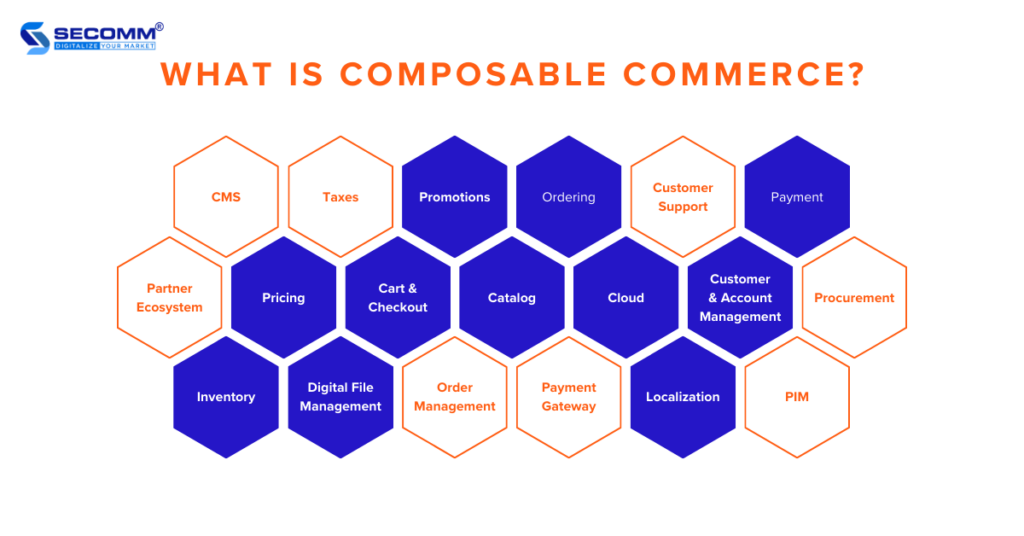
If we consider components as smaller and more intricate elements of the eCommerce system, PBCs represent the integration of each of these smaller components to craft a unique eCommerce solution tailored to each business. In this scenario, components are on an equal footing, and so are the PBCs.
Therefore, any modifications or expansions in any component or PBCs won’t impact the overall operation of the entire system.
To put it more simply, within the composable architecture, you build your eCommerce system much like assembling a Lego set.
Here, each PBC corresponds to a specific Lego block with a designated function. These blocks can seamlessly combine and link through APIs, resulting in a flexible and personalized eCommerce experience that aligns with your initial needs and wants.
Hence, the eCommerce development model allows you to attain the utmost flexibility and optimization for your eCommerce system.
Some benefits to highlight when adopting Composable architecture:
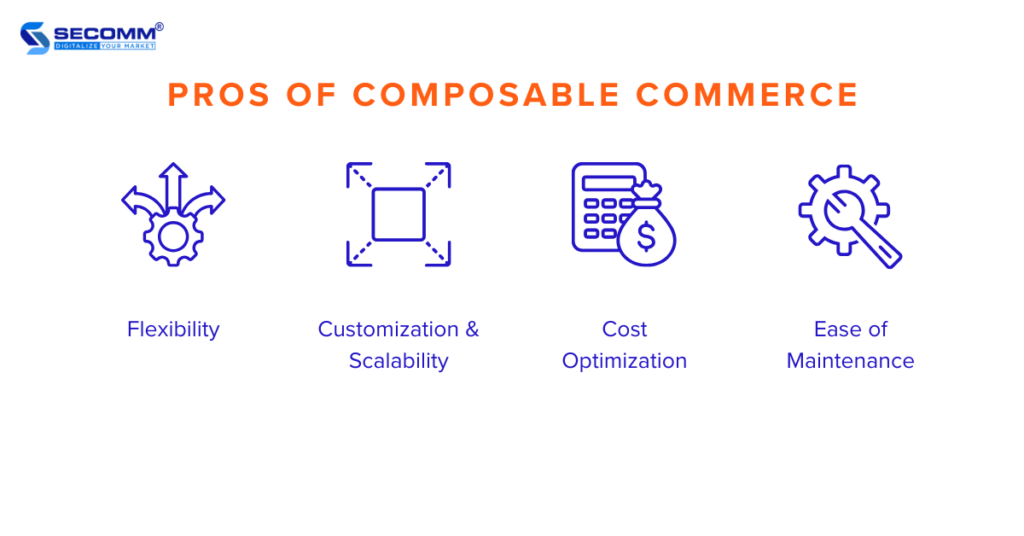
This eCommerce development model offers high flexibility. You can select to combine the most suitable components for your needs. This flexibility allows you to easily create an eCommerce system that adapts to market trends and ever-changing customer experience expectations.
The model can meet the highest demands for customization & scalability. You can freely customize each component based on your brand and what you want for customer experience. But you can also scale individual components to handle growing traffic and transaction volumes.
This level of customization and scalability allows you to offer a distinctive shopping experience, boost competitiveness, and expand your operations without the need for a complete overhaul of the system architecture.
Despite the initial setup costs, deploying Composable Commerce can help you save your development costs in the long run. Because you only need to pay for specific components they use and optimize your PBCs to avoid unnecessary expenses.
Most current Composable Commerce solutions offer discounts as more components are integrated, with Commerce Components by Shopify being a prominent example.
Components in the Composable Commerce architecture are often separated and become independent of each other, making maintenance and updates for each component easier. This minimizes disruptions and the risk of system downtime during maintenance or upgrades.
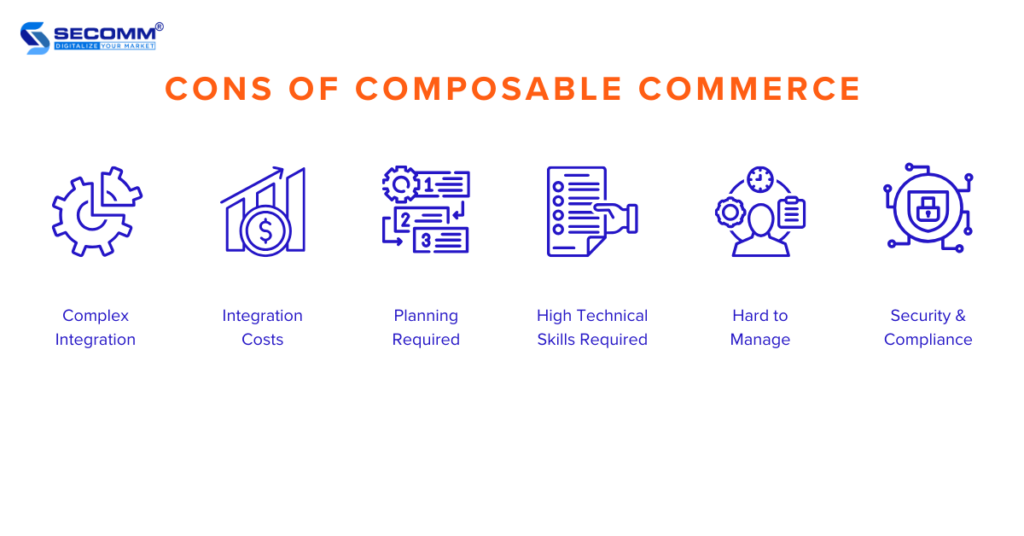
Composable Commerce demands the integration of various components, and this process can be complicated and time-consuming. You’ll need to ensure that these independent components operate seamlessly and efficiently within the same system, requiring additional development and customization efforts.
At scale, the need for deploying a complex system may increase, and integrating multiple components may lead to high upfront and ongoing costs. So, it’s important to phase resources for continuous development, testing, and maintenance of this integrated operation.
Implementing a Composable Commerce architecture requires meticulous planning from the number of components, choice of suppliers, and integrated solutions to issues related to maintaining and upgrading these components.
Building and maintaining an eCommerce system following the Composable Commerce model demands a high level of knowledge and technical skills in various technologies and integrated solutions. You must invest in training your in-house teams or collaborate with highly specialized entities.
Managing a Composable Commerce system can be a significant challenge, especially when you integrate components from multiple 3rd-party suppliers. While Composable Commerce provides flexibility in integration, it also implies that you have to manage relationships with various suppliers.
When there is a need for expansion, you’ll work with these suppliers to ensure each component can scale concurrently and efficiently, avoiding any adverse impact on system development.
Ensuring the security and following rules for many components at the same time can be tricky. Each supplier has their own security and rule needs. So, how can you follow all the rules from each supplier without messing up the way your Composable Commerce system works? – That’s the point!
Both Composable and Headless Commerce architectures separate the frontend and backend, providing a higher level of flexibility and customization. These technology solutions are currently the focus of many large businesses worldwide.
So, what is the main difference between the two?
In the Headless architecture, the separation of the frontend and backend allows you to update and customize either the frontend or backend without affecting each other.
On the other hand, the modular nature of Composable architecture takes it a step further by decoupling all eCommerce components, enabling you to choose and set up perfect PBCs (Packaged Business Capabilities) for your needs.
The key feature of Composable architecture is that, while the frontend can connect to various components at the backend through APIs, these components are highly modular and independent. This means that changes to one component won’t affect other components or the frontend interface.

Should we deploy Headless Commerce or Composable Commerce?
When considering the prospects of eCommerce architectures, it is evident that both Composable and Headless Commerce offer superior customization and scalability, allowing you to break free from traditional constraints to adapt to market trends. However, the decision to implement a specific architecture will depend on your business needs, technical expertise, and the goals you want to achieve.
With SECOMM’s extensive expertise and deep experience in successfully deploying numerous Headless Commerce projects, we serve as a reliable partner to advise businesses looking to implement this architecture with innovative solutions.
Contact us or call directly on the hotline at 028 7108 9908 to take a leap forward with SECOMM and unlock the full potential of both Headless and Composable Commerce today!
 2
2
 6,960
6,960
 0
0
 1
1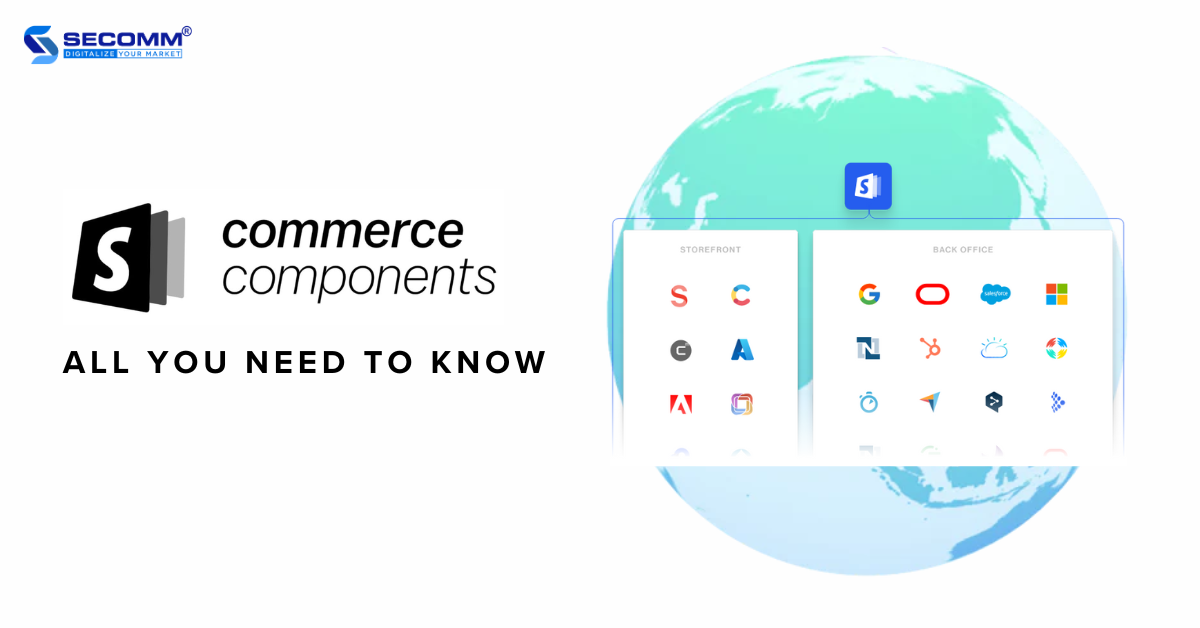
Today, with the growing demand for flexible and scalable eCommerce system development, large-sized businesses turn their attention to solutions like Headless, Microservices, and Composable Commerce. The Composable approach will allow you to integrate independent components to tailor and enhance the eCommerce experience.
Knowing this insight, Shopify has unveiled the Commerce Components solution, offering you — as a large-sized business — the most straightforward approach to deploying Composable Commerce.
Learn more: What is Composable Commerce?
Commerce Components is an innovative tech stack designed for large businesses. Rather than introducing new features, the company has transformed its infrastructure into modular components that can be combined to build and customize adaptable eCommerce websites. This means you can select components based on your deployment needs and seamlessly integrate them into your existing tech stack using flexible and unlimited API connections, ensuring a smooth customer experience across all devices.
“We’ve always approached innovation by anticipating what retailers need and then providing those solutions,” said Harley Finkelstein, president of Shopify. “Commerce Components opens our infrastructure so enterprise retailers don’t have to waste time, engineering power and money building critical foundations it has already perfected, and instead frees them up to customize, differentiate and scale”
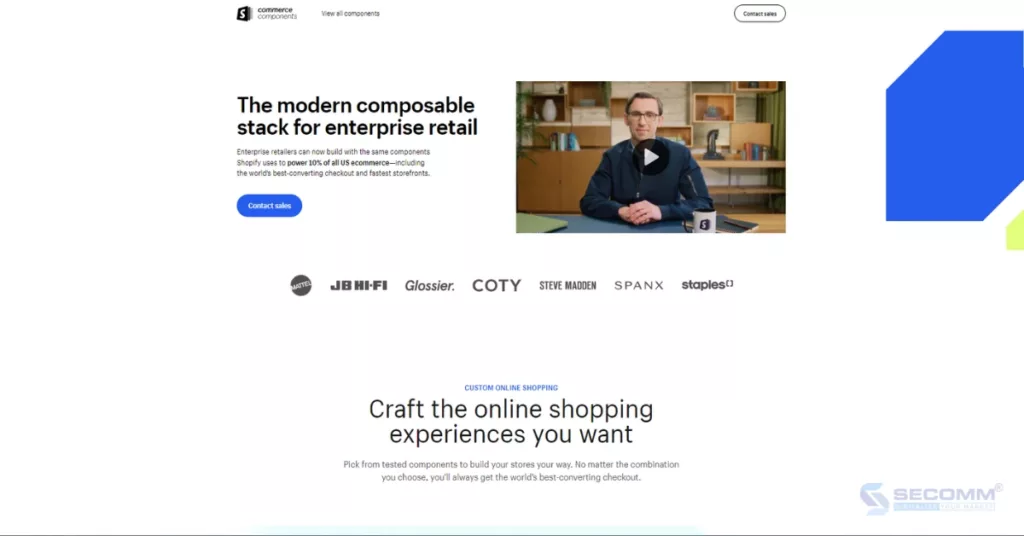
The solution offers six main categories including over 30 components, allowing you to build a tailored solution that aligns with your needs.
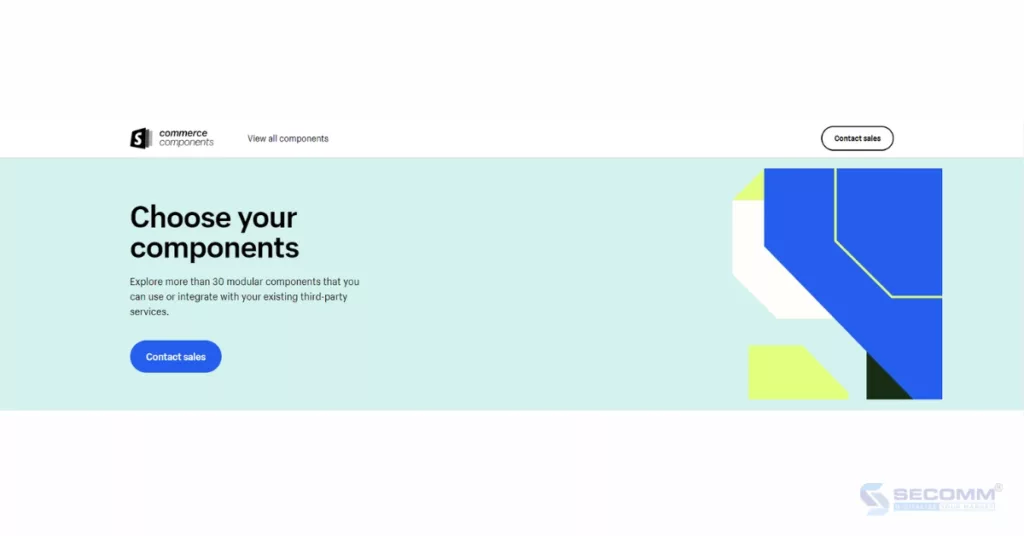
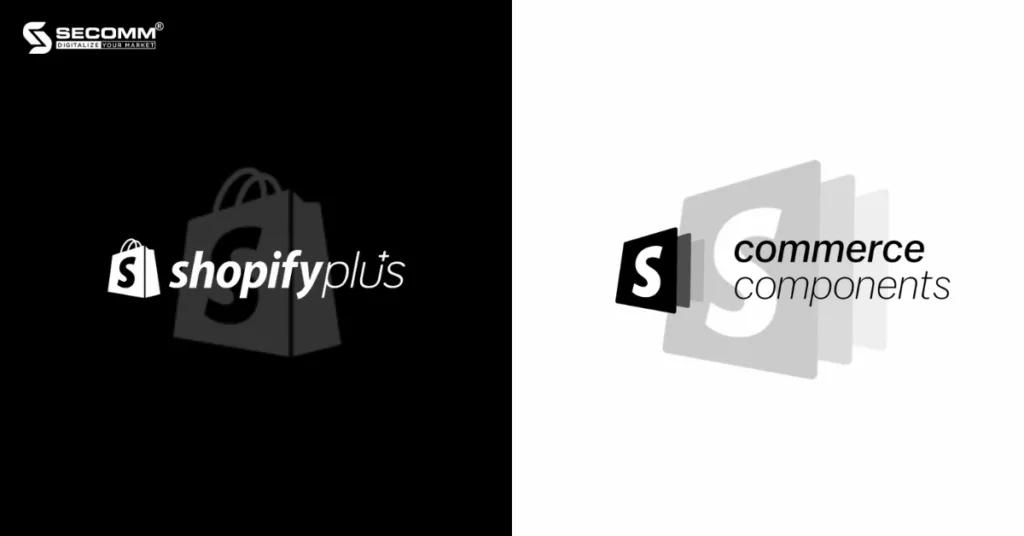
Although both ‘Plus’ and Components are enterprise eCommerce solutions, they differ in several aspects:
If you don’t prefer to deploy pre-packaged eCommerce platforms. Composable architecture is the ideal choice. It allows you to select and purchase components based on your needs, integrate them into your existing systems, and customize them.
With its modular architecture, the tech stack provides unlimited API connections, meaning there is no limit to the number of components and add-ons that you can use to build your tech stack.
Moreover, since components are entirely independent, you can add, remove, and modify components without affecting the entire system.
Commerce Components employs a pricing model structured around the level and quantity of components used. This means you only pay for the components you require. Furthermore, as you acquire and utilize more components, you’ll benefit from increasingly significant discounts.
Additionally, the annual payment structure of Components helps you facilitate precise cost predictions.
Since its inception, the platform has proudly highlighted the trust and adoption of its solution by major global businesses. Notable among these are Glossier, JB Hi-Fi, Coty, Steve Madden, Spanx, and Staples.
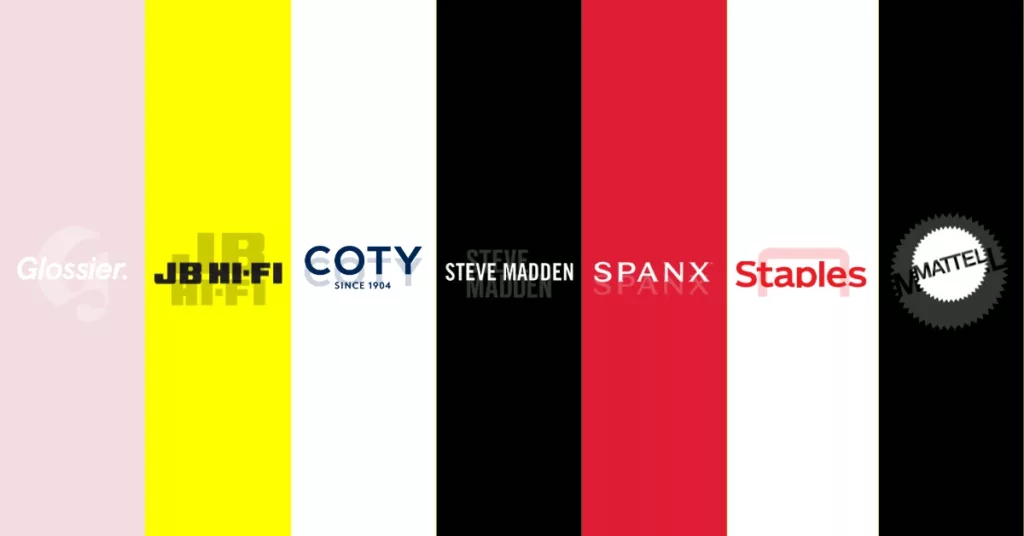
Leading U.S. toy brand Mattel is one of the first enterprises to successfully implement this technology solution. Sven Gerjets, Mattel’s CTO, said in a statement.
“We first worked with Shopify on a project called Mattel Creations, a platform for creators to reimagine the most iconic toys in the world. Creations empowered Mattel to move quickly, meet our customers where they are, and most importantly leverage its infrastructure to scale globally. It was hugely successful, and we’re excited to transform our brand offerings using Commerce Components.”
The trust placed by Mattel and other industry leaders forms a solid basis for expecting the ongoing success of this new solution, extending its impact not only within the U.S. market but also on a global scale.
Final Thoughts
In the past, large businesses often favored open-source platforms like Magento or Salesforce due to their customizable and flexible expansion capabilities. However, in today’s landscape, SaaS platforms, particularly Shopify, offer innovative solutions for developing Composable or Headless Commerce.
In 2021, the company launched the Hydrogen + Oxygen solution to enhance Headless Commerce development. Continuing this trend into early 2023, they once again surprise the industry with Commerce Components, designed for deploying Composable Commerce.
This move highlights its commitment to anticipating and responding to customer needs, earning the trust of large enterprises in the face of competitive rivals.
Reach out or call the SECOMM hotline at 028 7108 9908 for a more in-depth understanding of Commerce Components by Shopify and to explore the implementation of Headless Commerce or Composable Commerce.
 2
2
 11,224
11,224
 0
0
 1
1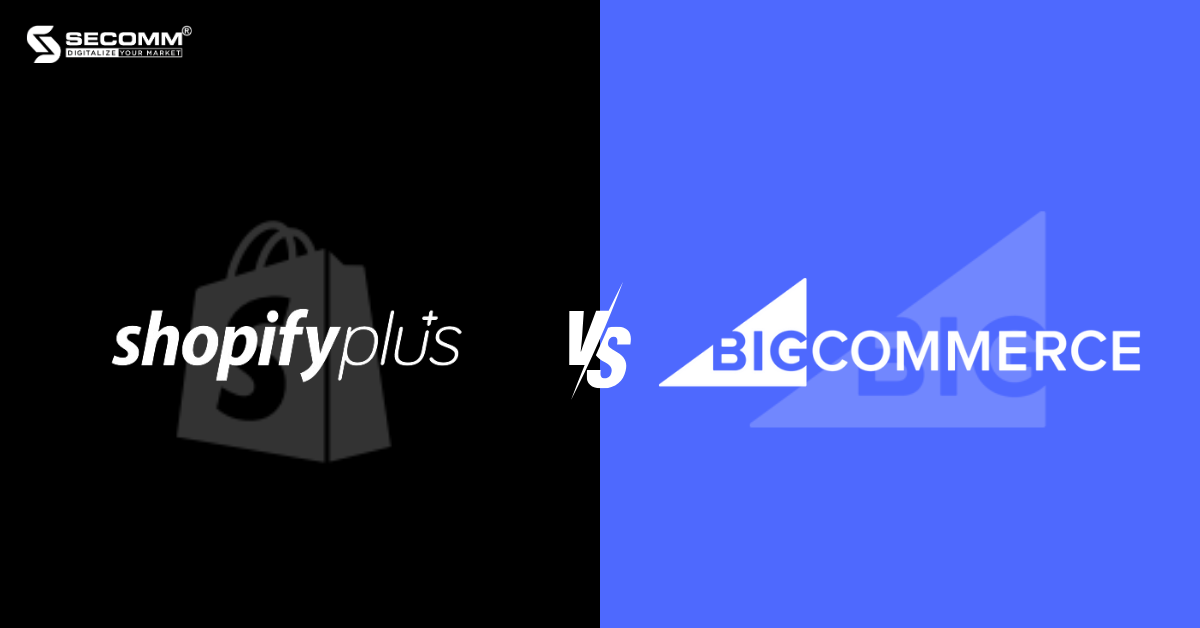
In today’s eCommerce landscape, it isn’t just open-source platforms that can meet the complex development and customization needs of large-scale enterprises, but SaaS platforms are also steadily rising with significant improvements. Among them, two SaaS platforms designed specifically for large enterprises are Shopify Plus and BigCommerce Enterprise.
However, these two platforms have many key differences. This article aims to clarify the pros and cons of each platform and compare the differences between the two platforms to help you — as a business leader — make well-informed decisions.
Learn more: Shopify vs BigCommerce: Which platform is right for you?
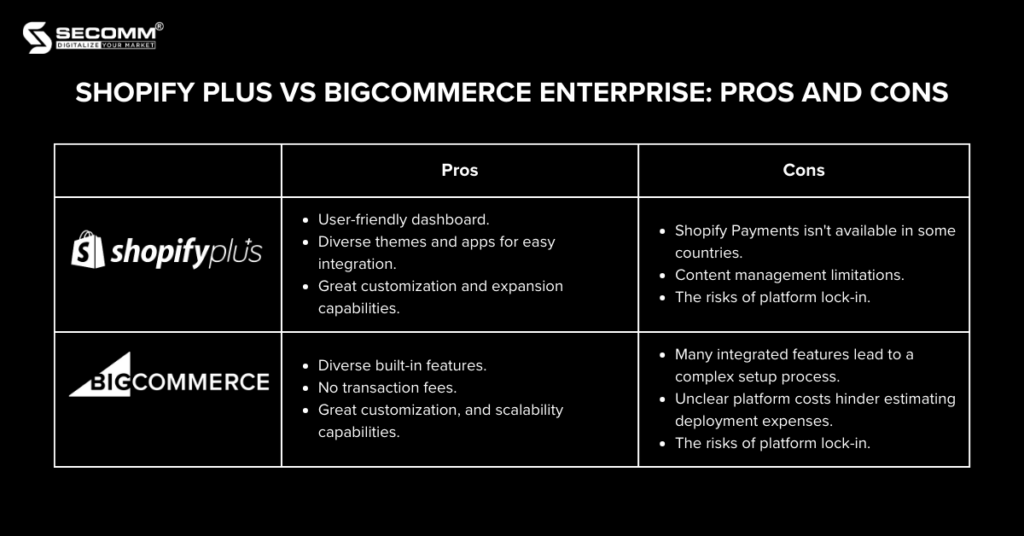
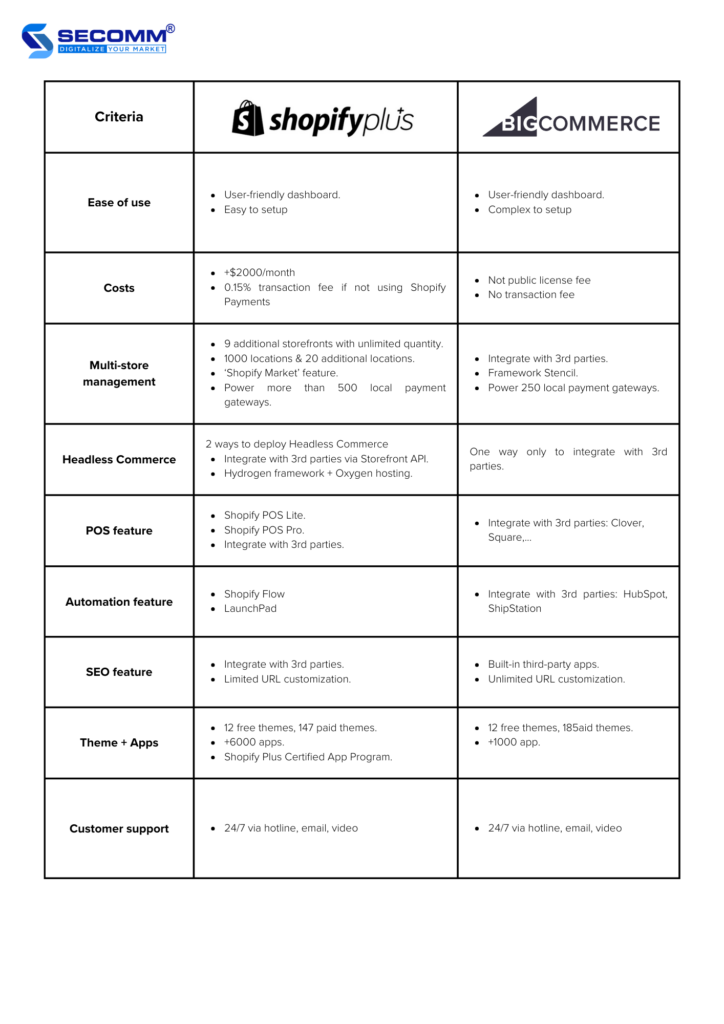
Both platforms are recognized for their user-friendliness compared to open-source platforms. Their intuitive dashboard and user-friendly navigation, along with features like drag-and-drop editing, extensive documentation, and 24/7 support, make them accessible for users of varying technical expertise.
However, Shopify, known for its inherent user-friendly design, ensures that users, whether using the Plus version or the regular ones, can easily explore and set up their eCommerce website with efficiency.
Both these two premium solution platforms — which are Shopify Plus and BigCommerce Enterprise — cater to the deployment needs of large enterprises, these platforms offer advanced features and technologies that require some learning.
For example, the ‘Plus’ users need to grasp the Liquid template language, while those opting for the ‘Enterprise’ may benefit from understanding the Google Cloud Platform for optimizing website performance.
BigCommerce, renowned for its built-in features, continues this trend with the ‘Enterprise’ version. Some features may suit specific businesses but might be unnecessary for others. While BigCommerce allows flexibility for customizing and configuring these advanced features, it can introduce complexity and intricacy into the setup process.
Similarly to other premium solutions on SaaS platforms, the license fee will depend on the deployment requirements and the current scale of the business. BigCommerce doesn’t disclose the fee publicly, requiring businesses to directly contact the platform for tailored consultation and pricing.
On the other hand, Shopify Plus has a license fee starting at $2000 per month. Once you reach a monthly revenue threshold of $800,000, the platform fee becomes revenue-based, amounting to 0.25% of monthly revenue, capped at $40,000 per month or $480,000 per year.
Considering transaction fees is also important. While BigCommerce doesn’t charge transaction fees, Shopify Plus charges a 0.15% transaction fee for not using Shopify Payments.
To estimate deployment costs effectively, you should partner with development agencies and engage in detailed consultations with BigCommerce or Shopify for comprehensive guidance.
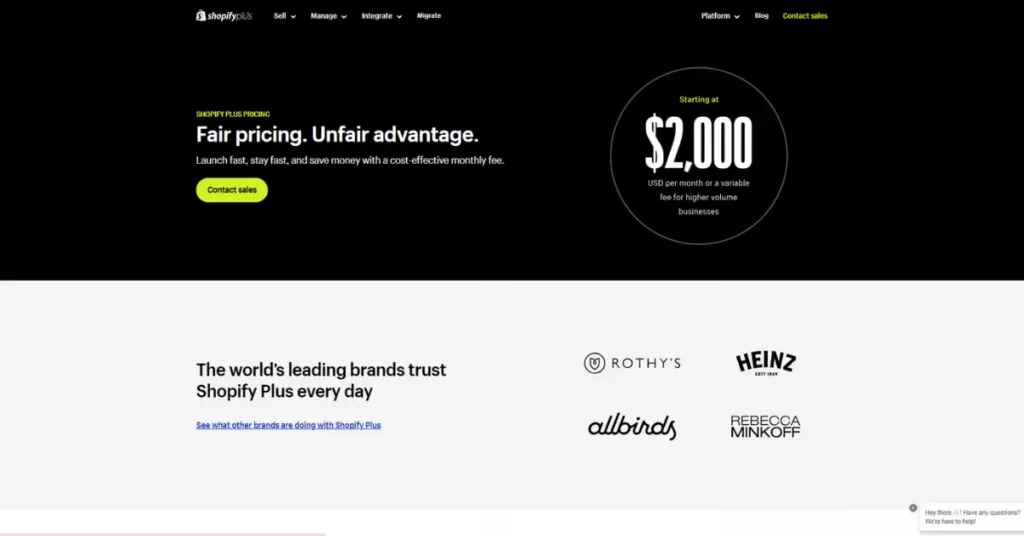
For large enterprises, the multi-store management feature is crucial and a primary consideration when selecting an eCommerce platform to sell globally. To engage in sales across various markets worldwide, your eCommerce website needs to be crafted to suit the preferences of each target audience in different markets.
This involves addressing issues related to language conversion, currency units, and payment methods with flexibility. Moreover, stores should be administered efficiently in a centralized manner rather than separately.
Shopify Plus allows you to create up to 9 additional storefronts alongside the main storefront at 1000 different inventory locations and 20 additional inventory locations. All these storefronts can be centrally managed through a single dashboard.
Plus, the Shopify Market feature will help you select the markets you want to sell in. The system will then automatically convert and manage multiple languages, currency units, shipping options, and payment methods based on the user’s IP address. Currently, Shopify Plus supports a range of local payment gateways, and you can refer to the provided list.
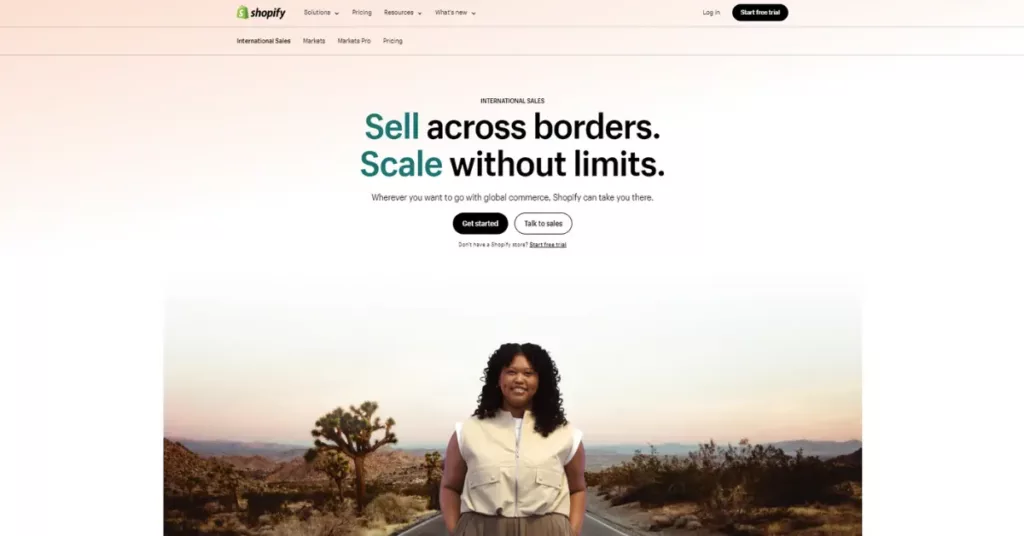
BigCommerce Enterprise doesn’t provide many solutions or features for global selling. Instead, it allows you to deploy multiple stores within the platform and then integrate with 3rd-party PIM solutions to manage data across these stores.
Another option is to leverage the BigCommerce Stencil framework to tailor content language for each local market. Also, the Enterprise version supports multi-currency payments through more than 250 local payment gateways.
The demand for adopting Headless eCommerce is on the rise, especially among large enterprises seeking to deliver a seamless and optimized experience for their customers. Both Shopify Plus and BigCommerce Enterprise offer effective solutions for going Headless.
BigCommerce Enterprise allows you to integrate with various frameworks (Next.js, Gatsby.js, Nuxt.js), APIs (REST, GraphQL), and your preferred or previously used tools.
When using Shopify Plus, there are three approaches. You can use the Storefront API to connect and develop with your preferred frameworks, hosting solutions, and tools. Or, you can leverage Shopify Hydrogen framework and Oxygen hosting to facilitate a headless eCommerce website flexibly.
Just like their regular pricing plans, both the ‘Enterprise’ and the ‘Plus’ include Point of Sale (POS) features for eCommerce transactions, catering to both online and offline stores, as well as Omnichannel operations.
POS can be configured on various devices like mobile devices (tablets, smartphones), and other hardware like cash registers and barcode scanners.
BigCommerce Enterprise offers smooth integration with third-party POS systems like Square, Vend, Clover, and Heartland Retail. It’s good for those who already using POS software from these third-party providers.
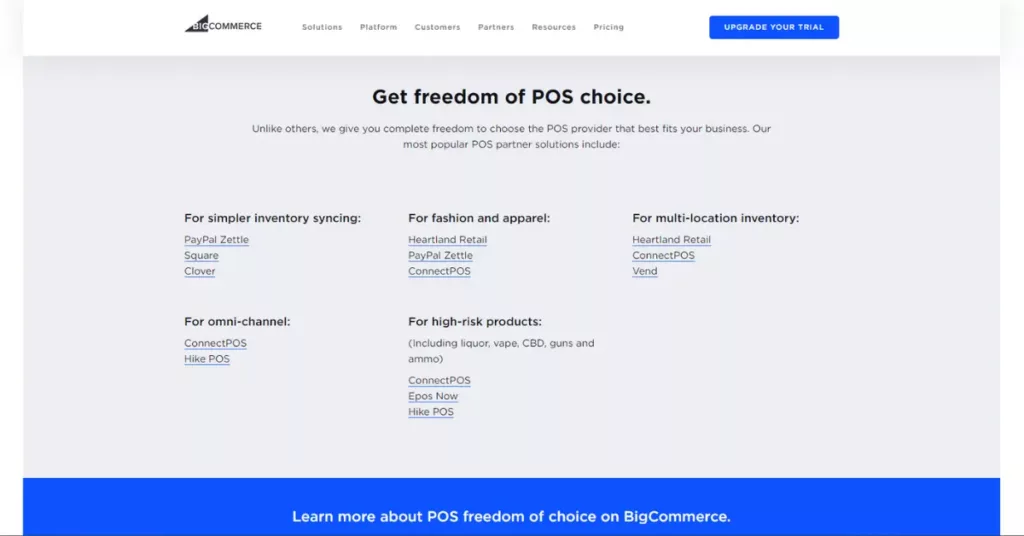
For Shopify Plus, beyond the option to integrate with third-party POS systems like BigCommerce Enterprise (Clover, Square, Zend), Shopify offers its own Shopify POS solution, available in two plans:

Both ‘Plus’ and ‘Enterprise’ offer tools and solutions to help you automate your eCommerce website operations.
Shopify Plus offers an exclusive solution, Shopify Flow, and LaunchPad, allowing you to automate routine tasks and set up automated workflows for tasks like email marketing campaigns or new product launches.
On the other hand, BigCommerce Enterprise takes a different automation approach which enables you to smoothly integrate with 3rd-party apps. Some of them are HubSpot, Avalara, ShipStation, etc.
SEO plays a crucial role in improving the search visibility of an eCommerce site and attracting potential customers. Both platforms offer features to enhance SEO efforts.
The ‘Plus’ stands out for its user-friendly interface and an integrated app ecosystem that can enhance SEO, incorporating tools such as Google Search Console and Analytics. However, it comes with limitations in URL control and customization.
The ‘Enterprise’, on the other hand, provides more versatile SEO capabilities, including complete control over URLs and integration with applications like Google Search Console and Analytics. It makes the process more intricate compared to Shopify Plus, involving additional setup operations.
Shopify Plus offers businesses approximately 12 free themes and 147 paid themes, with prices ranging from $150 to $380 per theme. On the other hand, BigCommerce Enterprise provides around 12 free themes and 185 paid themes, with prices ranging from $150 to $400 per theme.
Both platforms offer a wide range of visually appealing and mobile-friendly theme options. While the ‘Enterprise’ themes are characterized by elegant, tidy, and modern designs with highly customizable features, the ‘Plus’ themes can meet higher requirements for user experience, making navigation easier.
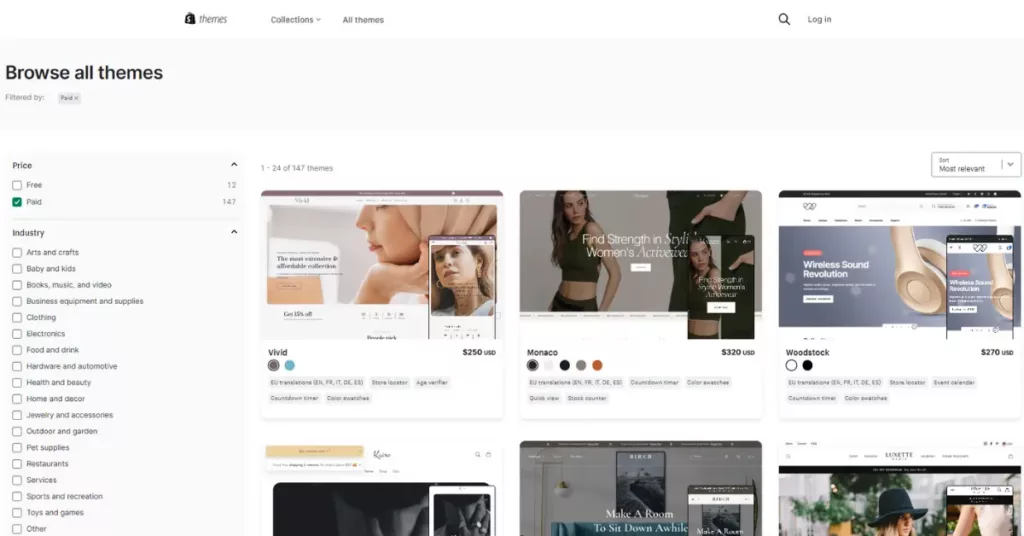
To facilitate efficient eCommerce deployment, the two provide vast app stores and extensions, tailored for ‘Plus’ and ‘Enterprise’ businesses. While both platforms offer free versions, access to comprehensive features requires a modest monthly fee.
Shopify Plus boasts over 6,000 apps and extensions, while BigCommerce Enterprise has around 1,000. This can be explained by Shopify’s widespread popularity among businesses and developers globally, providing them with ample documentation and resources for app and extension development, including the Shopify Plus Certified App Program.
For businesses that are ready to deploy the ‘Plus’ or the ‘Enterprise’ solutions, the demand for technical support and efficient eCommerce website operations is significant.
Both platforms receive high praise for their customer service. They offer 24/7 support via hotline, email, and video available in multiple languages. However, if you need specialized and complex technical support, Shopify Plus may be the preferable choice.
Final Thoughts
In the competitive business landscape, selecting the right platform for launching an eCommerce website is an important decision. Both Shopify Plus and BigCommerce Enterprise offer distinct advantages and cater to various business models.
Regardless of the platform chosen, you should prioritize the development and delivery of an exceptional shopping experience for your customers. eCommerce platforms serve as tools, and the ultimate key to success lies in an effective deployment strategy and great collaboration with a proficient team.
With extensive experience helping numerous businesses deploy diverse eCommerce development projects on both Shopify Plus and BigCommerce Enterprise, SECOMM boasts a team of seasoned experts capable of collaborating to create exceptional eCommerce experiences and help you enhance your brand positioning.
Reach out or directly call the hotline at 028 7108 9908 to explore how SECOMM can contribute to optimizing the potential of Shopify Plus and BigCommerce Enterprise for enduring your business success.
 2
2
 7,196
7,196
 0
0
 1
1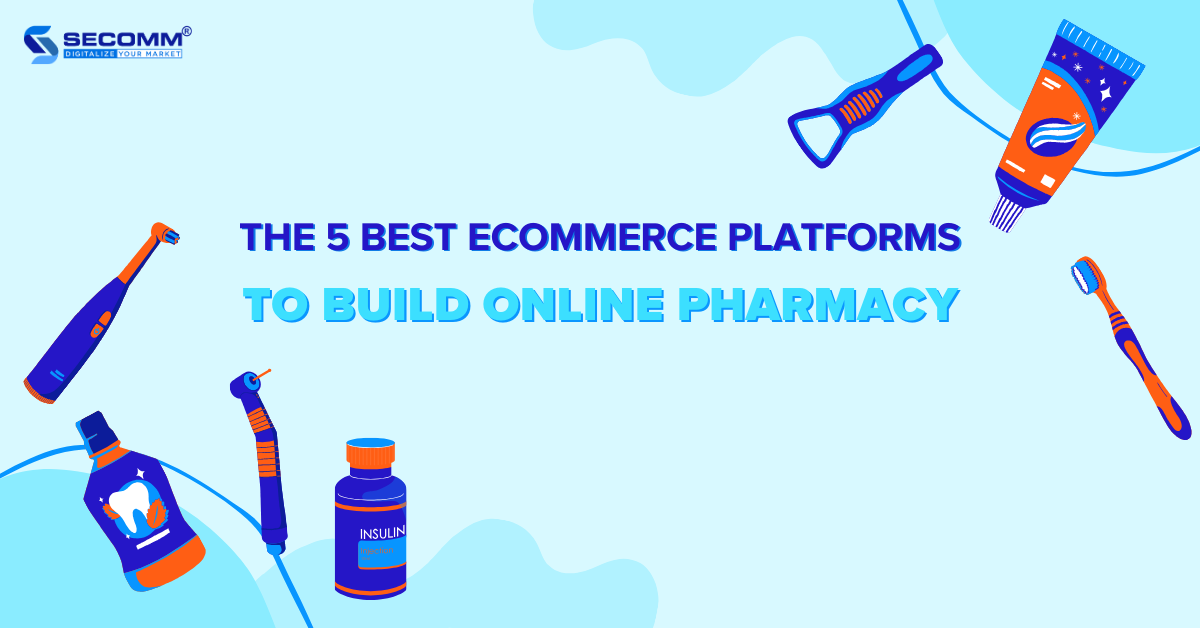
According to The Business Research Company, the global pharmaceutical eCommerce market is projected to reach $732.3 billion by 2027. This represents a significant opportunity for pharmacies, healthcare service providers, or hospitals/clinics to implement eCommerce and reach a broader range of potential customers. To achieve this, building an online pharmacy on a professional platform is a great idea to address industry-specific challenges.
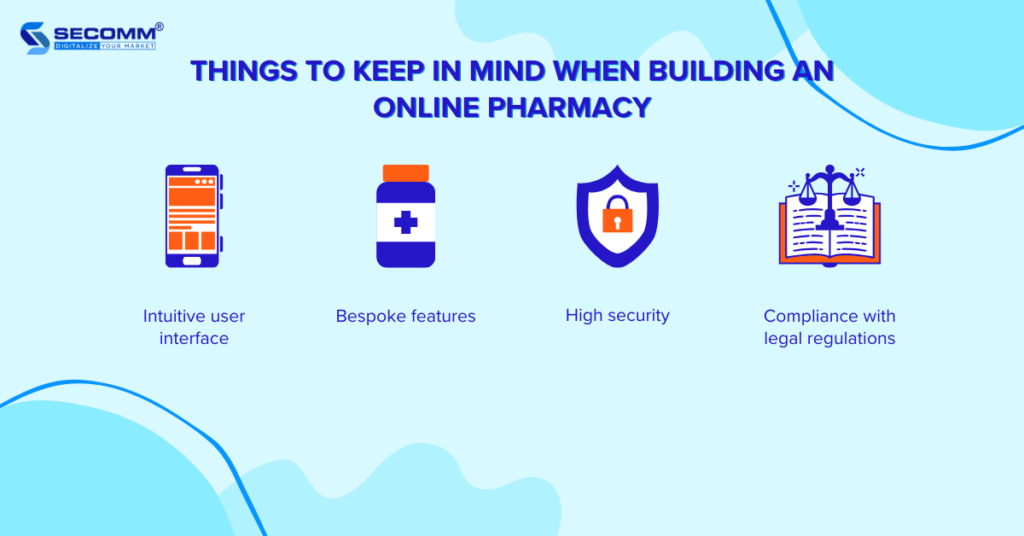
When building a pharmacy eCommerce website, businesses must meet numerous criteria to ensure professionalism, safety, and legal compliance within this industry.
The typical customer profile in the pharmaceutical eCommerce sector consists of individuals seeking to purchase medications, medical equipment, and other healthcare products for themselves, family, or friends.
Thus, the website interface needs to be visually appealing, and user-friendly, and prioritize colors such as blue or white to create a sense of safety and cleanliness.
Other factors, such as layout, font choice, and imagery, should be carefully selected and coordinated to deliver the most professional user experience.
When building an online pharmacy, beyond default eCommerce features, businesses should focus on developing the following features to address industry-specific needs:
An online pharmacy is a system that contains various crucial information including personal details, payment information, and the health status of customers. Therefore, the security system of the website needs to be built and deployed carefully to ensure the safety of customer data.
Pharmaceutical eCommerce is a specialized business area subject to the regulations of the healthcare/pharmaceutical industry. eCommerce pharmaceutical businesses need to comply with these regulations to ensure that their operations are legal and safe for customers.
Below are some key legal regulations that e-commerce pharmaceutical businesses need to adhere to in Vietnam:
In addition, pharmaceutical eCommerce businesses also need to comply with other legal regulations, such as Cybersecurity Law, Consumer Protection Law, and eCommerce Law.
Although this industry has many challenges to deploy, businesses always have eCommerce platforms to create their online pharmacies. Here are the 5 leading platforms for building online pharmacy that businesses may consider.
BigCommerce is a cloud-based eCommerce platform operating on the Software as a Service (SaaS) model, enabling businesses to create and manage online stores.
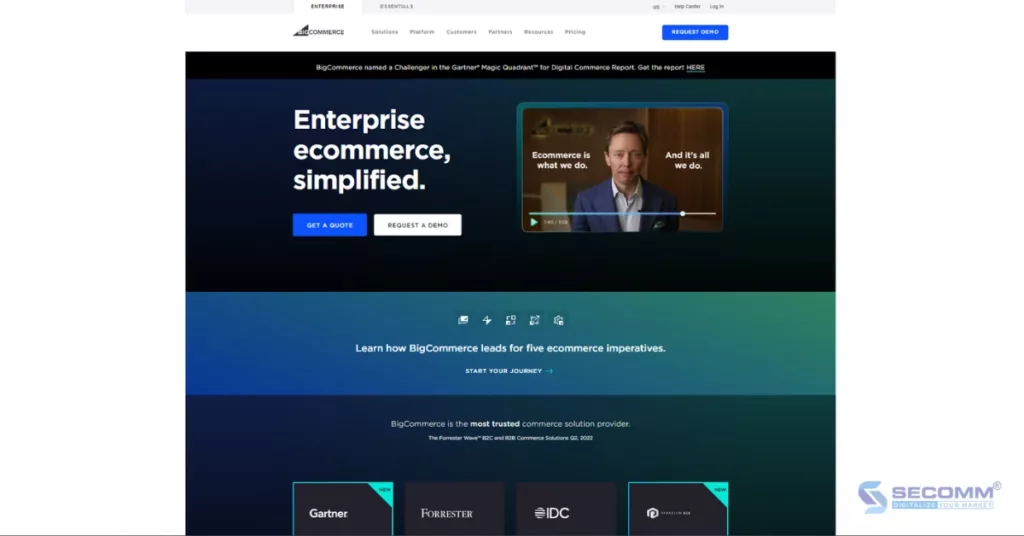
Currently, BigCommerce offers four main solutions, including
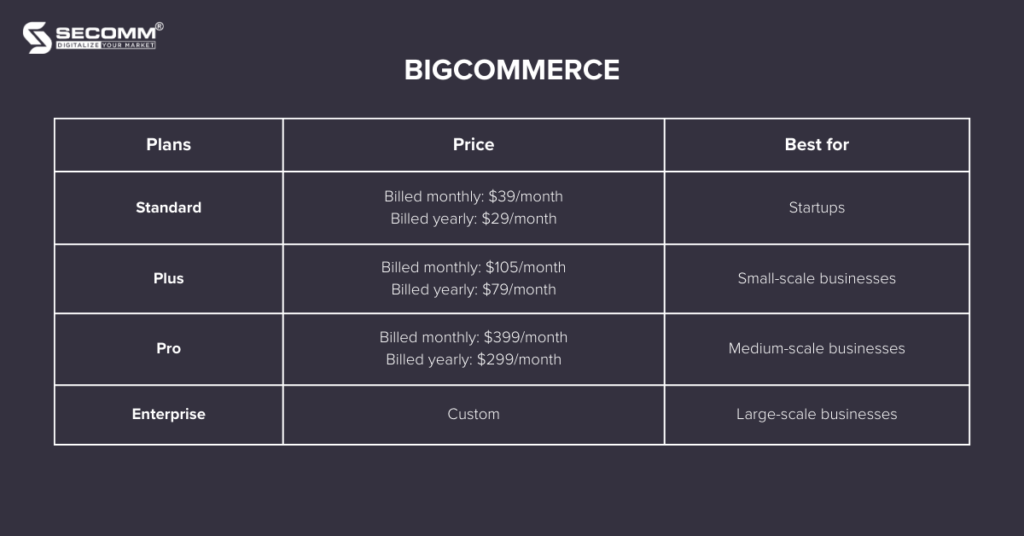
Pros:
Cons:
Some famous pharmaceutical eCommerce businesses currently utilizing BigCommerce include Victoria Health, Molton Brown, LARQ, and Zyppah.
Shopify is a SaaS eCommerce platform established in 2006. To date, Shopify has rapidly become one of the leading platforms in the eCommerce industry, supporting thousands of businesses worldwide to initiate and grow their online ventures.
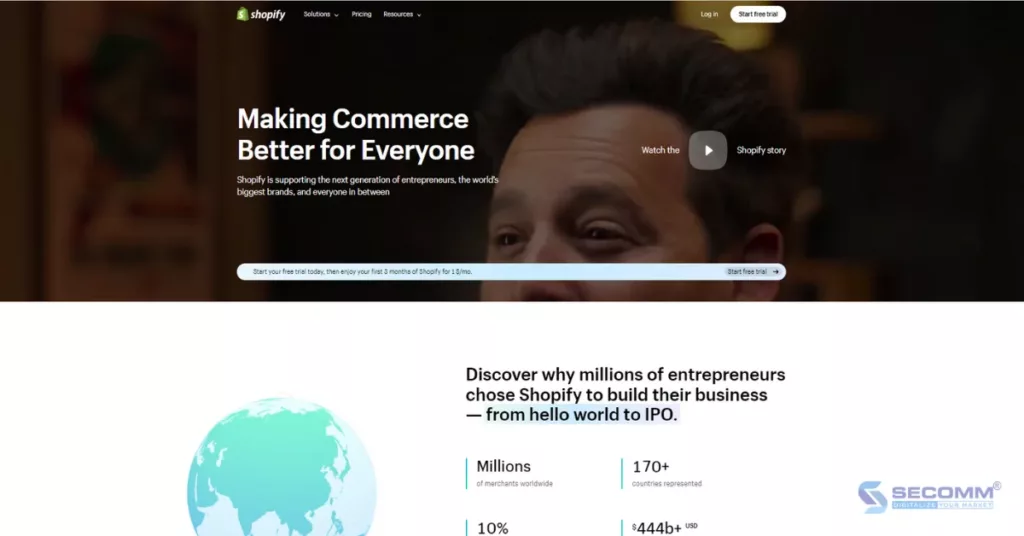
The cost to use the Shopify platform is quite diverse, including these three solutions:
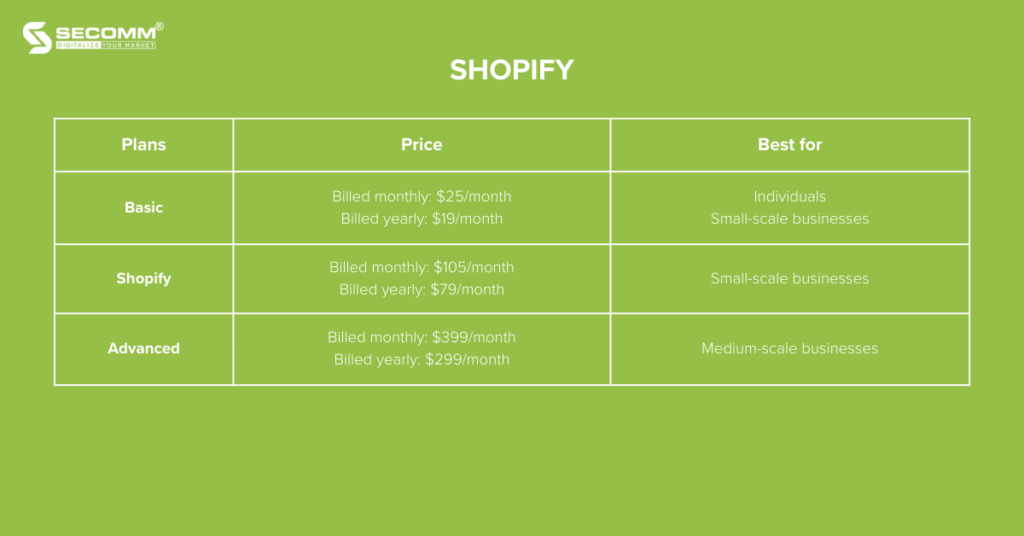
In addition, Shopify provides eCommerce solutions tailored to businesses with different needs and wants, such as:
Learn more: Top 5 benefits of Headless Commerce
Pros:
Cons:
Healthcare, pharmaceutical, and medical businesses using Shopify include Dr.Axe, 310 Nutrition, Hiya, and BUBS Naturals.
StoreHippo is a SaaS eCommerce platform established in 2014 in India. Over the years, this platform has consistently updated its technologies to meet the website-building needs of businesses, particularly those in the pharmaceutical eCommerce sector.
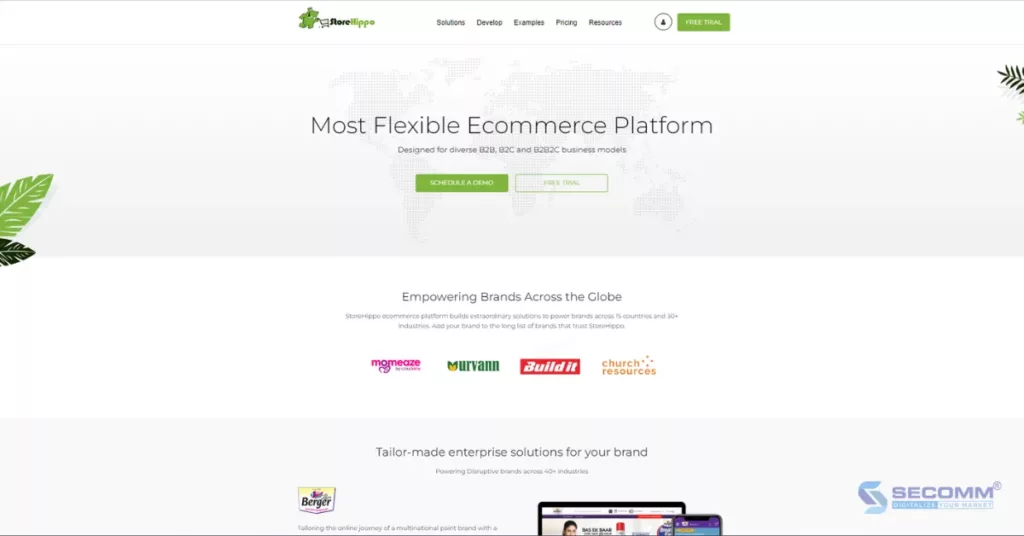
Similar to other SaaS platforms, StoreHippo offers a variety of solutions to choose from:
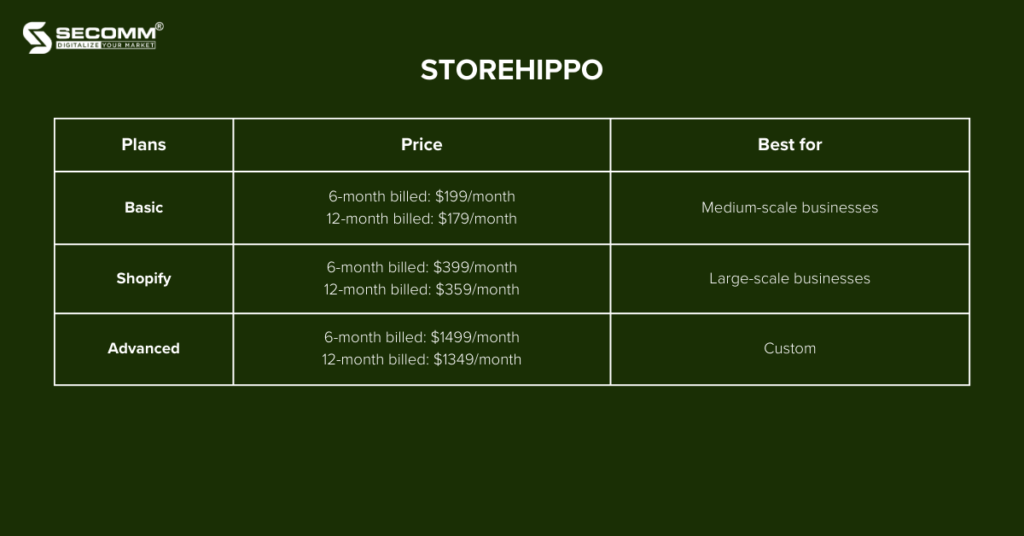
Pros:
Cons:
Some brands that built their online pharmacy with StoreHippo include WoundProfessional, Kunooz, and On A Healthy Note.
WooCommerce is an open-source eCommerce plugin developed for the WordPress platform, one of the most popular content management systems (CMS) globally. WooCommerce enables businesses to turn their WordPress websites into online stores or integrate eCommerce features into existing websites.
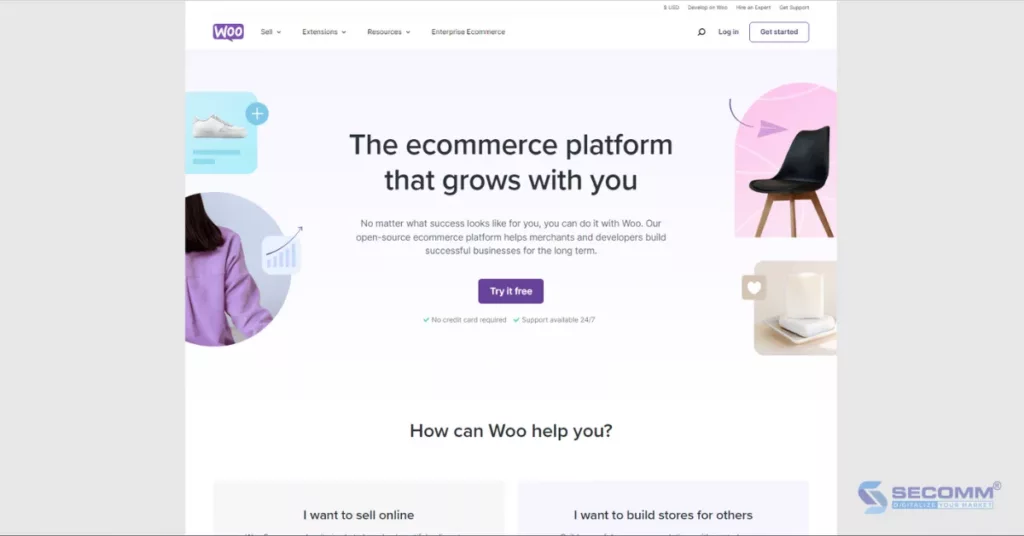
The license fee of WooCommerce depends on the complexity of each project, averaging around $1,000 for a basic eCommerce website and $10,000 for a more advanced eCommerce website.
Pros:
Cons:
Brands using WooCommerce to build online pharmacy include Dr. Scholl’s, myLAB Box, Superdrug Health Clinics, and Apothecanna.
Adobe Commerce, formerly known as Magento Commerce, is a professional and widely used eCommerce system. Adobe Commerce is part of the Adobe Experience Cloud product line and is designed to assist businesses in building eCommerce websites.
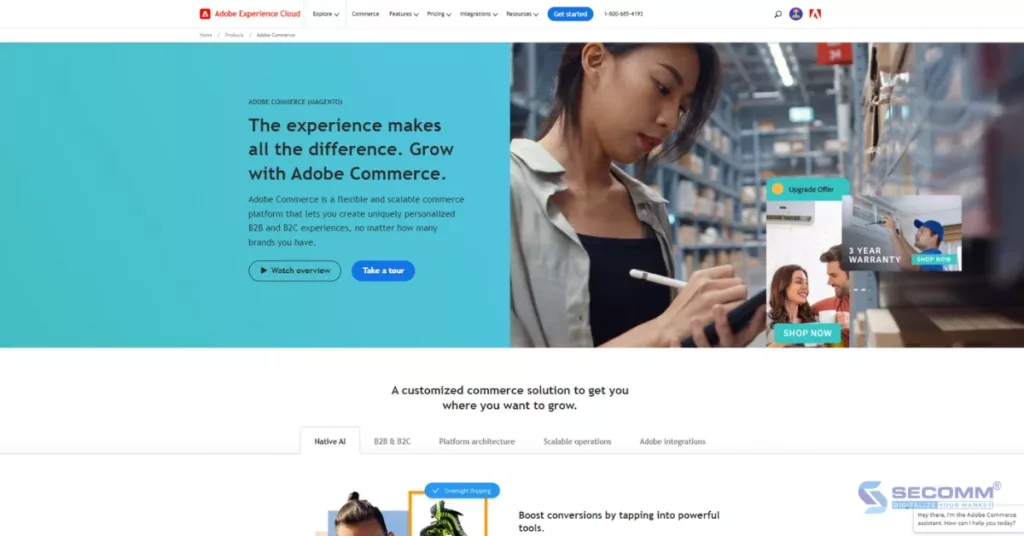
Currently, Adobe Commerce provides businesses with two main versions:
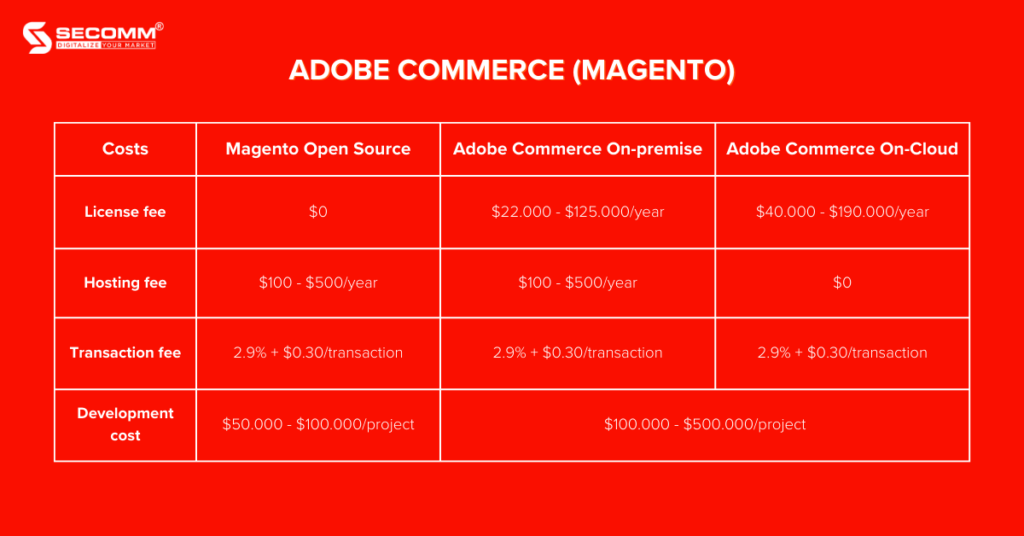
Pros:
Cons:
This list is just a few examples for businesses to reference; there are many other robust eCommerce platforms that businesses can consider based on specific needs and available resources.
With extensive experience in implementing eCommerce for clients in various countries, SECOMM understands the challenges and difficulties businesses face during the deployment of pharmaceutical eCommerce.
Contact SECOMM now or call the hotline at 02871089908 today for a free consultation.
 2
2
 8,833
8,833
 0
0
 1
1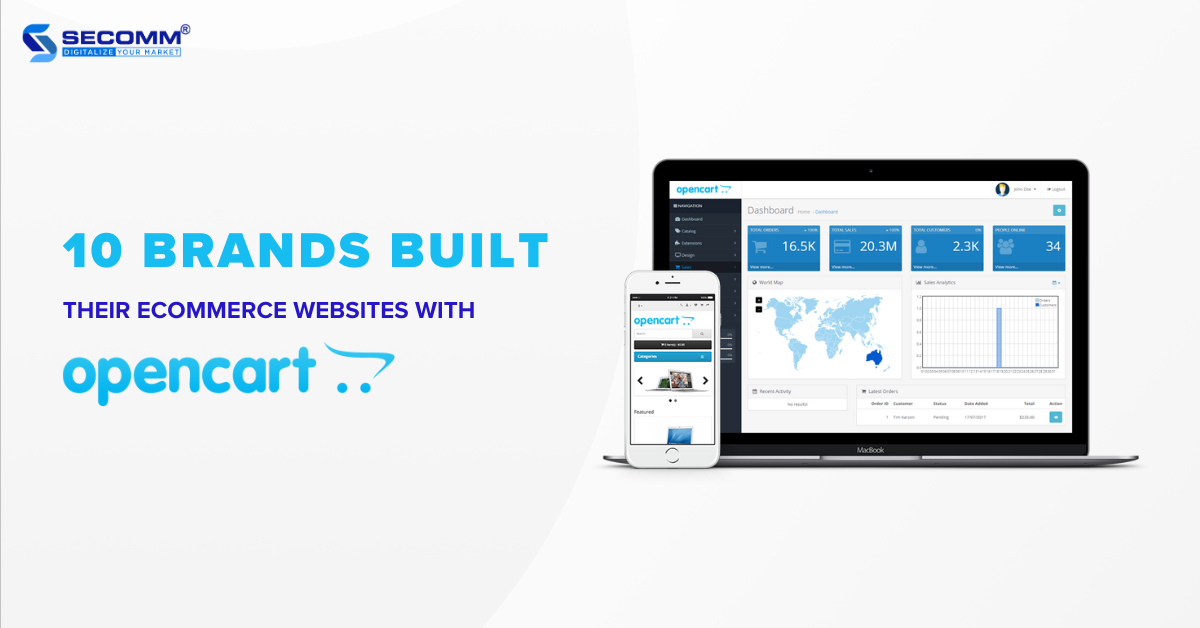
OpenCart is an open-source eCommerce platform based on the PHP programming language, utilizing the MySQL database and HTML components to build eCommerce websites. According to Builtwith, the platform powers over 2,500 websites, with the majority in the United States and Russia.
OpenCart offers businesses various options for building eCommerce websites: Free (Open Source) and Cloud Store (Paid). Due to the flexibility of open-source code, many businesses choose this platform to meet specialized requirements in website development.
Below are some brands that have used OpenCart to create dedicated eCommerce websites
Bensound is the brainchild of musician Benjamin Tissot, founded in 2012. It is an eCommerce website specializing in providing free and licensed music, as well as sound effects. Initially, Benjamin Tissot composed and licensed only his songs on this platform.
However, as the service grew, Benjamin Tissot started accepting musical works from other artists, making it an ideal destination for content creators on platforms like YouTube, Facebook, and Instagram.
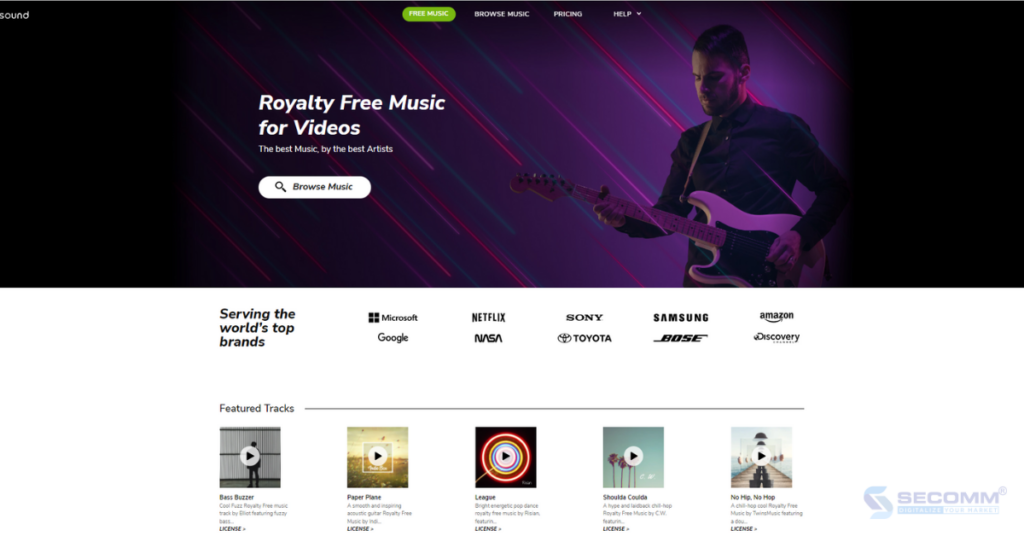
Vicrez is an online automotive parts retailer established in 2014 in the city of Whittier, Southern California, USA. What sets Vicrez apart is that customers can shop online for any external car parts and accessories to customize their vehicles according to their individual preferences.
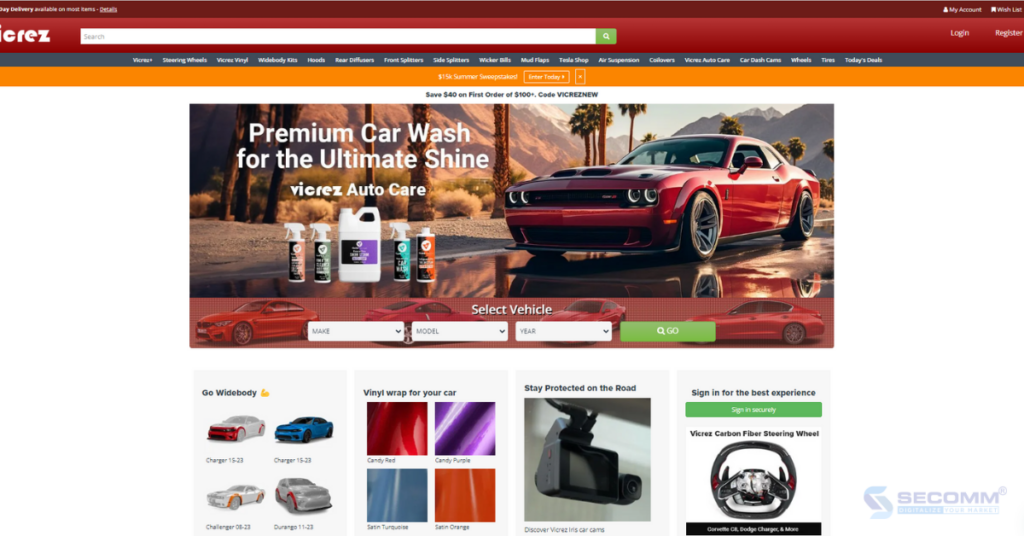
Pharmacy Direct is the first online pharmacy to follow the eCommerce model, owned and operated by pharmacists in Australia since 1996. Initially, the brand operated on a small scale, serving local customers. However, as the demand for health products in Australia steadily increased, Pharmacy Direct experienced remarkable growth.
The business invested more in its eCommerce website to offer over 17,000 products, including vitamins, supplements, beauty products, fragrances, childcare products, prescription medications, and over-the-counter medicines from reputable pharmaceutical brands. This expansion allowed Pharmacy Direct to provide online services to the Australian population.
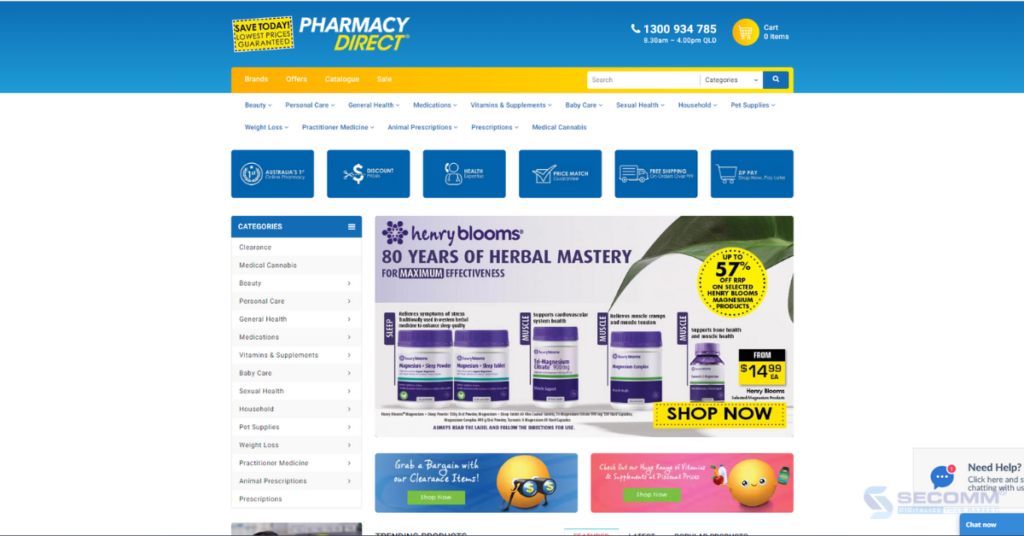
Get Laid Beds is a business specializing in handcrafting solid wood beds, founded in 2012 by John and Jean, a pair of architect and carpenter friends.
After more than 10 years of development, Get Laid Beds has expanded its product lines to include bedroom furniture, focusing on building its eCommerce website and enhancing customer service. This brand has gained popularity among customers in the UK and the US.
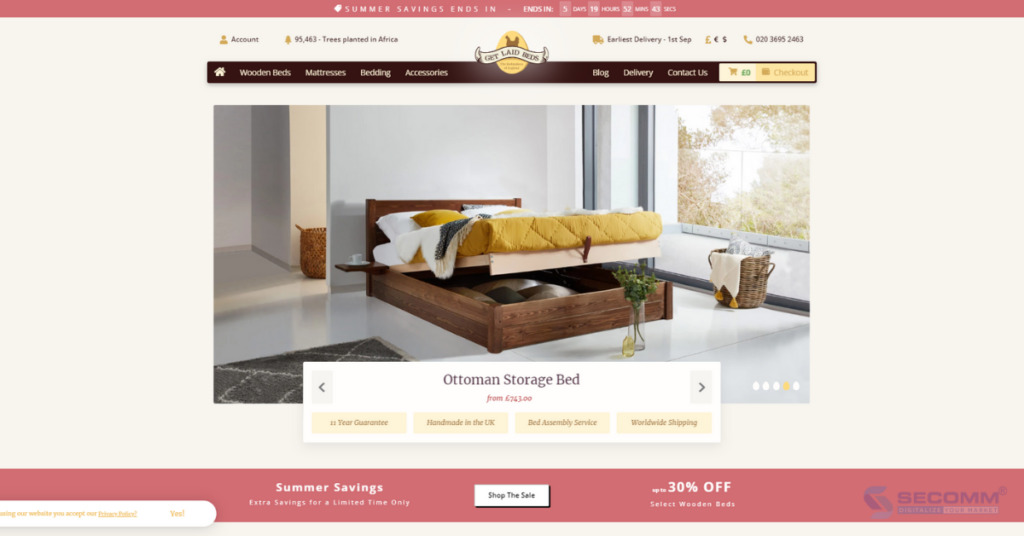
Self Edge is a men’s fashion brand with a vintage style, established in 2006 by the American couple Kiya and Demitra Babzani. Currently, Self Edge has a presence in major cities such as San Francisco, New York, Los Angeles, Portland, and San Jose del Cabo.
Additionally, Self Edge focuses on developing its eCommerce website to reach new customers across the United States and Mexico.

BNA Model World is a model business established in 2007 in Australia. Since its establishment, the brand’s management has focused on the eCommerce market and gradually upgraded its products/services. Currently, BNA Model World offers over 100,000 products from more than 1,000 manufacturers, serving over 104,000 customers worldwide.
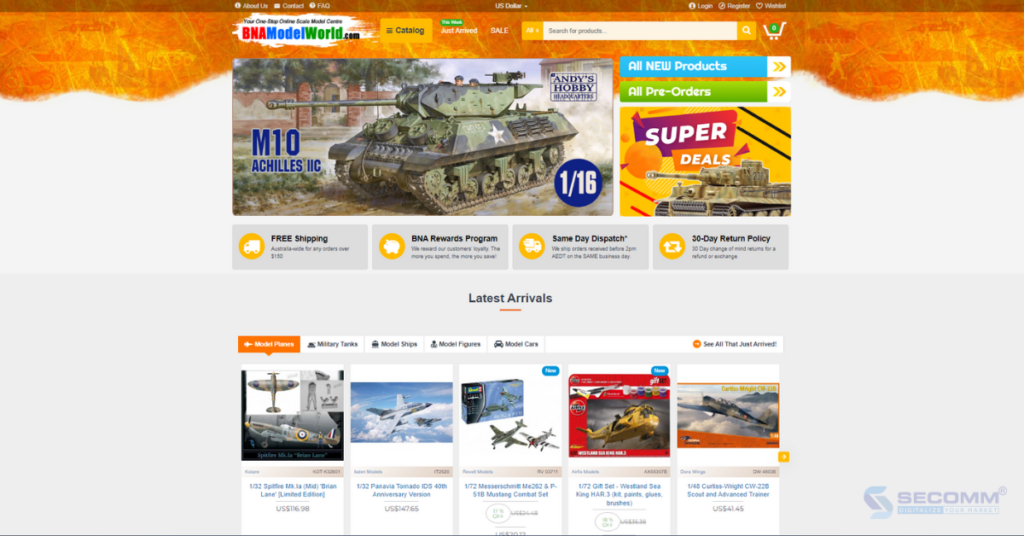
Godukkan is a consumer electronics retail business established in 2017 and headquartered in Dubai, United Arab Emirates (UAE). Godukkan’s main goal is to become the number one eCommerce website in the UAE, offering a wide range of products, including laptops, mobile phones, tablets, PCs, gaming equipment, and more.
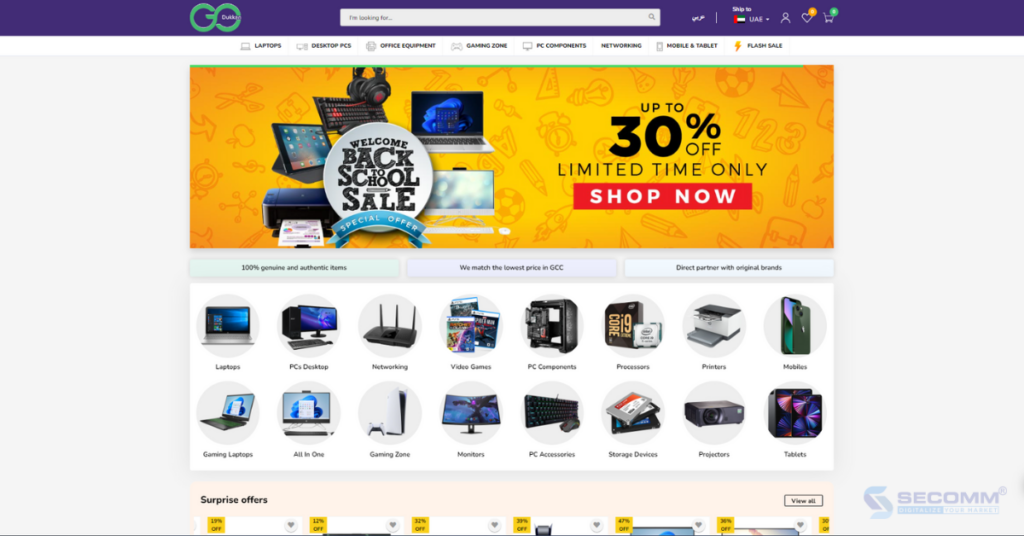
Get Er Brewed is a beverage brand specializing in brewing beer, wine, tea, etc., as well as supplying fermentation ingredients and brewing equipment. The business was established in 2013 and is based in Northern Ireland.
In recent years, Get Er Brewed has expanded its reach by launching an OpenCart website to cater to an international customer base, achieving certain successes, particularly in securing contracts for the installation of fermentation and brewing systems.
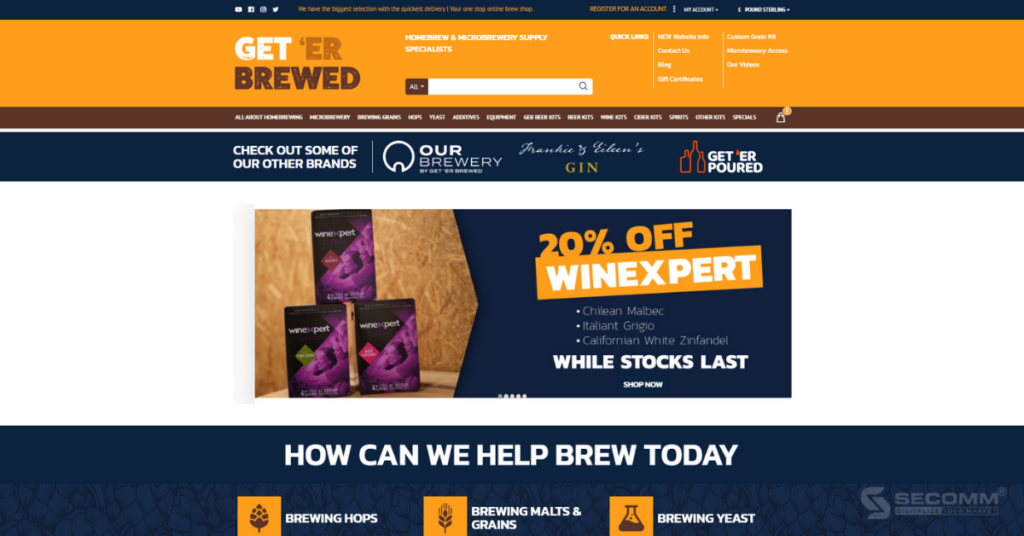
With over 20 years of experience in the pet industry, brothers Raymond and Roger decided to establish CatSmart, the largest cat-centric brand in Singapore. Currently, CatSmart is actively investing in its OpenCart website and expanding its presence beyond traditional retail branches in the “Lion City.”
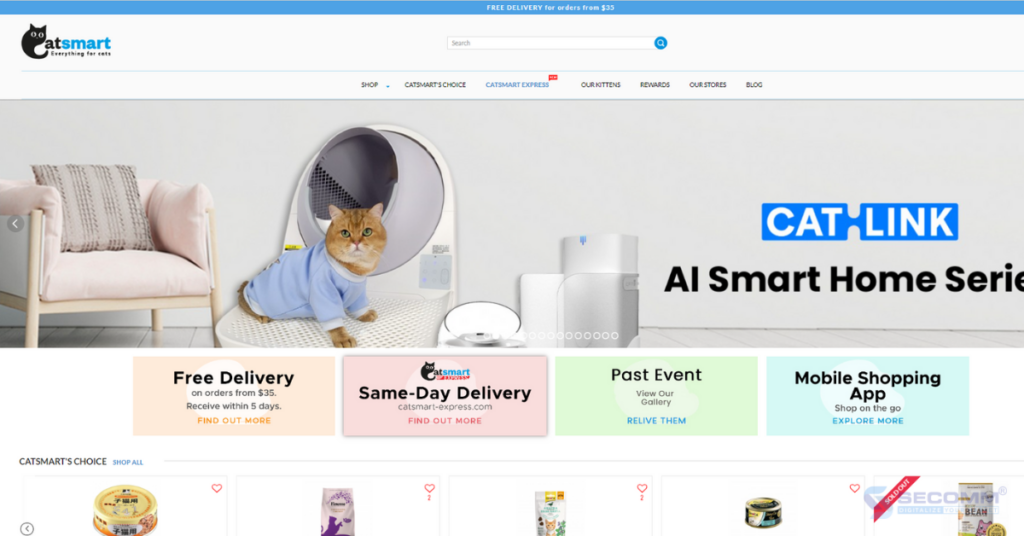
Derails is a business specializing in designing and selling model trains, established in 2010. With the boom of eCommerce, Derails began building an OpenCart website to adapt to the changing market.
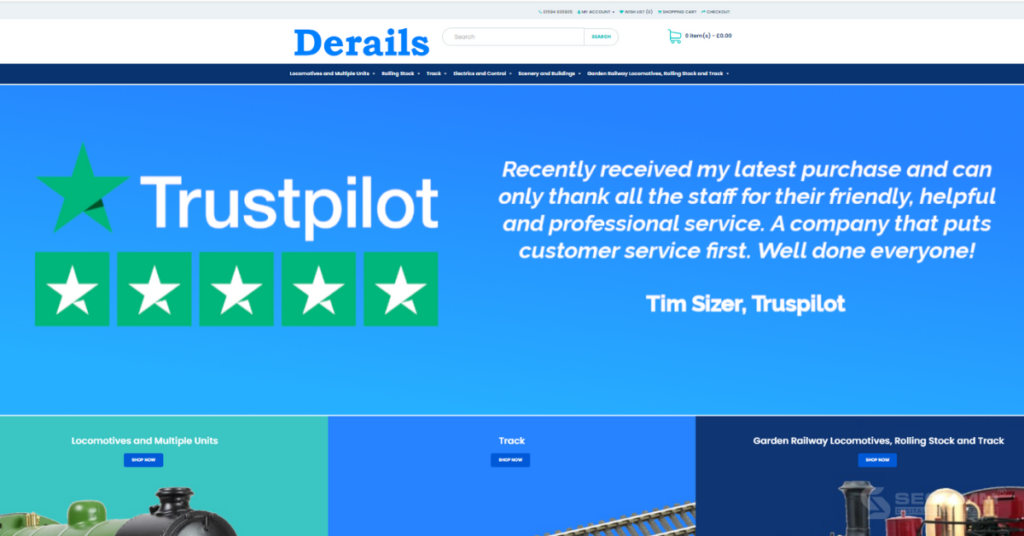
The Bottom Line
Here are 10 brands that have developed OpenCart websites and achieved success in both branding and revenue. This success serves as inspiration for other businesses seeking solutions to break through their operations and enhance competitiveness in the market.
Learn more: OpenCart vs Magento: Which Fits Your Business Best?
With extensive experience in deploying eCommerce for clients in many countries, SECOMM understands the difficulties and challenges that businesses face during implementation.
Contact SECOMM now or call the hotline at 02871089908 today for a free consultation.
 2
2
 10,635
10,635
 0
0
 1
1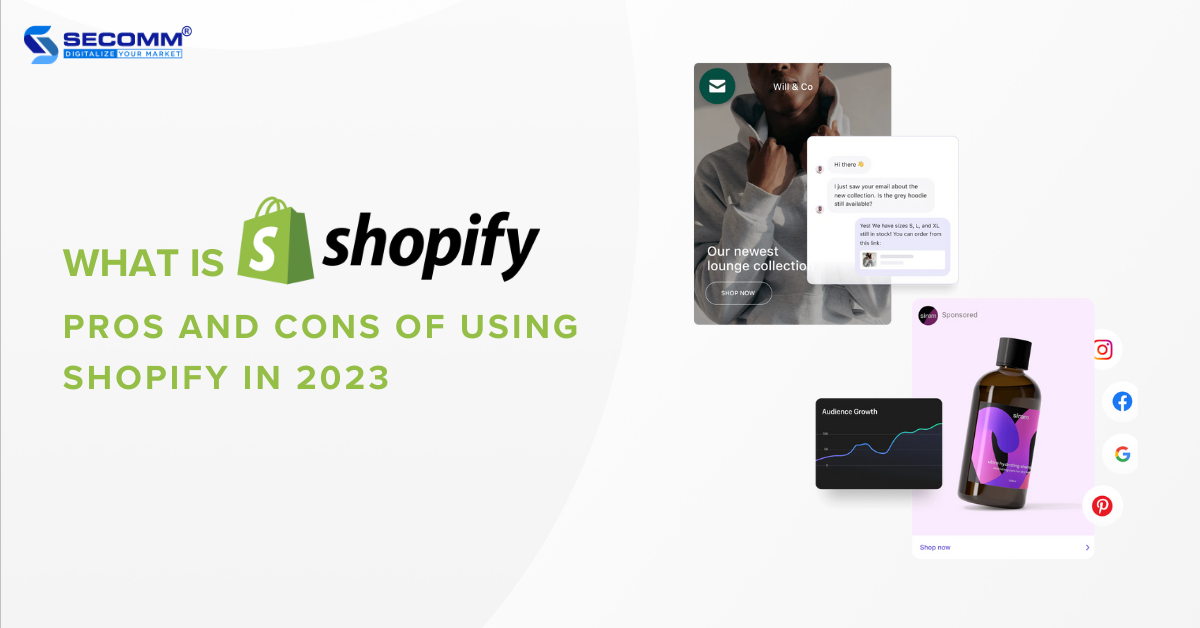
The eCommerce world is growing, and the significance of building and developing eCommerce websites has never been more crucial. Among the popular SaaS platforms, Shopify stands out as a name that commands attention.
Shopify is a SaaS platform and an outstanding solution that helps thousands worldwide turn their online business ideas into reality.
So, what is it? Why it is the top choice for eCommerce businesses, ranging from small-scale to large-scale operations. Let’s explore the power of Shopify in this article.
Shopify is a widely used eCommerce platform that allows businesses to build, develop, and manage their online store. With its user-friendly interface, even those with limited technical expertise can effortlessly navigate it easily.
Shopify operates as a Software as a Service (SaaS), requiring businesses to pay a monthly fee for usage and adhere to the platform’s regulations. However, the platform manages hosting and takes responsibility for technical issues, ensuring the security and efficient operation of the business’s eCommerce website.
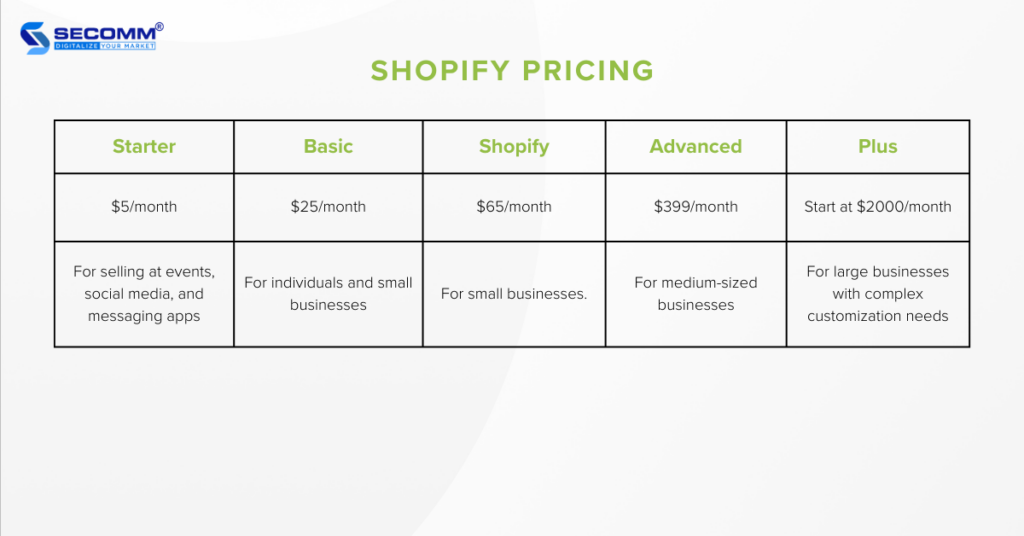
Until now, businesses have been familiar with 5 main solutions: Starter, Basic, Shopify, Advanced, and Plus. Recently, the platform introduced a new advanced solution called Commerce Components. This solution allows businesses to use the platform as a modular service, paying only for the features they need. It’s worth noting that this new solution is currently exclusive to the U.S. market.
For the Basic, Shopify, Advanced, and Plus plans, transaction fees are waived when businesses use Shopify Payments. However, in reality, this payment method isn’t available for all countries. Currently, it only supports countries in this list.
Conversely, transaction fees will apply at rates of 2%, 1%, 0.5%, and 0.15%, respectively. For the Starter plan, whether or not using it, transaction fees still apply and are relatively high at 5%.
Plus businesses using this payment method will enjoy no transaction fees. However, this exemption doesn’t apply to businesses in Austria, Belgium, and Sweden, even though these countries are included in the list.
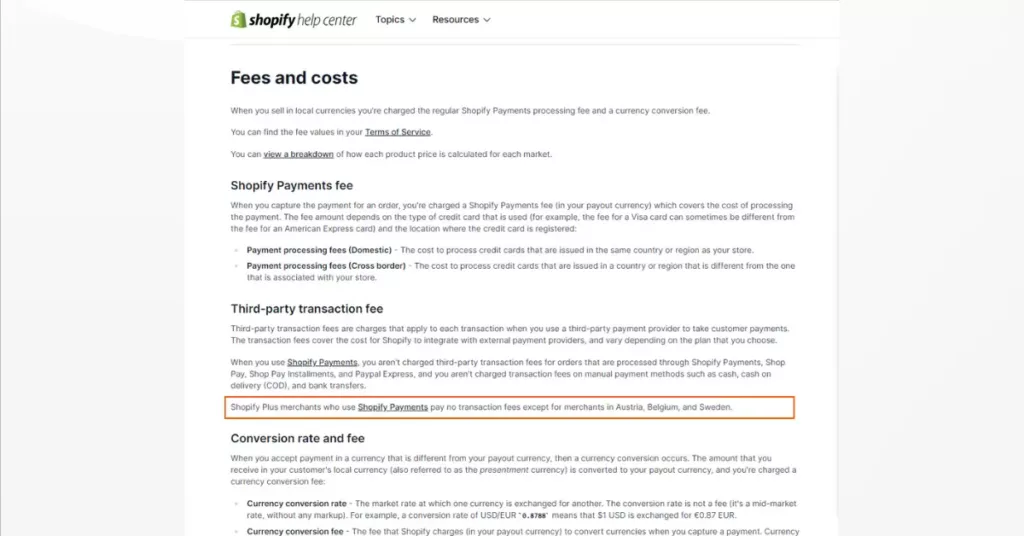
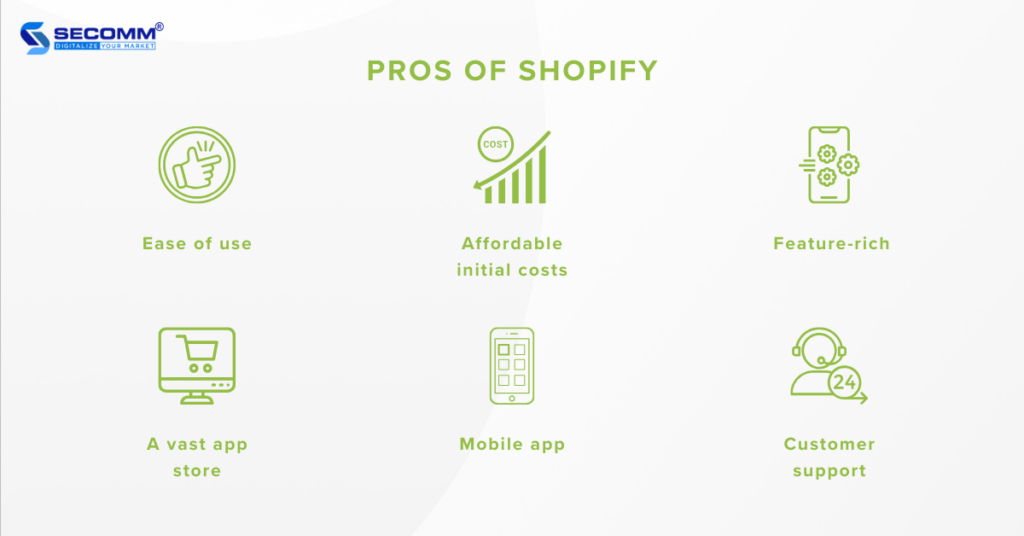
The platform is designed with an intuitive interface, allowing users with limited technical expertise to navigate it effortlessly. The platform offers a drag-and-drop editor, enabling businesses to easily add or remove products and make quick customizations.
Businesses also have the flexibility to customize layouts, colors, fonts, and font sizes, and add or remove elements and widgets from both free and premium themes.
Moreover, it offers businesses documentation and tutorial videos, ensuring a seamless and efficient setup and utilization experience.
The platform provides a range of cost-effective solutions suitable for startups and small to medium-sized businesses entering the eCommerce market. However, larger enterprises often prefer the Shopify Plus solution, given its reasonable costs of around $2,000, offering customization and scalability comparable to open-source platforms.
Moreover, as a SaaS platform, businesses pay a monthly fee for using it based on actual Gross Merchandise Volume (GMV), eliminating the need for a substantial one-time payment common with open-source platforms.
This is a versatile eCommerce platform suitable for businesses of all sizes and deployment needs. Whether for individuals, startups, or medium to large enterprises, it can provide features and tailored solutions to meet the specific needs of the business.
Some standout features that the platform brings to businesses include:
Beyond a diverse range of solutions and outstanding features, the platform offers businesses over 6,000 applications and integrations across various categories, from marketing, analytics, and shipping to inventory management and customer care. Each application is designed to address specific challenges and goals in the development of eCommerce.
Most applications and integrations in the App Store are developed by third-party businesses or independent developers. It provides resources, documentation, and tools for developers to create and release their applications on the store. While some apps offer a free version, it often comes with limited features, and businesses need to pay a monthly fee to access the full functionality.
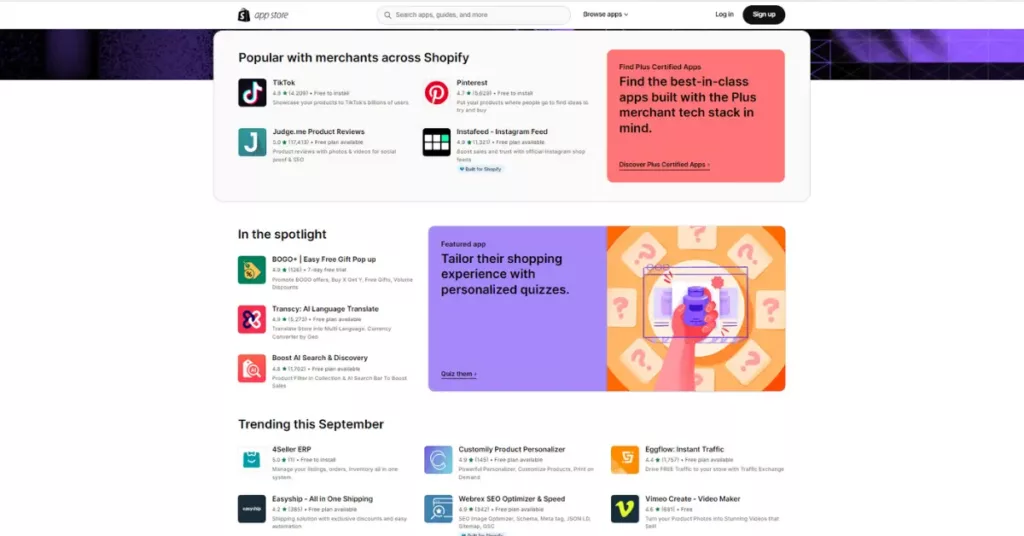
Compared to other SaaS platforms, Shopify provides businesses with up to three mobile applications for effective remote management of eCommerce operations:
The SaaS platform offers 24/7 customer support through chat, hotline, and email to address any customer issues throughout the eCommerce website development process. The level of support is equivalent for both small and large businesses. Moreover, it provides Shopify Experts services to offer businesses in-depth technical support, including web development, web design, marketing, and sales.
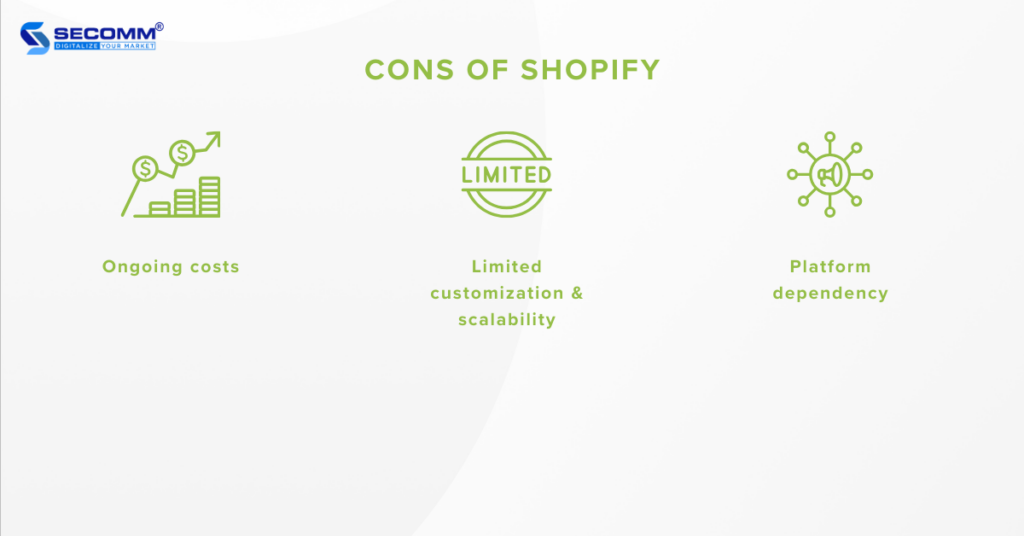
While the fees for using the plans seem reasonable, depending on the need for additional features, apps, or extensions, monthly costs may increase significantly, posing challenges for cash flow management, especially for larger businesses.
While this popular SaaS platform serves as a versatile eCommerce platform, its regular plans come with limitations in terms of customization and scalability. If a business requires a unique design or seeks freedom in designing the website interface, customizing themes on it can be restrictive and may require advanced programming skills.
Moreover, customizing third-party features and apps may add extra costs and dependencies. As an eCommerce website grows and expands, performance may be affected by increased traffic, accompanied by significant cost increases due to transaction fees (if not using Shopify Payments), app fees, and platform fees.
In such cases, the regular pricing plans (Basic, Shopify, Advanced) may not meet the business’s expectations for scalability, and businesses should consider transitioning to the Plus platform for long-term goals.
As a SaaS platform, Shopify has full control over the source code and data within the entire eCommerce website system. This means that all data related to the eCommerce operations will be locked into the platform’s database.
If it declares bankruptcy or ceases operations, all business data on this platform could be lost. However, this risk is highly unlikely. In the second scenario, when a business switches to another eCommerce platform, the exported data is typically provided in the form of a CSV file.
Get started with Shopify today!
When Tobias Lütke transformed Shopify from a snowboard-selling website to an eCommerce platform for businesses, he probably couldn’t have envisioned the significant impact it would have on the global business and technology landscape. The figure of 4.5 million active eCommerce websites is sure to increase substantially in the coming years.
Having accompanied many businesses, both domestically and internationally, in deploying Shopify website, the SECOMM team has accumulated extensive experience in web development and a deep understanding of the platform.
Contact SECOMM or call the hotline at 028 7108 9908 to get started!
 2
2
 7,180
7,180
 0
0
 1
1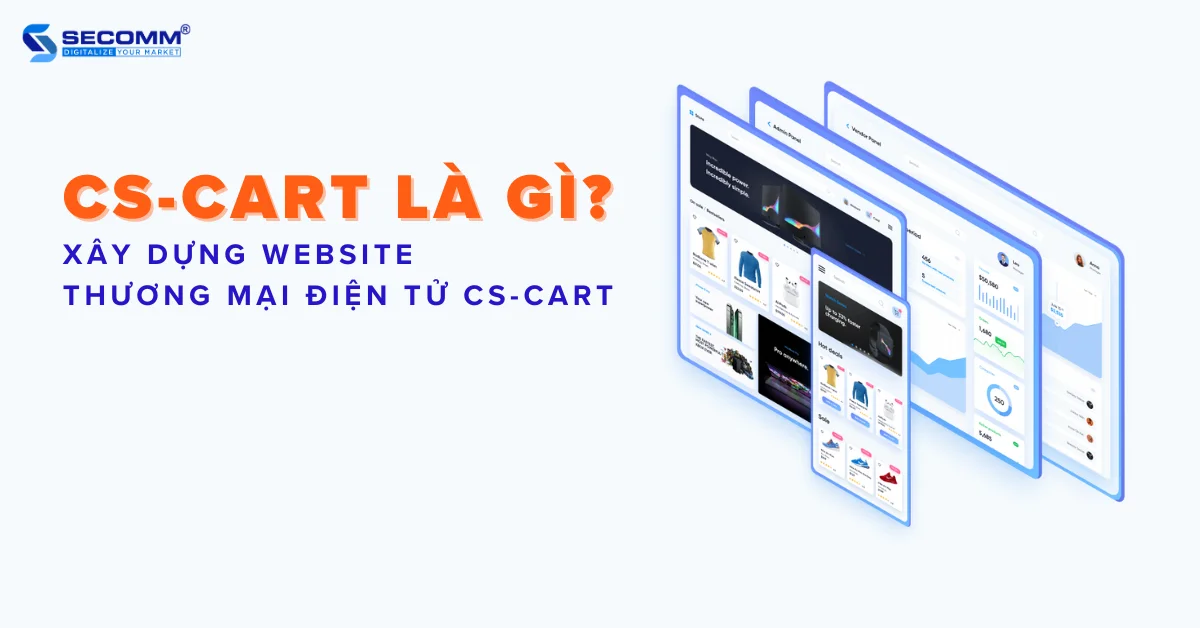
In the era of growing eCommerce, building an eCommerce website has become an essential part of how businesses approach and interact with customers. To successfully build and manage an online store, businesses will need to choose the right eCommerce platform that aligns with their business needs and wants. CS-Cart is one such eCommerce platform chosen by many medium and large-scale businesses.
According to BuiltWith, the platform currently supports approximately 13,232 websites globally, with Russia (about 3,772 websites) and the United States (about 2,809 websites) being the most prevalent markets.
In this article, SECOMM will share insights into what CS-Cart is and the advantages and disadvantages of this eCommerce platform.
CS-Cart is an open-source eCommerce platform that utilizes a SaaS (Software as a Service) model and was developed by Simbirsk Technologies Ltd. Launched for the first time in 2005, CS-Cart has gradually become one of the popular and trusted solutions used by many businesses worldwide.
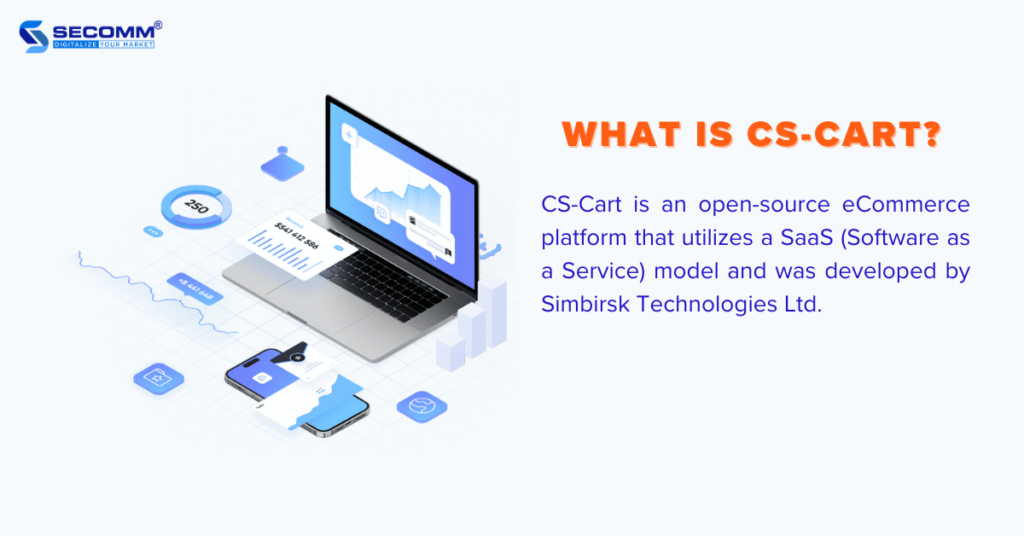
Some eCommerce websites currently using the CS-Cart platform include TechAble (USA), Yumbles (UK), Bakeshop (Australia), ToolBrothers (Germany), Inasbay (Canada), Nguyễn Kim (Vietnam), and more.
Currently, CS-Cart offers two main solutions: No-Code (a no-code e-commerce website builder) and On-Premises (an open-source eCommerce solution for website customization).
No-Code solution pricing:
On-Premises solution pricing:
Moreover, CS-Cart provides a free open-source version for businesses to freely apply for building eCommerce websites.
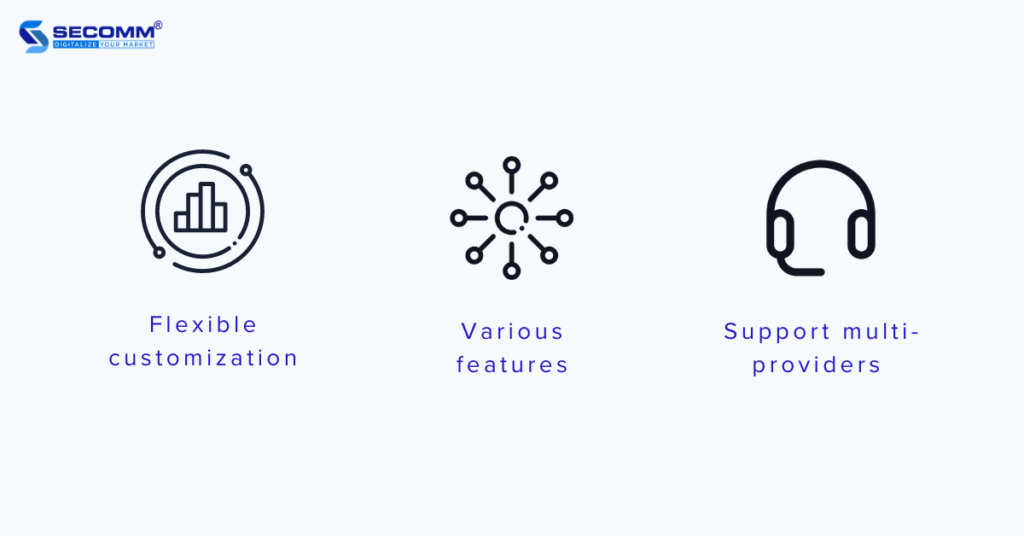
One of the standout features of the CS-Cart platform is its flexibility, supporting businesses of both moderate and large scales in the eCommerce market.
Beyond employing open-source with the PHP language, CS-Cart also implements Headless architecture, allowing businesses extensive customization capabilities. This flexibility empowers businesses to create eCommerce websites tailored to their specific needs, delivering a unique and memorable shopping experience for customers.
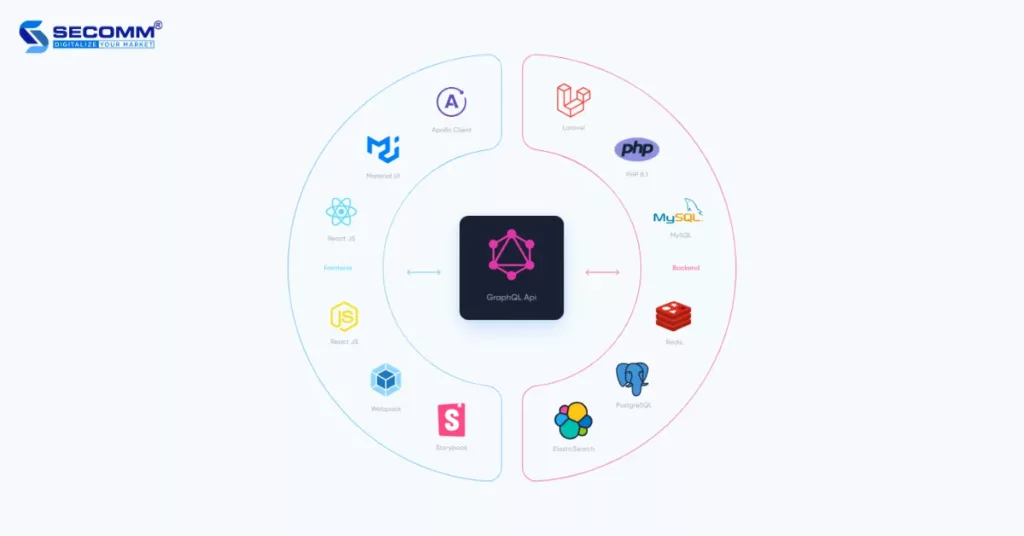
CS-Cart provides a comprehensive range of features from A to Z for operating an eCommerce system for businesses, including over 500 features and 2,000 available add-ons. From product management and order processing to marketing and SEO optimization, among others
This richness helps businesses minimize the need to integrate numerous third-party plugins, streamlining the technology stack of the eCommerce website.
CS-Cart is highly praised for its ability to connect and manage multiple suppliers with customers. This multi-vendor capability optimizes the management of different sellers, inventory, and payments, making the website system an ideal solution for businesses looking to oversee multiple suppliers on a single platform.
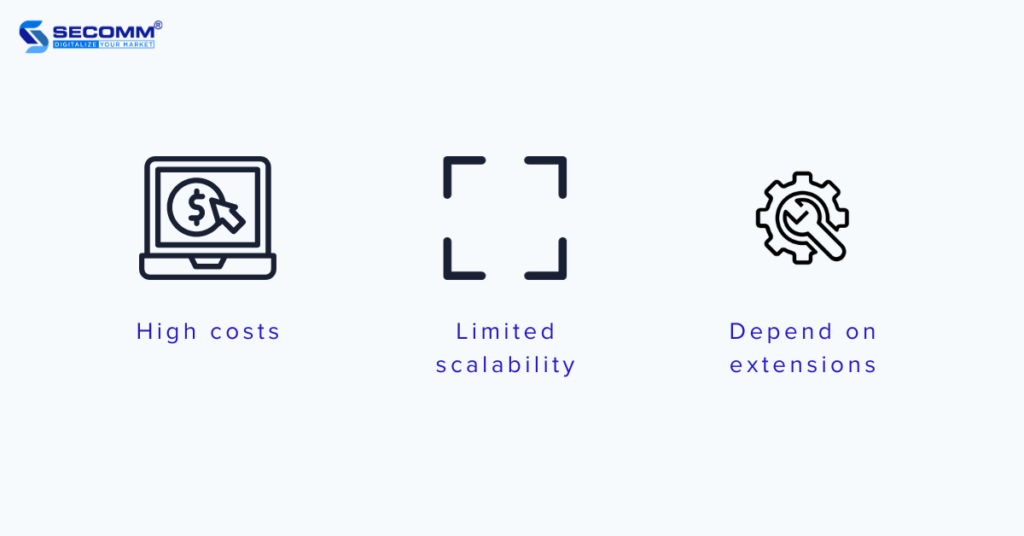
The paid versions, No-Code, and On-Premises, are considered to have relatively high usage costs. Additionally, the free version of CS-Cart may not be sufficient to meet the needs of building an eCommerce website for businesses, especially larger ones.
Businesses should note that many advanced features and functionalities will require purchasing licenses or additional add-ons. The costs associated with these add-ons and development and customization expenses can accumulate, particularly for small businesses or startups with limited budgets.
While CS-Cart is suitable for a variety of business scales, it may not be the most scalable solution for rapidly growing businesses with high levels of traffic and transactions. As businesses expand, performance issues may arise, necessitating improvements to the system’s performance or a transition to another platform.
Although CS-Cart provides many comprehensive features, some businesses feel the need for specific functionalities, requiring the purchase or development of additional third-party add-ons outside the CS-Cart ecosystem.
Relying heavily on third-party add-ons can lead to issues of compatibility, security concerns, and difficulties during the upgrade process.
The Bottom Line
In general, CS-Cart is an eCommerce platform suitable for businesses seeking an open-source solution, especially those with a medium scale. However, when upgrading to a more specialized and complex eCommerce website system, businesses will need to invest additional costs and resources to scale up the system.
These are the details about CS Cart, along with its notable advantages and disadvantages that businesses should consider when developing an eCommerce website.
After years of implementing eCommerce solutions for various businesses across different countries, SECOMM has accumulated valuable experience in helping businesses build and develop effective eCommerce websites.
Contact SECOMM or call the hotline at 02871089908 for advice on choosing a platform and deploying eCommerce today!
 2
2
 7,786
7,786
 0
0
 1
1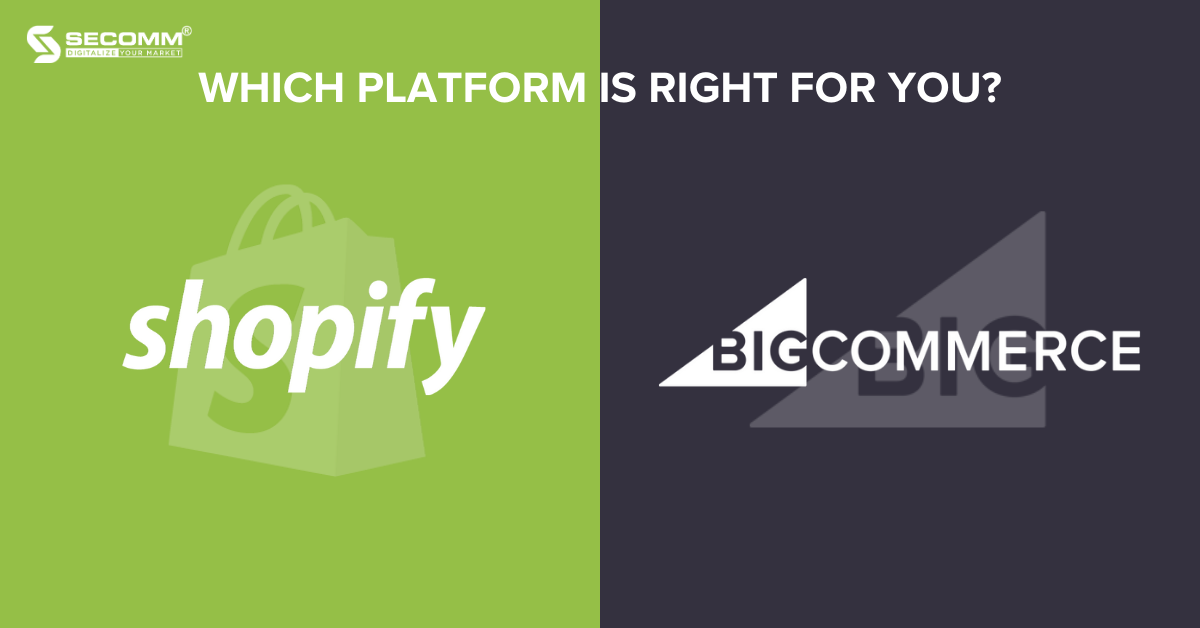
In recent times, SaaS platforms like Shopify and BigCommerce have gained popularity thanks to the growing demand for eCommerce. While BigCommerce currently supports over 45 thousand active online stores globally, Shopify surpasses it with around 4.5 million active websites. Although Shopify and BigCommerce share typical features of SaaS platforms, there are notable differences between the two.
This article will compare the distinctions between Shopify and BigCommerce, providing valuable insights to help you, as a business make informed decisions quickly.
Learn more: Shopify Plus vs BigCommerce Enterprise
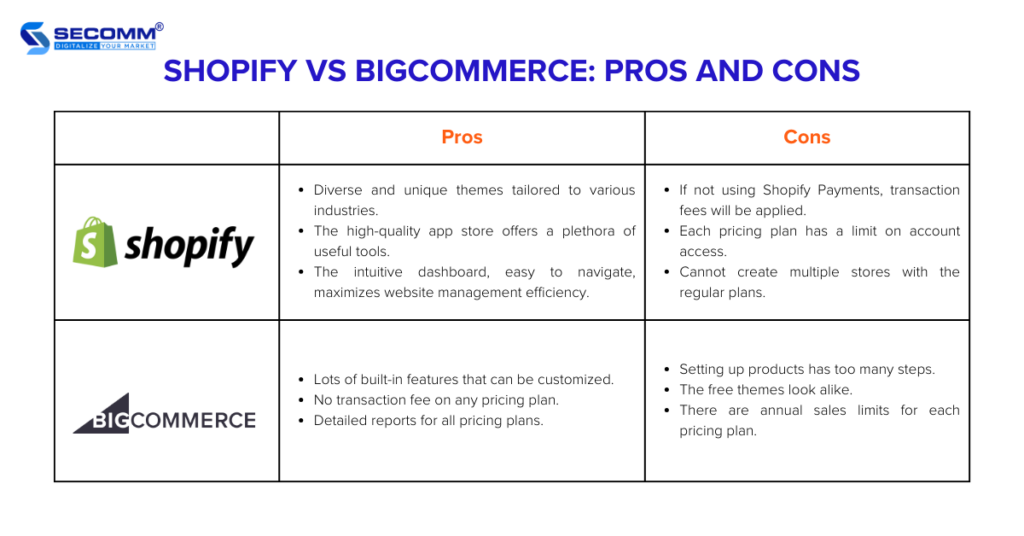
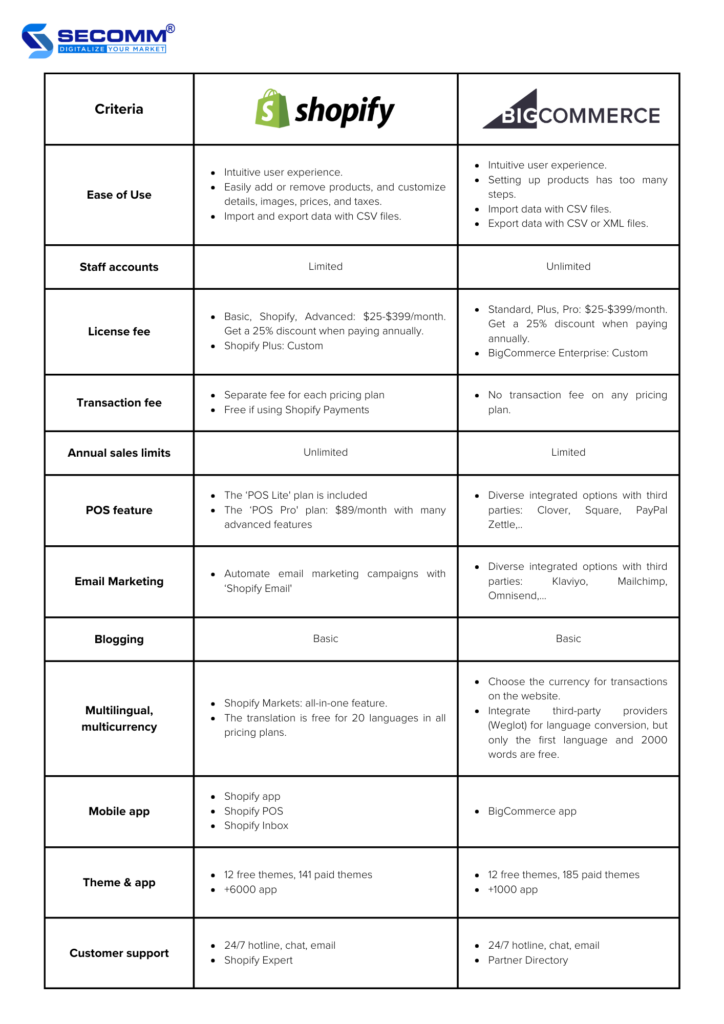
New businesses often find Shopify more user-friendly than BigCommerce when it comes to setup and usage. Adding or removing products, customization, and editing layouts on Shopify are all straightforward tasks.
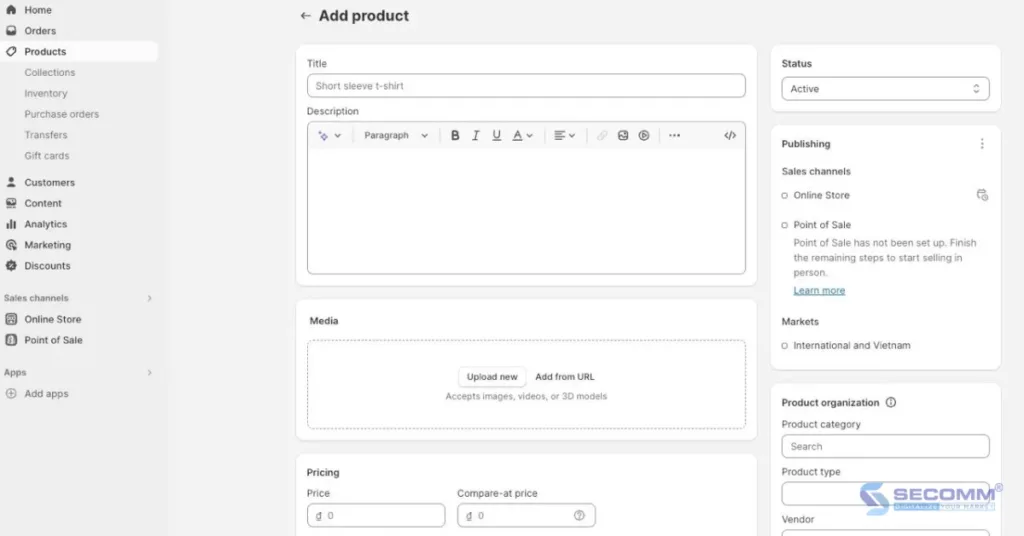
This doesn’t mean that the user experience of BigCommerce is less intuitive than the other. Both platforms are similar, providing drag-and-drop store editors, detailed documentation, and quick support. However, BigCommerce offers many built-in features that are expandable and customizable.
Users, though, may find themselves completing several different steps for each setup task, which can be overwhelming and time-consuming.

Shopify sets account staff limits for each pricing plan. Specifically, the Basic package allows 2 staff accounts, Shopify allows 5 staff accounts, and Advanced allows 15 staff accounts.
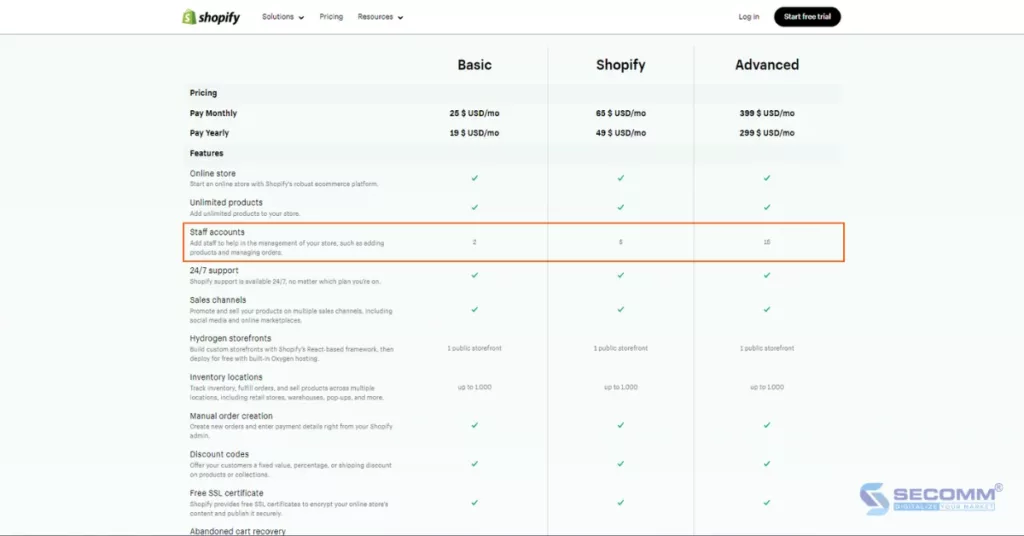
In this regard, BigCommerce has a significant advantage by providing unlimited account access for all solution packages. This flexibility can benefit businesses with many employees needing access to the eCommerce website system.
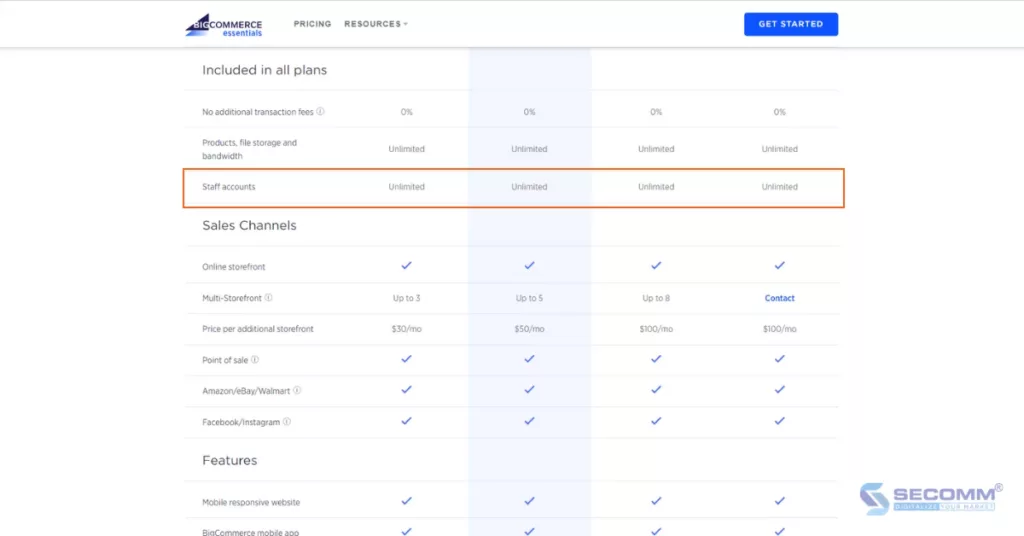
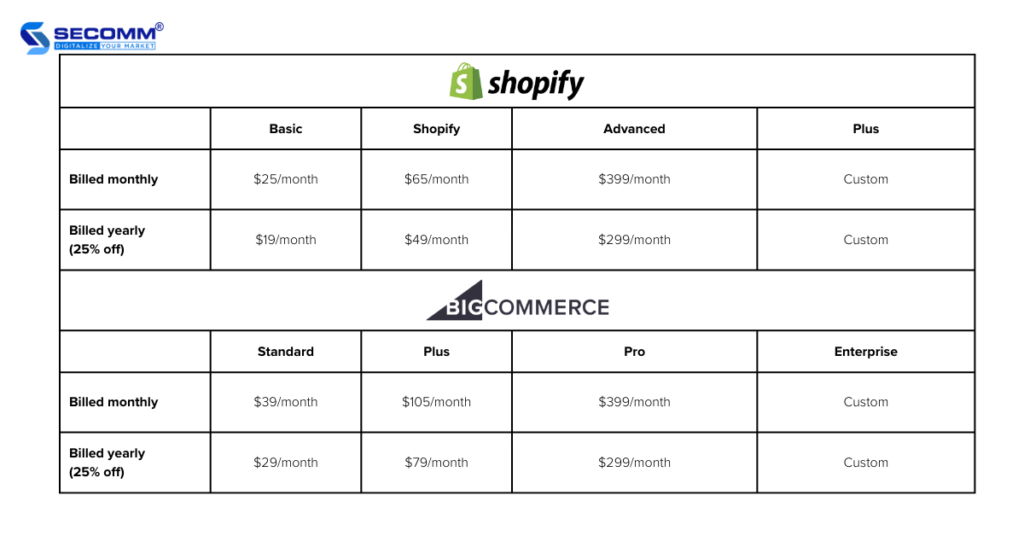
By using BigCommerce pricing plans, you can enjoy a 15-day free trial. The other offers a 3-day free trial for its 3 pricing plans, followed by a payment of only $1 per month for the initial 3 months. This gives you more time to experience the platform at a highly affordable cost.
The transaction fee is a drawback of Shopify. If you opt for third-party payment gateways, you’ll incur a transaction fee of 2%, 1%, and 0.5% for the Basic, Shopify, and Advanced plans, respectively. On the other hand, this fee is waived if you use Shopify Payments. However, Shopify Payments is limited to certain countries, some businesses may not have access. This, in turn, makes BigCommerce more appealing as it doesn’t impose transaction fees on any pricing plan.
BigCommerce sets annual sales limits to $50k for the ‘Standard’ plan, $180k for ‘Plus,’ and $400k for ‘Pro’, while the ‘Enterprise’ plan can be negotiated. To exceed these limits, you must upgrade to a higher pricing plan.
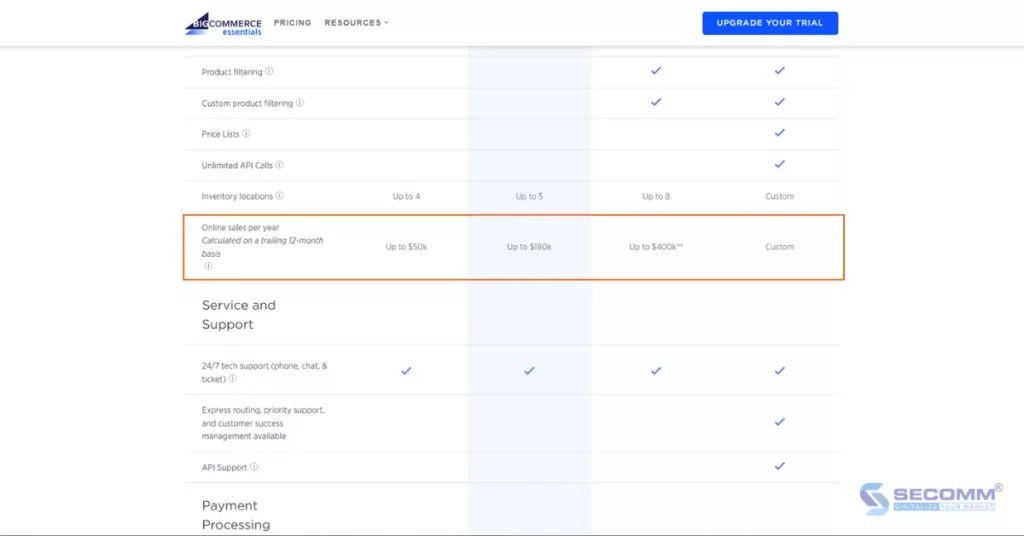
However, your business may not need the features offered in higher-tier plans and may be hesitant to pay additional fees for an upgrade. Therefore, the sales volume limit on the BigCommerce platform is a crucial factor that requires thoughtful consideration. In contrast, Shopify doesn’t impose any annual sales limits on any of its pricing plans.
The POS feature isn’t limited to eCommerce transactions but also extends to traditional brick-and-mortar stores. Both BigCommerce and Shopify allow you to implement POS on mobile devices (smartphones, tablets) and other hardware (cash registers, barcode scanners).
To use POS with BigCommerce, you need to integrate with software like Clover, Vend, Square, PayPal Zettle, and others. Hence, if you are currently using a third-party POS system may appreciate the flexibility offered by BigCommerce.
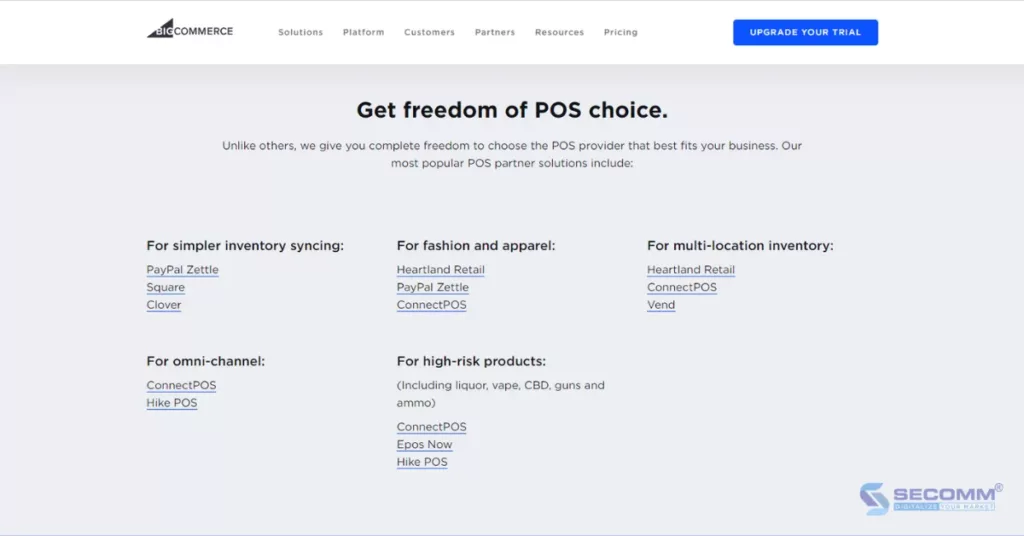
Conversely, Shopify offers built-in POS features, starting with the ‘POS Lite’ plan within its pricing plans. However, to access more advanced POS features, you can opt for the ‘POS Pro’ plan at $89 per month per location, added to the chosen pricing plan. If you choose the annual payment option, the ‘POS Pro’ plan is only $79 per month per location.
Shopify POS solution caters to diverse needs, including single-store transactions, multi-store transactions, event transactions, online and offline sales, as well as omnichannel operations.

In eCommerce, email marketing is crucial when it comes to customer attraction and substantial sales growth. Hence, it’s a feature you should prioritize when selecting an eCommerce platform.
Beyond the Shopify POS solution, Shopify offers you the built-in Shopify Email feature, designed for Email Marketing campaigns and automating email processes (Welcome Email, Winback Email, Upsell Email).
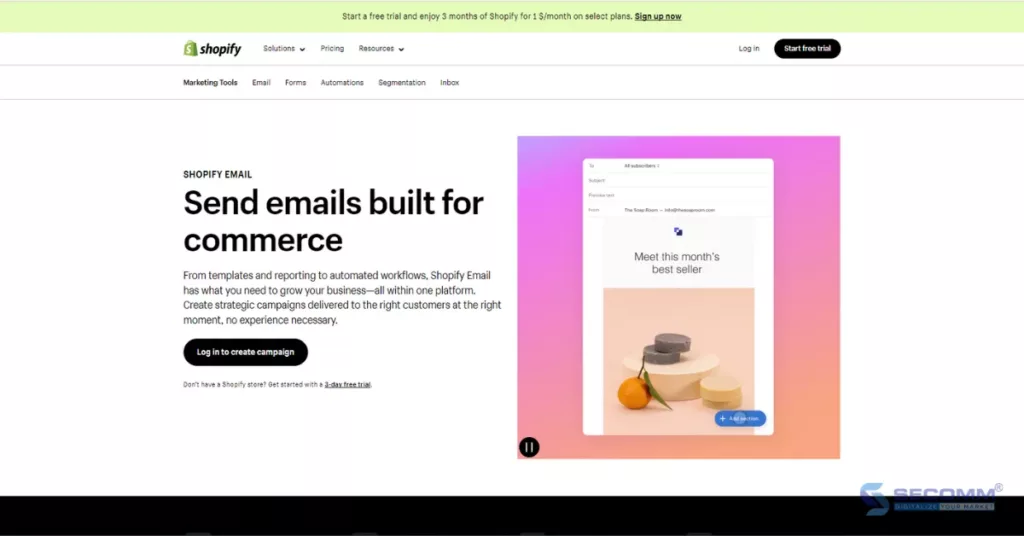
Meanwhile, for Email Marketing on BigCommerce, you need to integrate with third-party service providers like Klaviyo, MailChimp, Omnisend, and others.
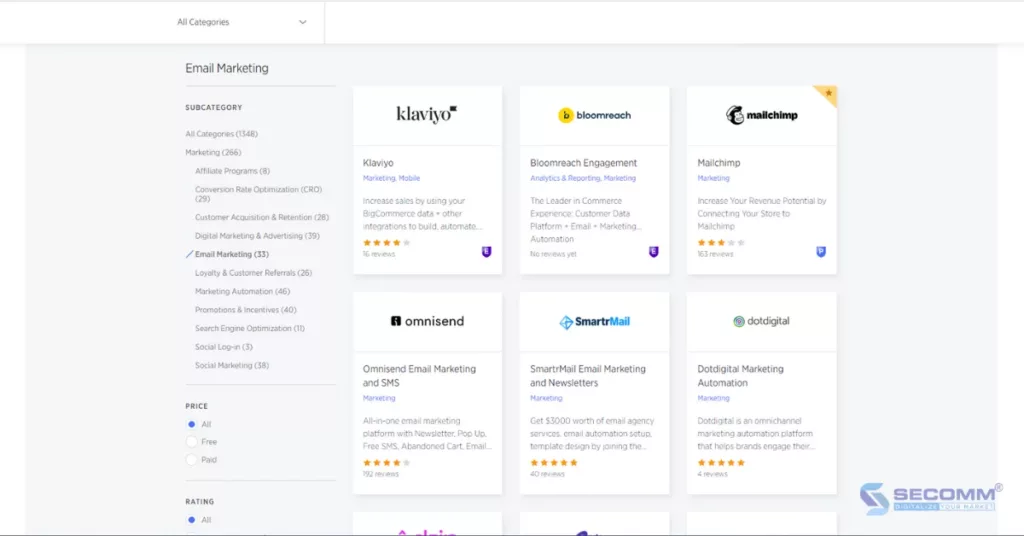
When you utilize blogging effectively, it can be one of the best sources to attract organic traffic. Both BigCommerce and Shopify come with built-in blogging features at a basic level, offering attractive templates that help you create SEO-optimized blog content to draw in potential customers. Moreover, you can seamlessly integrate with WordPress or other CMS platforms for more advanced blogging features
Cross-border selling is currently a common goal for many eCommerce businesses. Fortunately, both Shopify and BigCommerce provide features and tools to help businesses expand into the global market
Shopify Markets, introduced in 2021, is a feature that allows you to select the specific markets you want to sell in. It’s an all-in-one feature that helps you centrally manage multiple local domains, languages, currencies, and payment gateways.
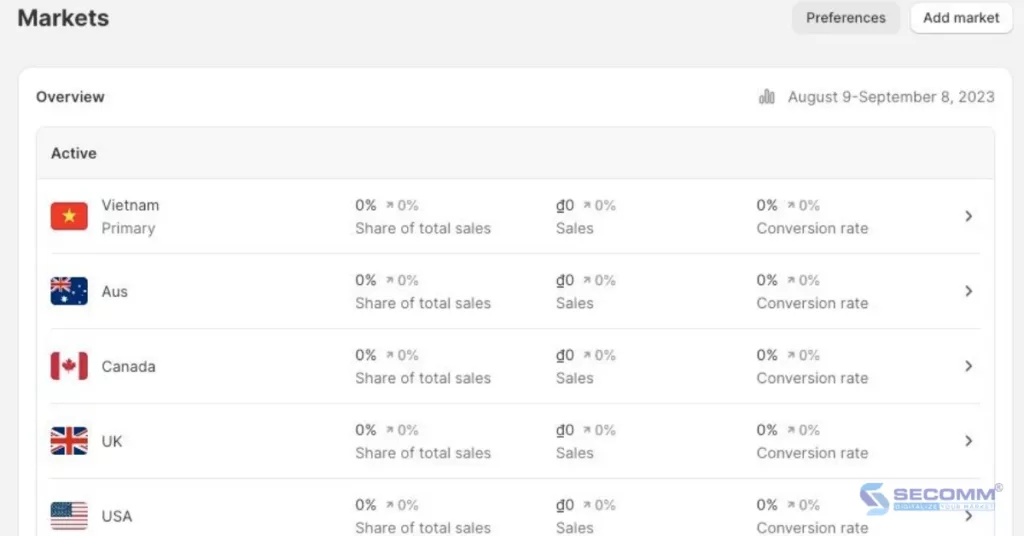
Plus, Shopify Markets utilizes the IP address of visitors outside the default ‘market’ that you previously defined to prompt them to select a location and the appropriate currency.
On the other hand, with BigCommerce, you can choose the currency for transactions on your eCommerce website instead of opting for a ‘market’ like Shopify. Additionally, the currency is automatically converted based on the customer’s IP address.
While language conversion capabilities are built into Shopify when the Shopify Markets feature is enabled, for BigCommerce websites, you’ll need to integrate with a third-party service to achieve the same, such as Weglot, which offers free conversion for 1 language and 2000 words. In contrast, Shopify provides free conversion for 20 languages across all pricing plans.
While BigCommerce has only one app to help you manage sales, interact with customers, and access basic reports, Shopify you up to 3 apps to improve efficiency in eCommerce operations.
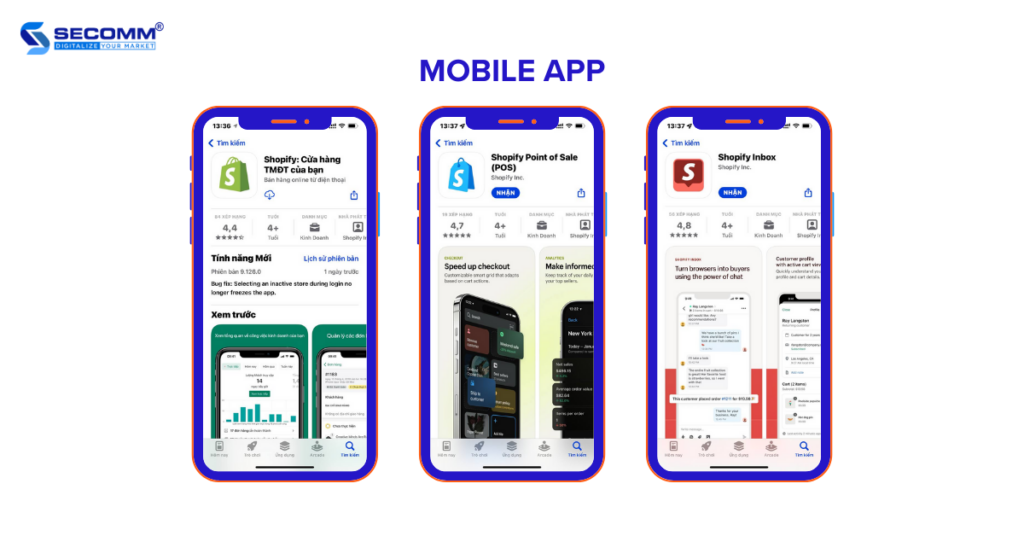
Both BigCommerce and Shopify offer you a variety of free and paid themes. For BigCommerce, the platform provides 12 free themes, but in reality, there are around 5-6 distinct free themes as the layouts are quite similar. As for paid themes, BigCommerce has approximately 185 themes ranging from $150 to $400 per theme.
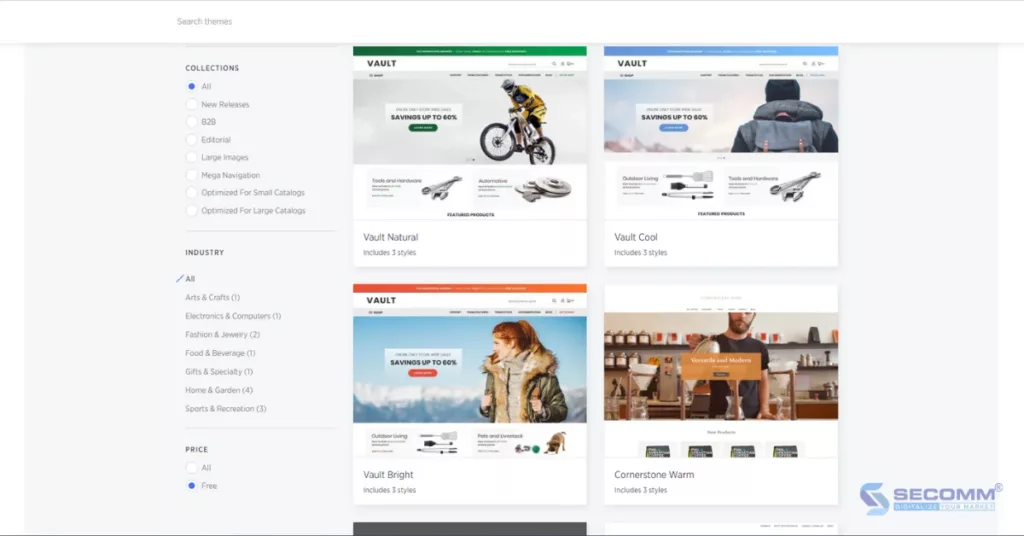
On Shopify, the platform offers 12 free themes and 141 paid themes with prices ranging from $170 to $380 per theme. Both Shopify and BigCommerce provide users with drag-and-drop theme editors to modify layouts, colors, fonts, and text sizes and add/remove elements and widgets.
However, Shopify’s themes, both free and paid, are widely favored for their modern and contemporary styles. Additionally, Shopify offers a diverse selection of fonts for you to choose from. In contrast, BigCommerce has around 8 font options.
Alongside their built-in features, Shopify and BigCommerce both offer extensive app stores to help you optimize your eCommerce activities. Both app stores offer free versions of apps, but certain features may be limited. To access the full functionality, you’ll need to subscribe to the paid versions, which often involve monthly fees. The number of apps available on Shopify and BigCommerce differs significantly, with Shopify boasting over 6000 apps, while BigCommerce has over 1000.
In the process of deploying an eCommerce website, both BigCommerce and Shopify offer 24/7 support through hotlines, chat, and email. Plus, if you seek advice and support in addressing specialized issues related to technology, design, and marketing, BigCommerce provides Partner Directory services, while Shopify offers Shopify Experts.
Above are the comparisons between Shopify and BigCommerce. However, it’s challenging to determine which platform is the best in 2023 for developing an eCommerce website. The choice will depend on your specific needs and wants.
With years of experience advising and collaborating with numerous businesses both domestically and internationally on implementing eCommerce websites on both Shopify and BigCommerce, SECOMM has gathered valuable insights to help your business streamline your eCommerce development process, optimize your website performance, and swiftly generate conversions.
Contact SECOMM today or call directly at the hotline 028 7108 9908 for free and detailed consultations.
 2
2
 9,991
9,991
 0
0
 1
1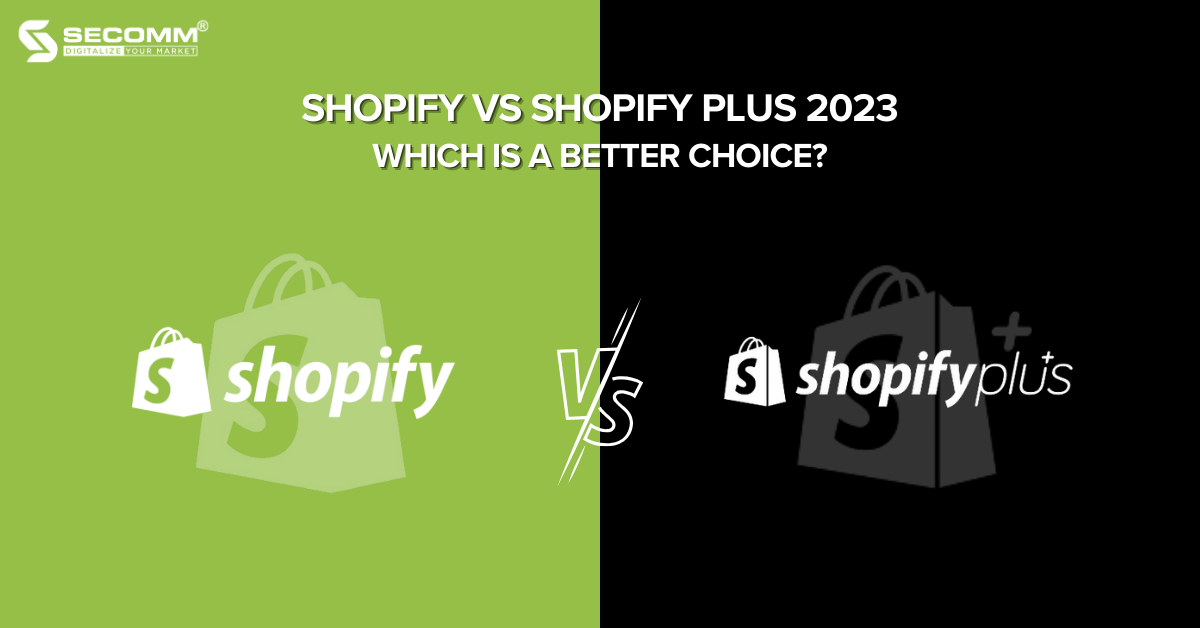
Shopify and Shopify Plus are two leading eCommerce platforms globally, used by millions of businesses to deploy eCommerce websites. The Shopify platform is designed for small and medium-sized enterprises, providing basic, user-friendly features for building and managing eCommerce websites. According to Builtwith, over 4 million active Shopify stores are currently worldwide.
On the other hand, Shopify Plus is specifically crafted for large-scale enterprises, offering advanced features, customization options, and flexible scalability. Builtwith statistics indicate that there are over 44 thousand active Shopify Plus websites globally.
What are the differences between Shopify and Shopify Plus? Which platform should you choose to build your eCommerce websites? This article will focus on clarifying the differences between Shopify and Shopify Plus in three aspects: cost, features, and support capabilities, to help you choose the most suitable platform for your needs and goals.
The first distinction and crucial criterion to consider between Shopify and Shopify Plus are the license fees and transaction fees. Shopify and Shopify Plus offer different solution packages with varying pricing to suit businesses with different budgets and scales.
Shopify offers three main pricing plans: Basic, Shopify, and Advanced, priced at $25, $65, and $399 per month, respectively. Also, Shopify has a special solution package called Shopify Starter at $5/month, enabling you to sell on social media and chat apps.
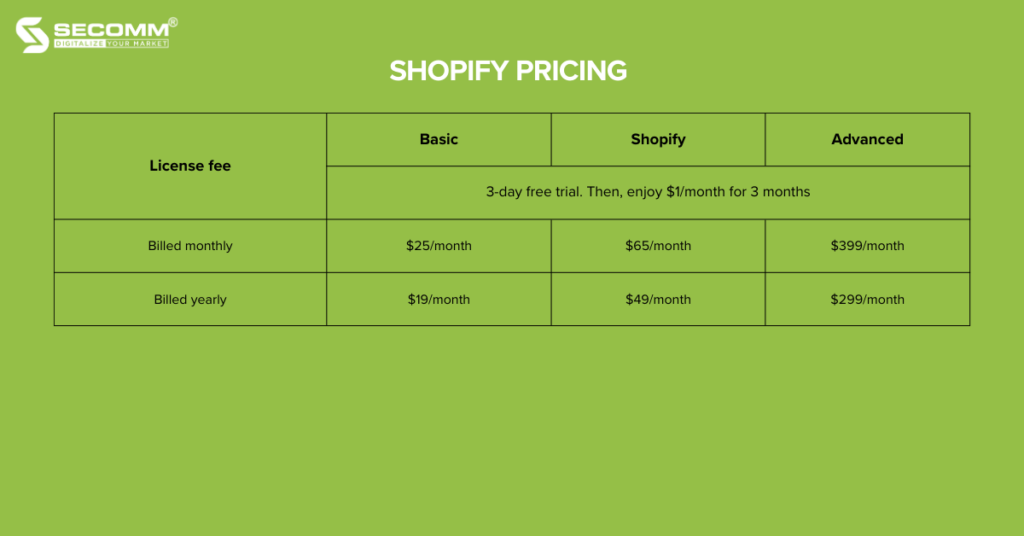
*Note: The mentioned fees apply to the Vietnamese market, and platform license fees may vary depending on the region or country.
Beyond the license fees, you also need to consider the transaction fee when using different payment methods. Shopify offers its payment method called Shopify Payments, allowing you to effortlessly accept all major payment methods on your eCommerce website.
If using Shopify Payments, you don’t have to pay any transaction fee to Shopify.
On the other hand, If you don’t use Shopify Payments and select one of many third-party payment service providers supported by Shopify, you’ll pay transaction fees of 2%, 1%, and 0,5% for the Basic, Shopify, and Advanced plans, respectively.
Since Shopify Plus is designed for large businesses, the pricing structure for the Shopify Plus package is variable and depends on the individual deployment requirements and revenue of each business. According to Shopify, the initial cost for using Shopify Plus is $2,000/month, with subsequent increases based on monthly revenue.
Specifically, when the revenue of a Shopify Plus store reaches $800,000/month, the platform will apply a charge of 0.25% of the monthly revenue. It’s worth noting that the fee will not exceed $40,000/month and $480,000/year.

Similar to the Shopify pricing plans, Shopify Plus supports both Shopify Payments and third-party payment service providers. However, the transaction fees associated with Shopify Plus are lower compared to regular Shopify plans. If you don’t use Shopify Payments, you’ll incur a transaction fee of 0.15% on each transaction.
When it comes to features, Shopify Plus excels by providing a range of advanced features for you to customize your eCommerce websites, aiming to deliver a unique experience for customers.
Related Reading: 6 key Shopify Plus features
Most Shopify businesses typically utilize either the available free or paid themes on Shopify, encountering several limitations when customizing the checkout or cart pages. However, with the implementation of Shopify Plus, you can leverage Shopify Scripts to tailor small code segments, enabling the creation of a personalized shopping experience for customers at the cart and checkout pages.
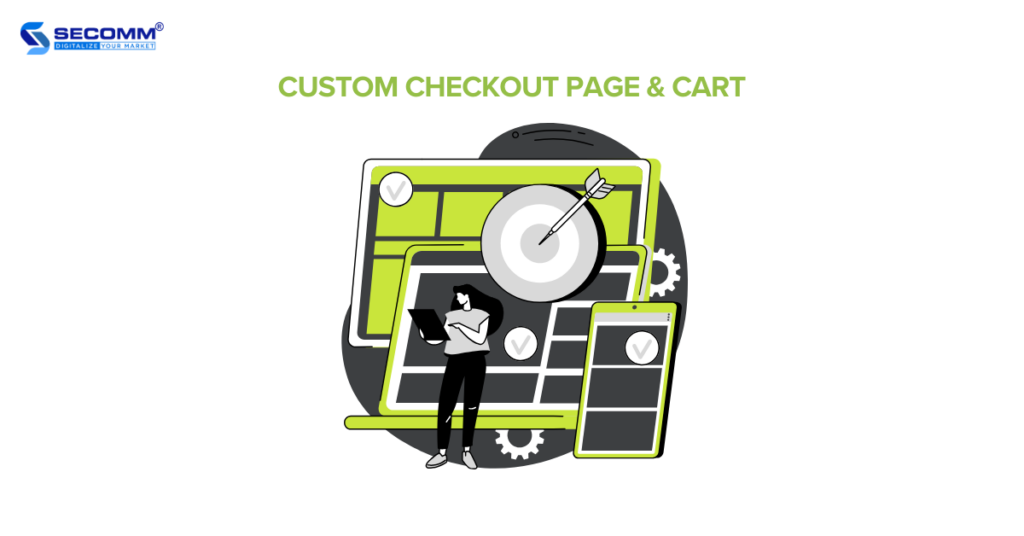
The Shopify pricing plans provide a set of built features for businesses to automate eCommerce and marketing operations. On the other hand, with the deployment of Shopify Plus, businesses can utilize specialized tools to automate eCommerce processes, such as:
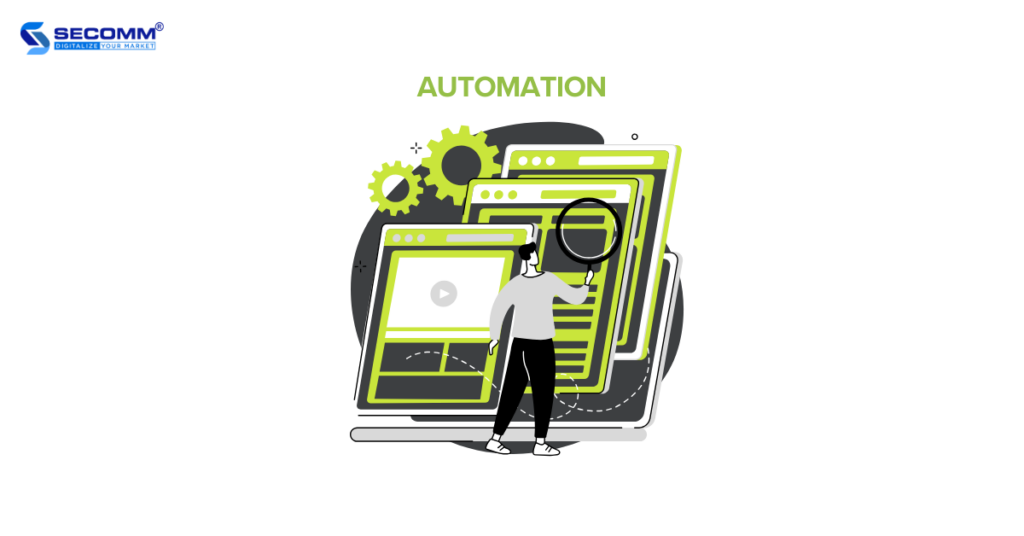
For all Shopify businesses, the Shopify POS feature is included in the standard service package known as POS Lite, but it has limitations in terms of features and POS usage locations. To unlock more advanced features and extend the POS capabilities, Shopify businesses need to upgrade to the POS Pro package, priced at $89 per month per location.
On the other hand, Shopify Plus businesses enjoy free access to POS Pro for their initial 20 locations. This implies that businesses implementing Shopify Plus can leverage advanced POS features, including BOPIS deployment, unlimited user accounts, omnichannel selling, inventory management, and more.
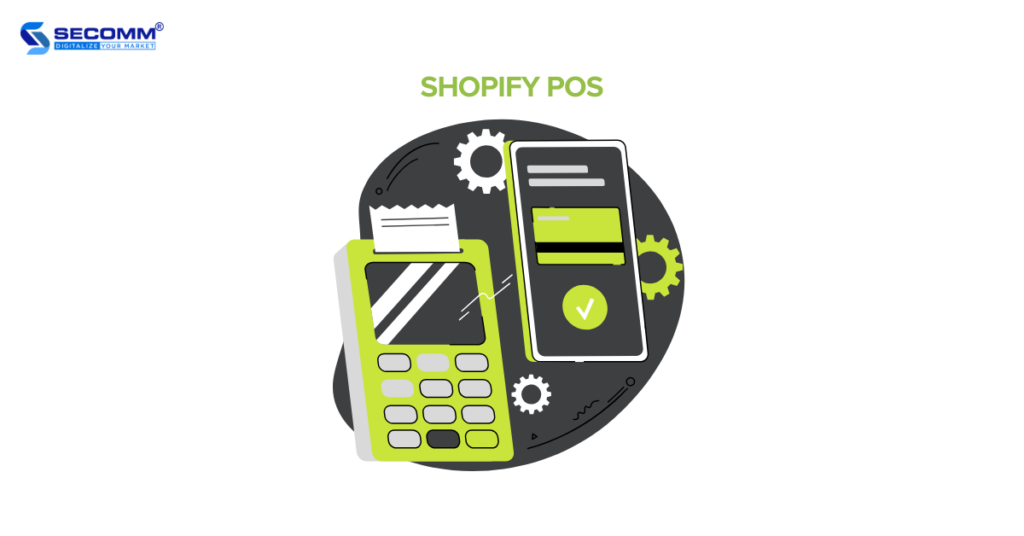
This feature is specifically designed for Shopify Plus businesses, facilitating B2B transactions directly through the eCommerce website without reliance on third-party apps or alternative solutions. You can set up catalogs, payment terms, and company profiles, and customize prices specifically for B2B customers.
This provides the flexibility to develop a website that serves B2B and B2C customers or craft a specialized platform dedicated to B2B clients.
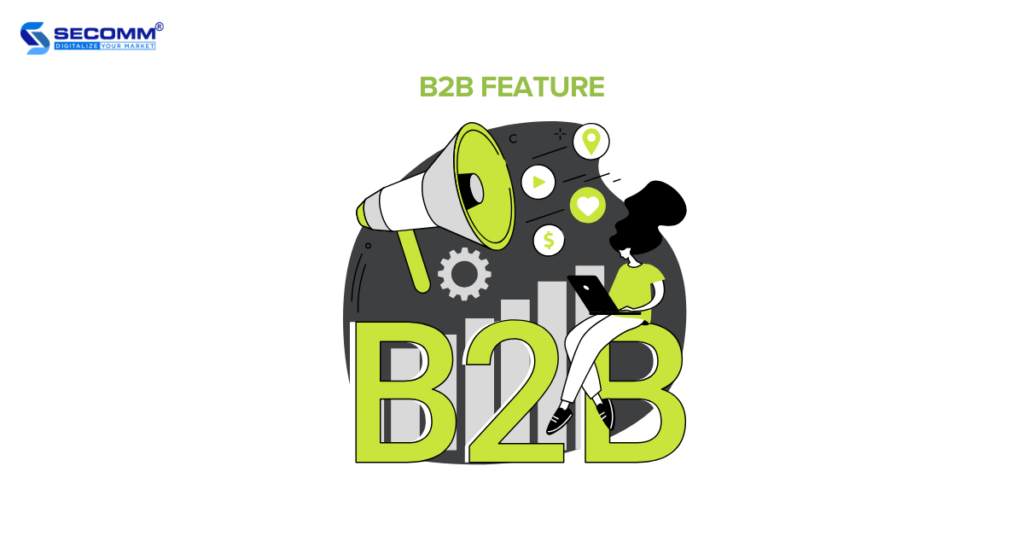
The wholesale feature is specifically designed for Shopify Plus merchants. This feature allows you to customize the wholesale website interface differently from the regular eCommerce site, adjust pricing, and establish a distinct ordering process specifically for wholesale customers. You can also choose to showcase products intended for wholesale transactions exclusively on the Shopify Plus wholesale website.
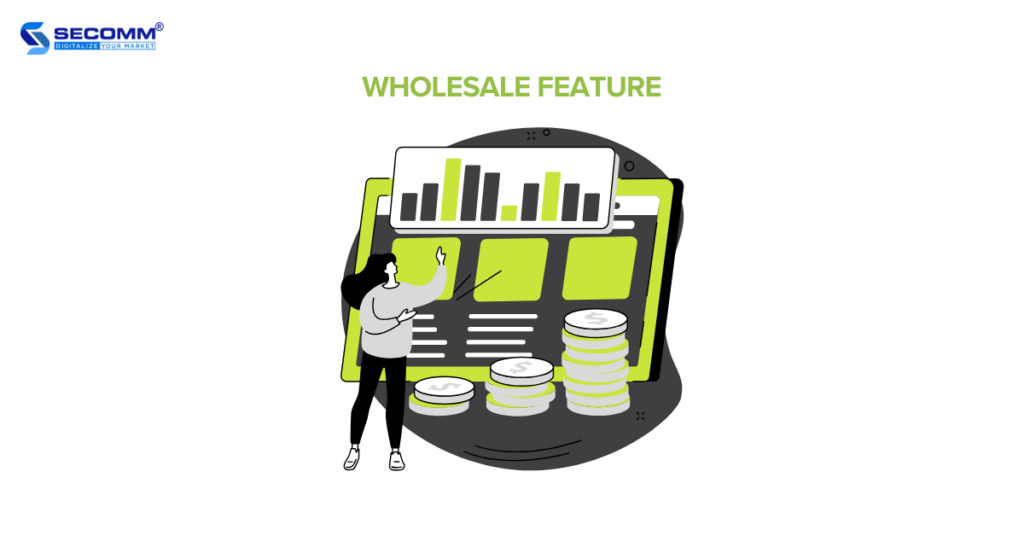
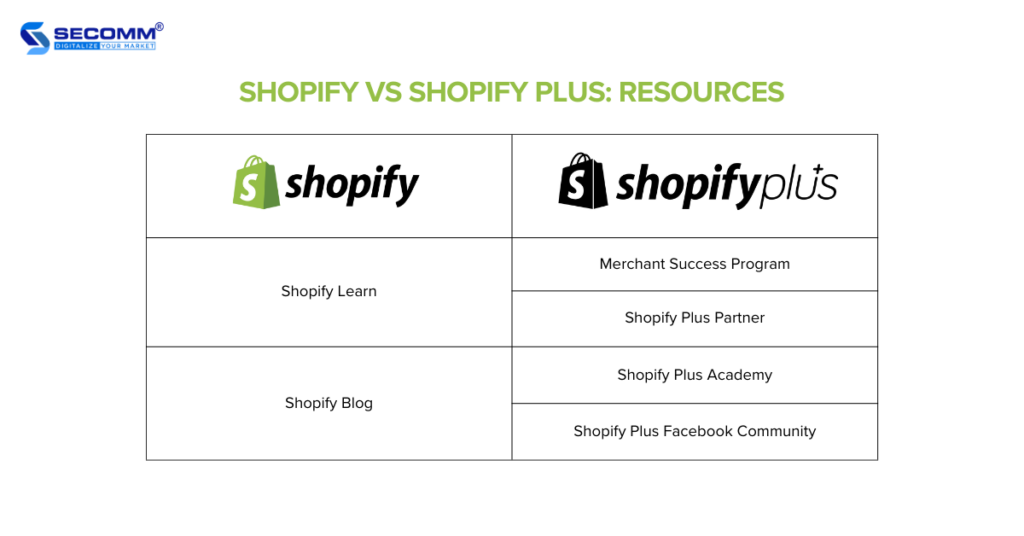
For Shopify businesses, they can access support 24/7 throughout the entire process of building and advancing their eCommerce website through channels like the hotline, email, or chatbox. Additionally, Shopify provides resources for businesses to enhance their eCommerce operations, including:
In addition to the support services available through the hotline, email, or chatbox, businesses utilizing Shopify Plus enjoy enhanced access to educational resources and support:
Here is an overview of the significant differences between Shopify and Shopify Plus platforms. The decision on which platform is most suitable depends on each business’s scale and deployment requirements.
For startups or small to medium-sized enterprises with minimal customization requirements and a desire for quick product launches, regular Shopify solutions may be more suitable.
On the other hand, large-scale enterprises with high integration and customization needs should prioritize Shopify Plus.
With years of experience deploying Shopify Plus eCommerce websites for leading businesses such as Vinamilk and Suzuverse, SECOMM boasts a professional team with exceptional technical skills and in-depth knowledge of the Shopify Plus platform.
Contact SECOMM or call the hotline at 028 7108 9908 to deploy Shopify Plus today!
 2
2
 6,047
6,047
 0
0
 1
1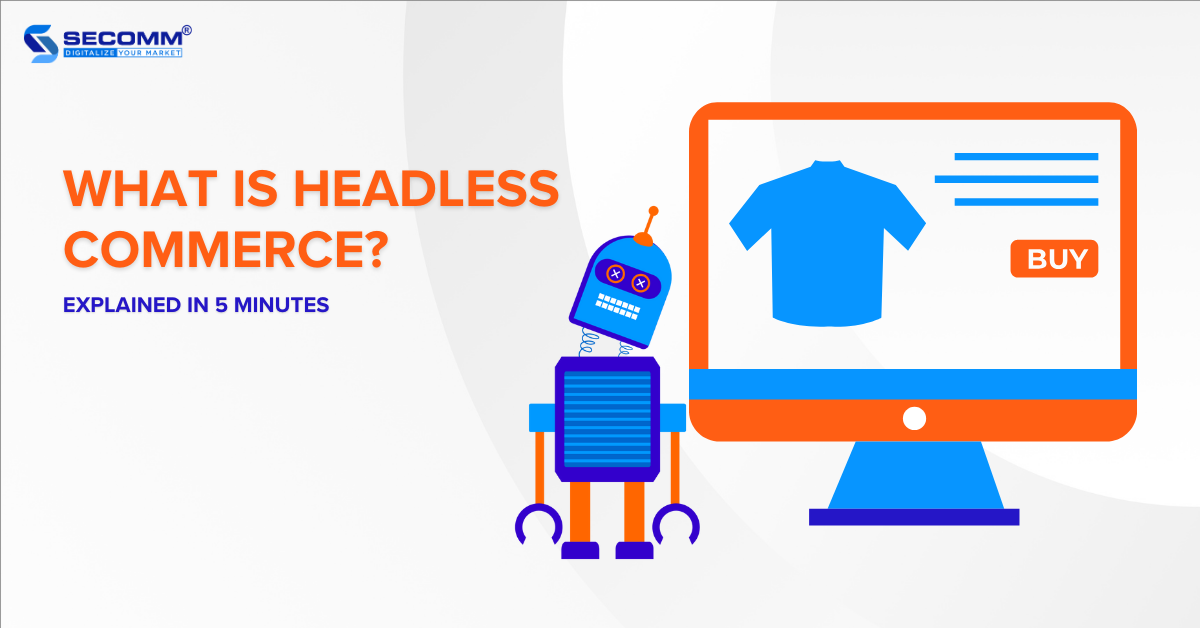
When learning the significant changes in eCommerce over the past decade, one concept that cannot be ignored is Headless Commerce. It isn’t a mere trend; rather, it presents a revolutionary solution for how businesses implement eCommerce, aiming to provide flexibility and enhanced efficiency in delivering a seamless shopping experience for customers.
The following statistics contribute to proving that Headless Commerce is one of the fastest-growing trends in eCommerce:
So, what is Headless Commerce, and why is it considered a modern and flexible approach to eCommerce deployment? Let’s explore this in the following article.
Headless Commerce is an eCommerce architecture that separates the user interface (Frontend) from the data management and functionality (Backend) of an eCommerce website. This separation allows the frontend and backend to be built entirely independently and connected through eCommerce Application Programming Interfaces (APIs).
Going Headless allows you to use any technology or tool you prefer to design and customize the user interface without being dependent on the existing eCommerce platform. You can also update and modify the backend without affecting the frontend.
Learn more: Everything to know about eCommerce APIs
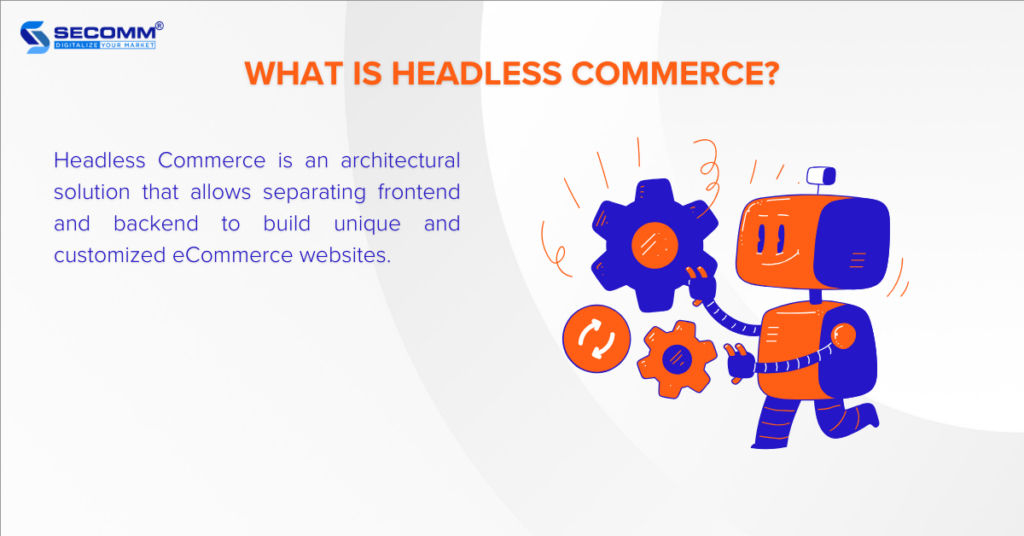
Trước khi giải pháp Headless Commerce, hầu hết các website thương mại điện tử đều được xây dựng với kiến trúc Monolithic – tức là phần frontend và backend được liên kết chặt chẽ với nhau trong một hệ thống duy nhất. Đây là cách tiếp cận truyền thống và đơn giản, giúp doanh nghiệp dễ dàng xây dựng và quản lý website thương mại điện tử của mình.
However, Monolithic Commerce comes with several limitations, especially when you aim to develop and scale your eCommerce systems. Some common issues encountered when implementing Monolithic Commerce include:
In contrast to Monolithic Commerce, Headless architecture brings several benefits when developing eCommerce. Some of these include:
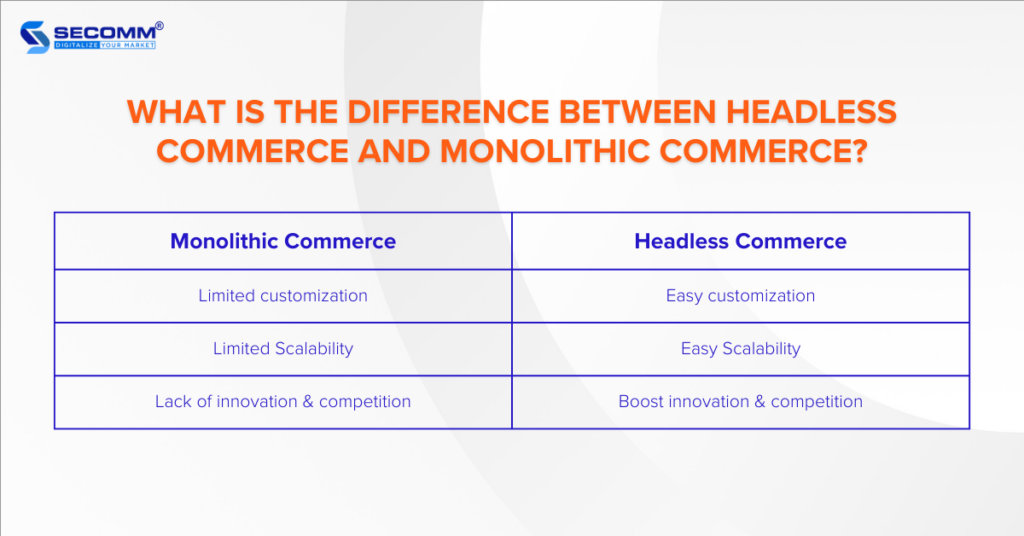

The Headless Commerce model allows you to customize and create a unique user experience across various channels (website, mobile app, IoT). This not only avoids impacting the backend system but also helps you reach more potential customers and boost conversion capabilities.
You can effortlessly integrate and merge various third-party systems (CRM, CMS, ERP, DXP) into the backend using APIs. This integration enhances the efficiency of managing and executing eCommerce activities, enabling you to leverage the superior capabilities of multiple services without concerns about website compatibility or performance issues.
Through seamless integration with various systems, you can collect and consolidate customer data from various sources such as CRM, advertising campaigns, or data from previous shopping experiences.
Going Headless, you can create a customized interface based on customer data and personal information, displaying unique content, products, and messages for each customer based on their preferences, shopping behavior, and transaction history.
Deploying Headless Commerce enables you to expand your operations into international markets by adapting their activities to effectively cater to diverse markets. Specifically, you can customize the user interface, manage content, and offer distinct views for each customer segment in various markets.
Moreover, you can seamlessly integrate local options for payment, delivery, language, and currency to enhance the local customer experience.
In the Headless architecture, the frontend and backend operate independently through APIs, allowing businesses to optimize the performance of both parts. For example, you can enhance the navigation and page loading speed of frontends (website, mobile app, IoT) without heavily relying on the backend’s performance.
Similarly, you can optimize the backend to efficiently handle product requests, transactions, or inventory without impacting the page loading speed of the frontends
Headless Commerce is a highly innovative eCommerce solution. However, that doesn’t mean this solution is suitable for every business. Therefore, before deciding to implement Headless for an eCommerce website, you need to consider the following factors:
Ready to go Headless?
Over time, Headless Commerce has played a crucial role in reshaping how businesses implement eCommerce. This model provides you with many benefits in terms of customization, scalability, and delivering a multi-channel experience for customers. However, before deciding to deploy Headless, you’ll need to consider issues related to business goals, budget and resources, development needs, and the go-live timeline.
When ready to implement Headless, you’ll choose top platforms supporting Headless Commerce. One of these platforms is Shopify, a renowned SaaS platform that has introduced several solutions for businesses to deploy Headless.
With extensive technical expertise and high specialization in the eCommerce domain, SECOMM has successfully consulted and implemented Headless Commerce using one of Shopify’s three solutions for leading enterprises such as Vinamilk, Suzuverse, and more.
Contact SECOMM or call directly at the hotline (02871089908) to explore how we can support businesses in maximizing the potential of Headless Commerce and enhancing competitiveness in the eCommerce market.
 2
2
 7,322
7,322
 0
0
 1
1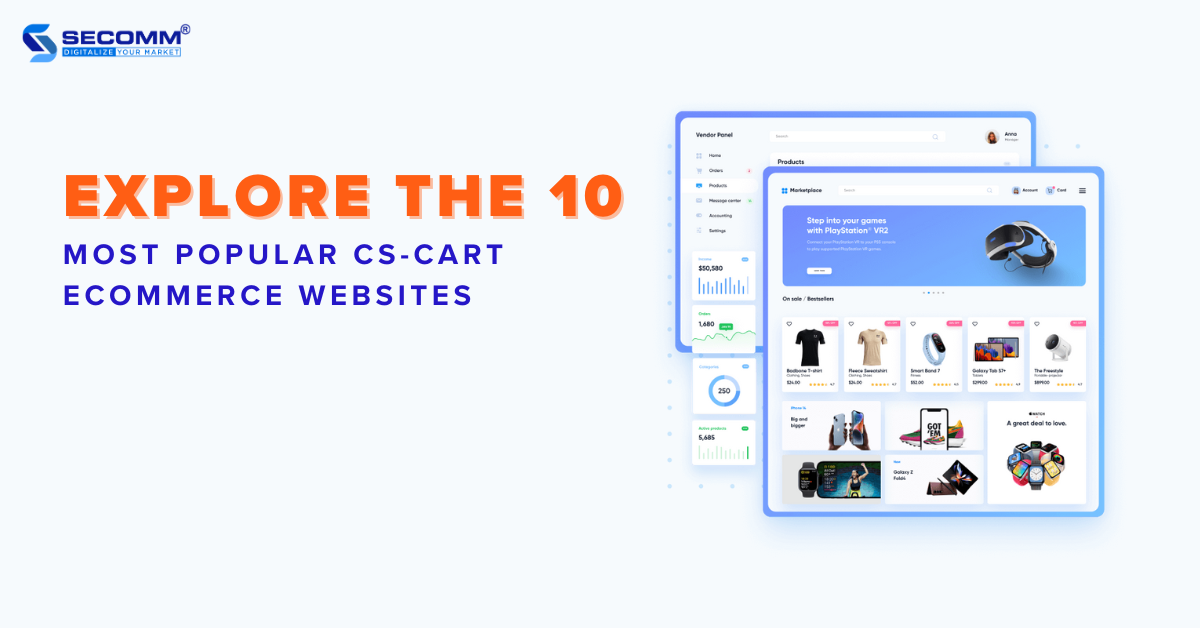
CS-Cart is a versatile eCommerce platform, available in both open-source and SaaS models. Established in 2005 under Simbirsk Technologies Ltd., it has garnered trust from medium-sized and large businesses. Its reputation is built on robust customization options, numerous features, and supplementary utilities within its ecosystem.
Listed below are brands that have built their CS-Cart eCommerce websites.
House of CB is a leading women’s fashion brand in London, United Kingdom. Renowned for its meticulously crafted collections tailored for significant events, the brand was established by Conna Walker at the age of 17, backed by a £3,000 loan from her father.
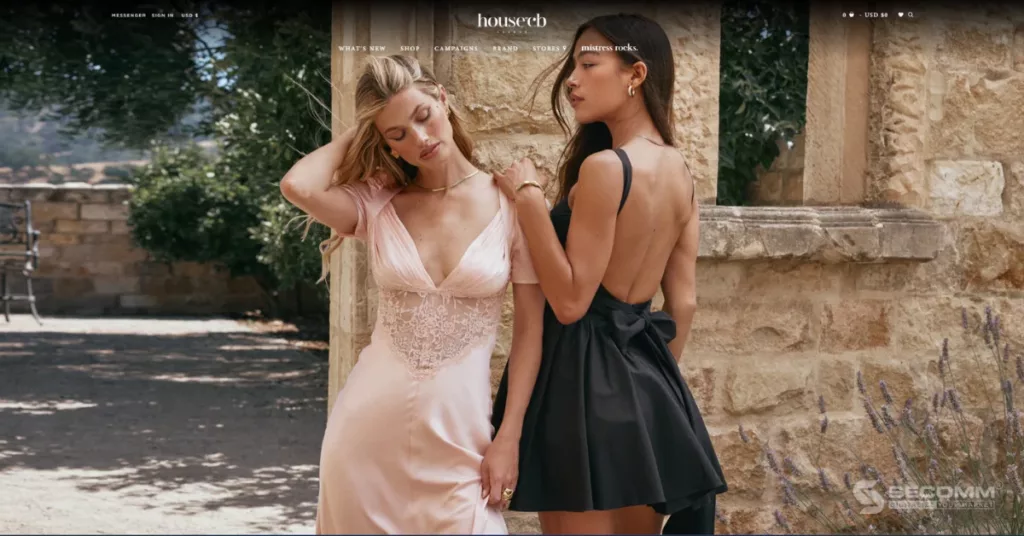
Faced with initial capital constraints, House of CB strategically leverages eCommerce to engage with its potential customers. Over time, the brand has graced the wardrobes of numerous Hollywood luminaries, including Beyonce, Gigi Hadid, Lady Gaga, Jennifer Lopez, and the Kardashians.
Maxbhi is an eCommerce venture operated by Elcotek India Private Limited in India. The CS-Cart website is dedicated to offering a wide range of accessories for electronic devices, including mobile phones, tablets, laptops, and more, specifically within the Indian market.
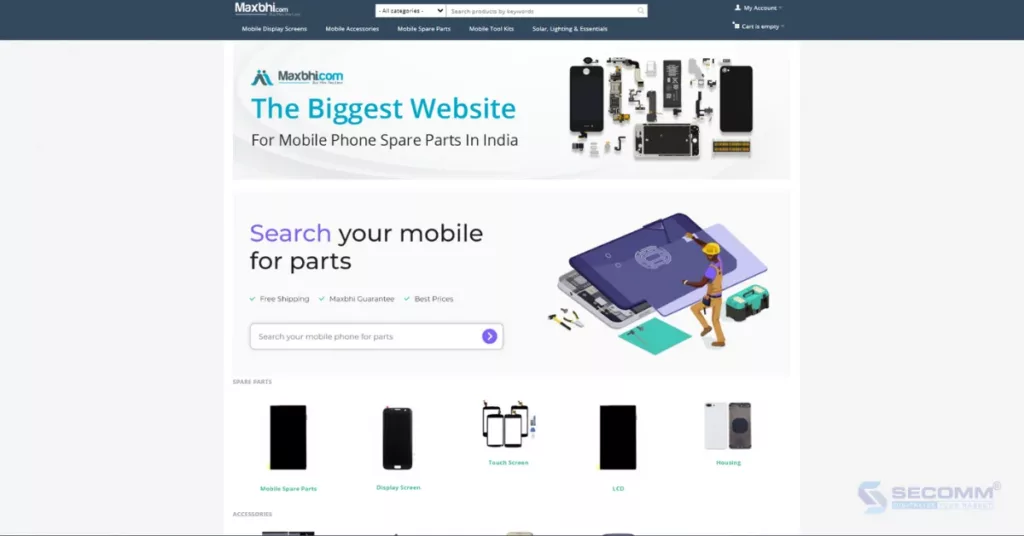
Launched in 2004 in Ghaziabad, India, this CS-Cart eCommerce website has grown to become one of the largest and most enduring online stores for phone accessories in the country.
Harvey Norman is a leading retailer in New Zealand, offering a diverse range of products including computers, electronics, furniture, bedding, and household appliances from renowned global brands.
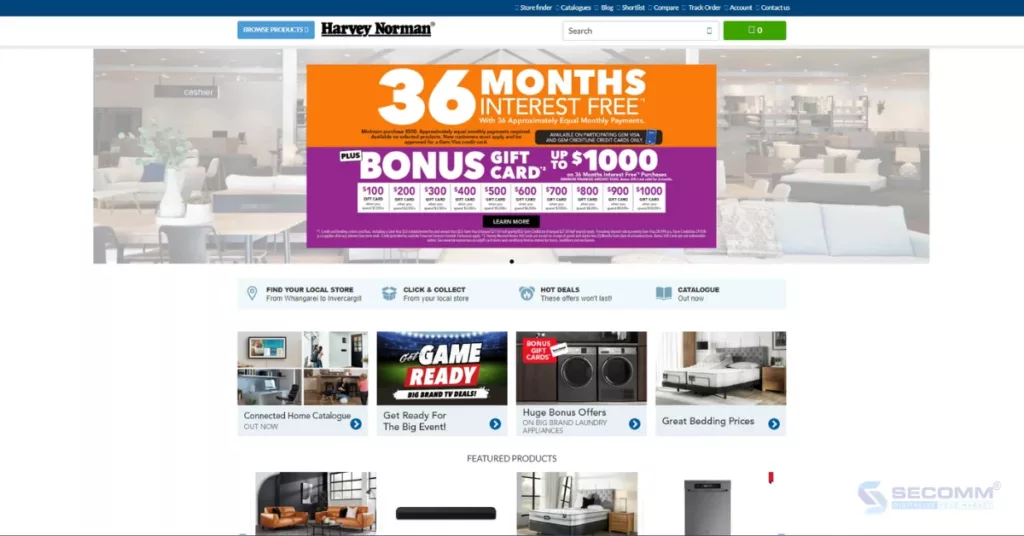
This initiative is part of the franchise system operated by Harvey Norman Holdings Limited, a publicly listed company on the Australian Securities Exchange Limited. The company’s main activities encompass retail, franchise operations, real estate, and digital enterprises.
Enter stands out as one of Moldova’s major retailers in the consumer electronics sector. Boasting a network of 25 traditional stores across the country, Enter focuses on delivering a wide range of electronic devices, including mobile phones, tech accessories, home appliances, and more.
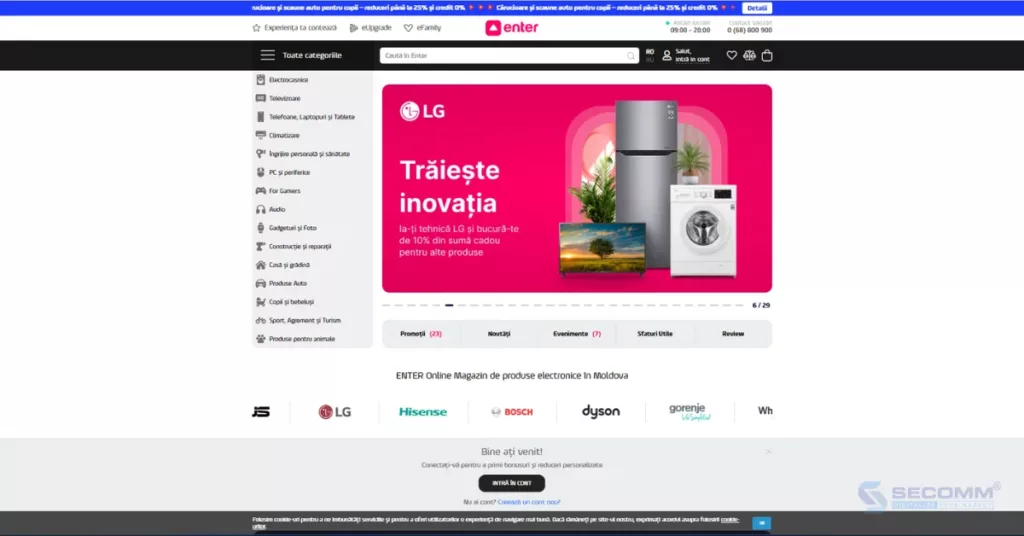
Moreover, Enter has established itself as a trusted authorized dealer for renowned brands such as Apple, Samsung, Xiaomi, Dyson, Lenovo, LG, and others. With future plans in mind, the company aims to further expand its brick-and-mortar stores and enhance its eCommerce website for an even more convenient shopping experience for customers
Mobilier1 is a Romanian CS-Cart eCommerce website specializing in the furniture industry. With over a decade of experience, the company remains focused on manufacturing and selling furniture within the eCommerce market. Mobilier1 consistently earns praise for the high quality of its products and services, providing competitive pricing compared to other market players.

Furthermore, Mobilier1 offers additional services such as nationwide free delivery and a 365-day return policy, ensuring a seamless experience for its customers.
Butor1 is a Hungarian business specializing in the distribution of furniture and interior accessories. Over the past decade, the company has formed direct partnerships with renowned furniture manufacturers to offer customers products at reasonable prices.
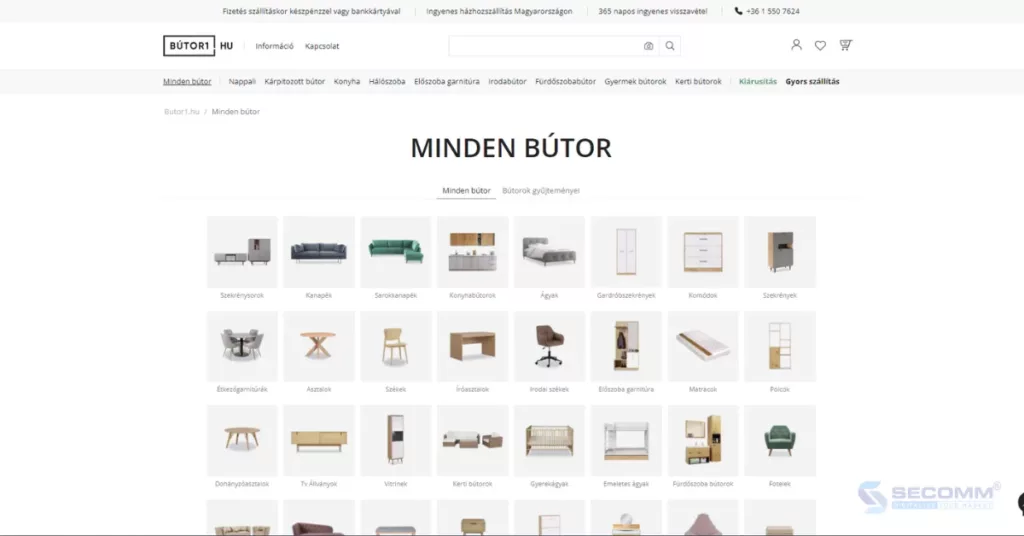
Recently, Butor1 has taken a step further by combining CS-Cart eCommerce website operations with sustainable practices, pledging to plant a tree for each successfully placed order, demonstrating its commitment to environmental responsibility.
Siriust is a CS-Cart eCommerce website under the umbrella of Profi, a leading retail chain in Russia. Specializing in tech accessories like smartphones, laptops, wireless devices, and repair tools, Siriust boasts a catalog of over 16,000 products.
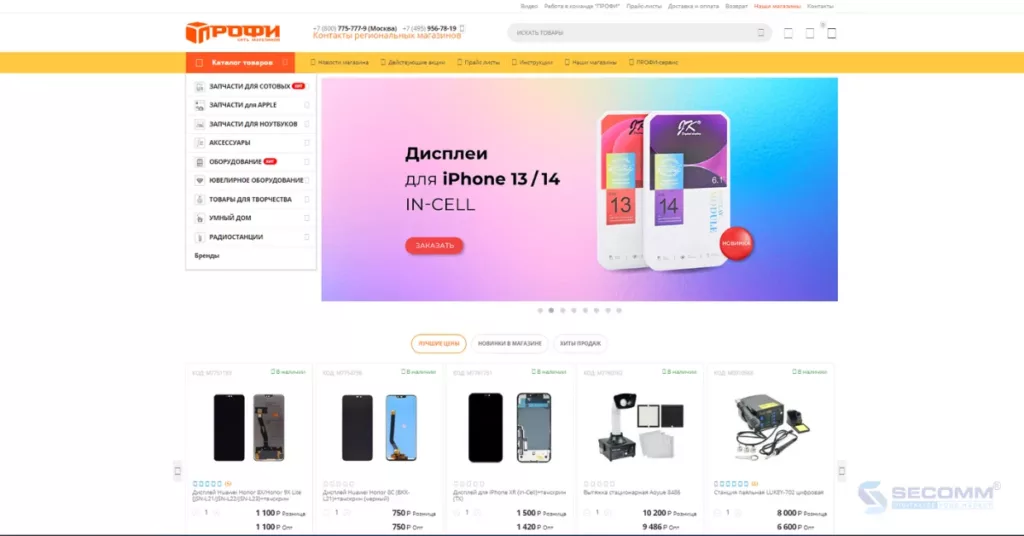
With 50 physical stores in major Russian cities, the company has strategically introduced a CS-Cart website, enabling customers to conveniently make online purchases and pick up their orders from the nearest store.
Topsto is an online store serving customers in both B2B and B2C sectors in the Crimea region, Ukraine. With an expansive product catalog comprising over 280,000 items, Topsto’s CS-Cart website gained favor among customers for its varied product range, affordable pricing, and swift delivery services across the Crimea region.
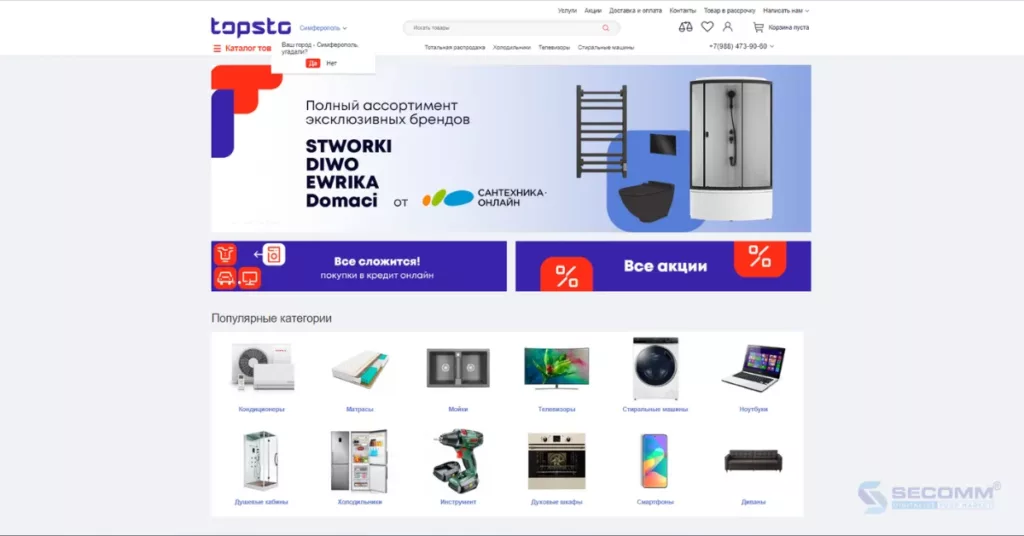
UcuzKitapal is a Turkish online book retail business with a loyal customer base of over 85,000. The store offers a vast collection of books covering diverse genres, including education, literature, economics, self-development, and more.

Through the early adoption of a CS-Cart eCommerce website, the business consistently satisfies book-buying needs with highly competitive prices, swift delivery, and attractive offers.
Riviera Vaudoise is a paint and coating business established 40 years ago in the “Riviera Vaudoise” region in western Switzerland. Renowned for its picturesque landscapes, traditional villages, rose gardens, and idyllic lakeside views, the region provides an exquisite backdrop.

Over the years, Riviera Vaudoise has evolved into the premier destination for oil-based paints in the area, catering to diverse needs such as automotive, residential, and wood applications.
Currently, the company has built its CS-Cart website to extend its business footprint into the realm of eCommerce, aiming to connect with a broader audience of potential customers throughout Switzerland.
Here are 10 CS-Cart eCommerce websites that have not only successfully developed their online presence but have also achieved notable success in their respective industries. This triumph serves as inspiration for other businesses looking for effective solutions to elevate their operations and enhance competitiveness in the market.
Drawing on substantial experience in implementing eCommerce solutions for clients across diverse countries, SECOMM comprehends the challenges and hurdles businesses encounter during the deployment process.
Contact SECOMM today or call the hotline at 02871089908 for a free consultation.
 2
2
 9,683
9,683
 0
0
 1
1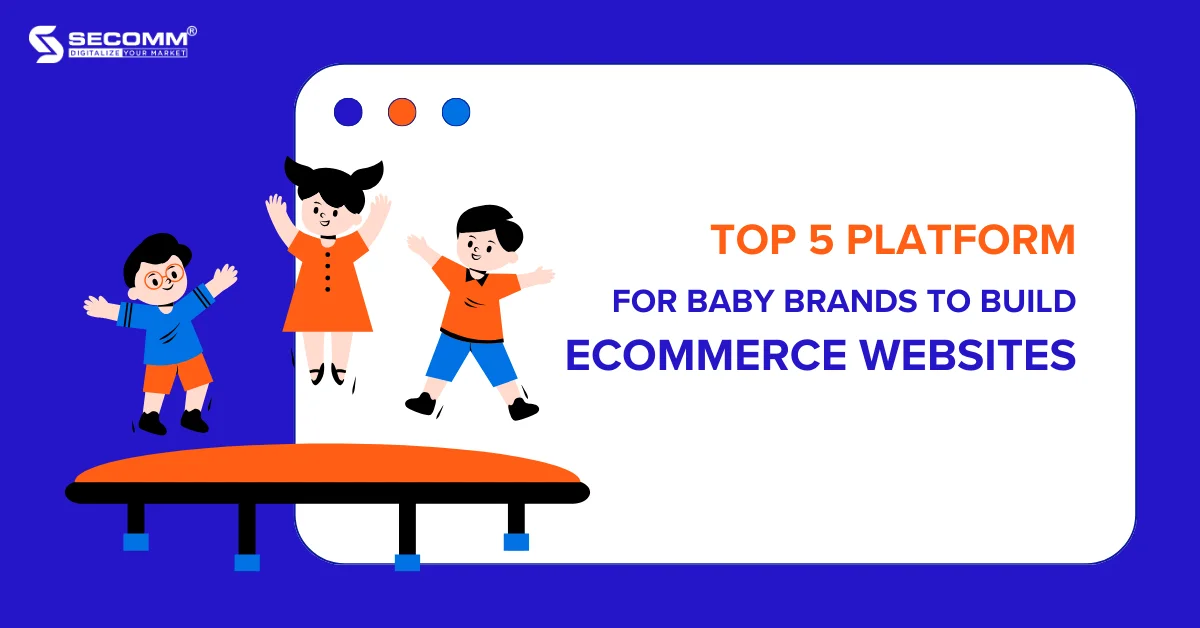
The first step in the strategy for building and developing an eCommerce website, a crucial consideration for business owners in various sectors, is selecting an eCommerce platform that aligns with their business requirements.
The Baby eCommerce industry is no exception to this rule. So, what is the ideal choice? The following article outlines and clarifies the pros and cons of the top five eCommerce platforms for the development of Baby eCommerce websites.
Magento (now owned by Adobe), is an open-source eCommerce platform that grants businesses full authority to develop and manage their online store
For large enterprises in the Baby eCommerce industry with complex requirements for building and developing eCommerce websites, Magento’s high degree of customization and scalability, along with its wealth of outstanding features and extensions, can effectively cater to their needs. However, to fully leverage Magento’s capabilities, businesses should invest in both a specific budget and a requisite level of technical expertise.
Currently, Magento offers two primary versions:
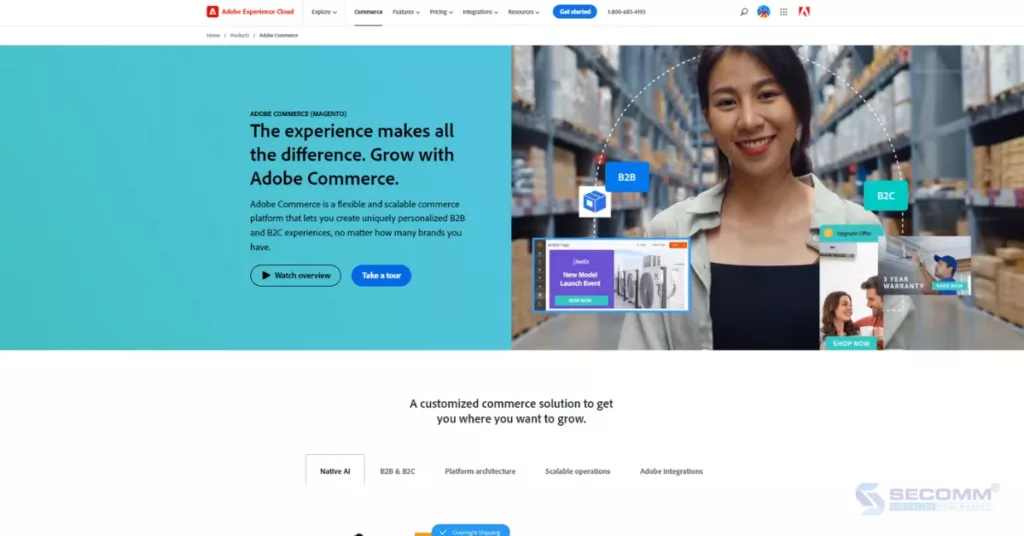
Key Features:
Pros:
Cons:
Pricing:

Brands built their Baby eCommerce websites on Magento including Kids Plaza VN, Bibo Mart, Children Salon, Mothercare VN, Aden+Anais, Hornby, v.v
Salesforce Commerce Cloud (SFCC) is a cloud-based Software as a Service (SaaS) solution that helps businesses build their eCommerce websites. This platform enables businesses to integrate all their sales channels, delivering a seamless shopping experience for customers.
SFCC offers two key solutions:

Key Features:
Pros:
Cons:
Pricing
For Salesforce B2C Commerce Cloud, businesses are offered three solution packages: Starter, Growth, and Plus, and they need to contact Salesforce for specific consultations and pricing.
For Salesforce B2B Commerce Cloud, businesses should get in touch with Salesforce for specific price levels and implementation details.
The cost of developing an eCommerce website using the SFCC platform can range from $2,000 to $500,000, depending on each business’s requirements.
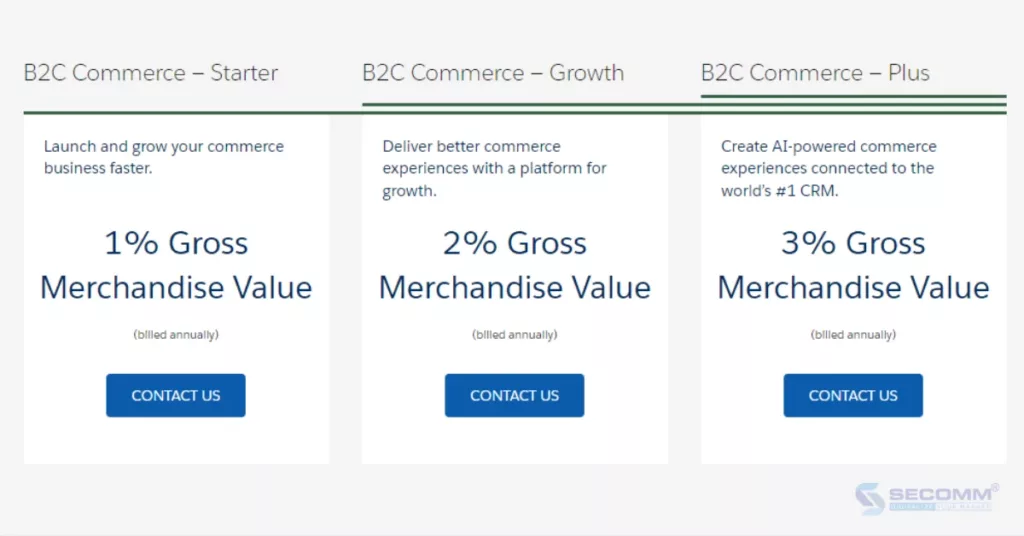
Some Baby brands that have developed eCommerce websites on the Salesforce Commerce Cloud platform include Carter’s, Hanna Andersson, OshKosh B’gosh, Chicco, Crayola, Toys “R” Us, Melissa & Doug, and more.
Shopify is a SaaS platform known for its diverse features and themes that cater to businesses of various industries and scales, facilitating the rapid and effective development of eCommerce websites.
Shopify offers three standard solution packages (Basic, Shopify, Advanced), tailored for small and medium-sized businesses. Meanwhile, the Shopify Plus solution is aimed at medium to large businesses with elevated development and customization requirements.
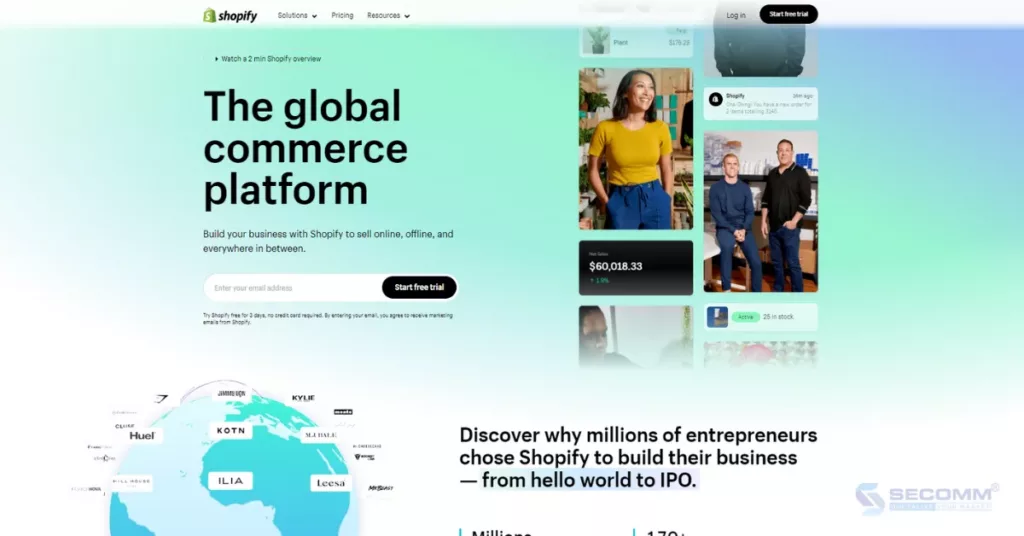
Key Features:
Pros:
Cons:
Pricing
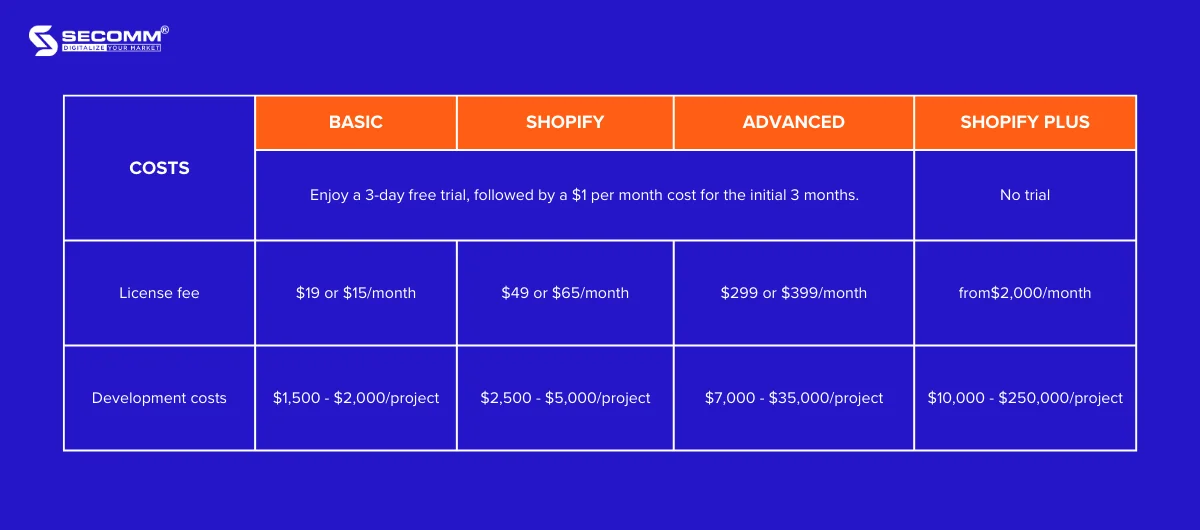
Shopify serves as the choice not only for Baby dropshipping stores but also for numerous well-known Baby brands that have used this platform to build their online store, including HATCH Collection, Motherhood Maternity, 4moms, Maclaren, Manhattan Toy, Tegu, and many others.
BigCommerce is another platform worth considering for Baby eCommerce businesses due to its ease of use and its ability to cater to the eCommerce website-building requirements of businesses across various scales and industries.
Furthermore, BigCommerce is recognized as a SaaS platform that includes a wide array of features within its solution packages (Standard, Plus, Pro, Enterprise) aimed at fostering eCommerce growth.
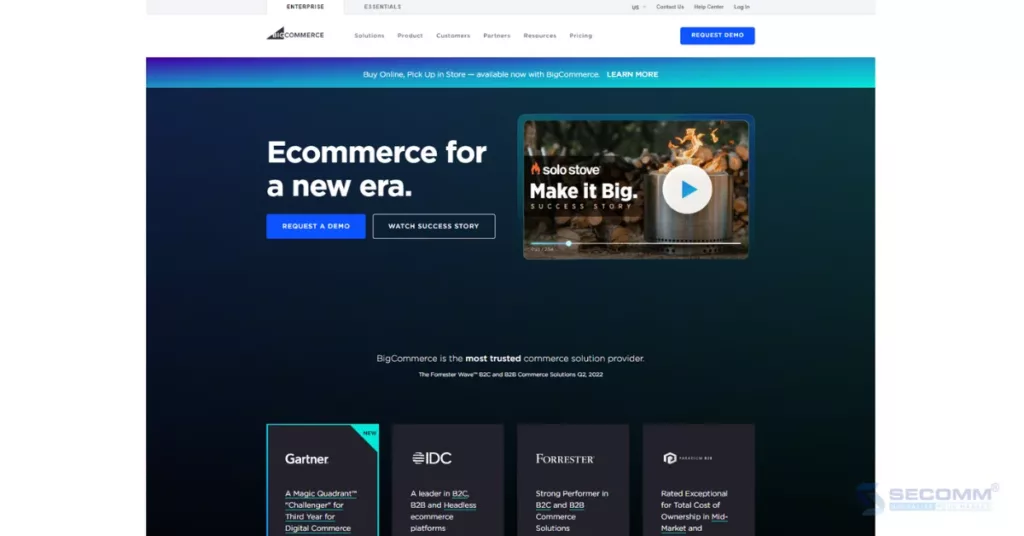
Key Features:
Pros:
Cons:
Pricing

Brands built their eCommerce websites with BigCommerce: Le Petit Kids, Scentos, Nature’s One, Kids Furniture Warehouse, See Kai Run, Feltman Brothers, v.v
Shift4Shop is a SaaS eCommerce platform that equips businesses with the essential tools and features to build and customize eCommerce websites. It presents a range of free and premium themes suitable for marketing Maternity and baby products.
Shift4Shop provides three paid plans (Basic, Plus, Pro) and one free plan, subject to a minimum monthly revenue of $500, designed for U.S. sellers under the End-to-End category.
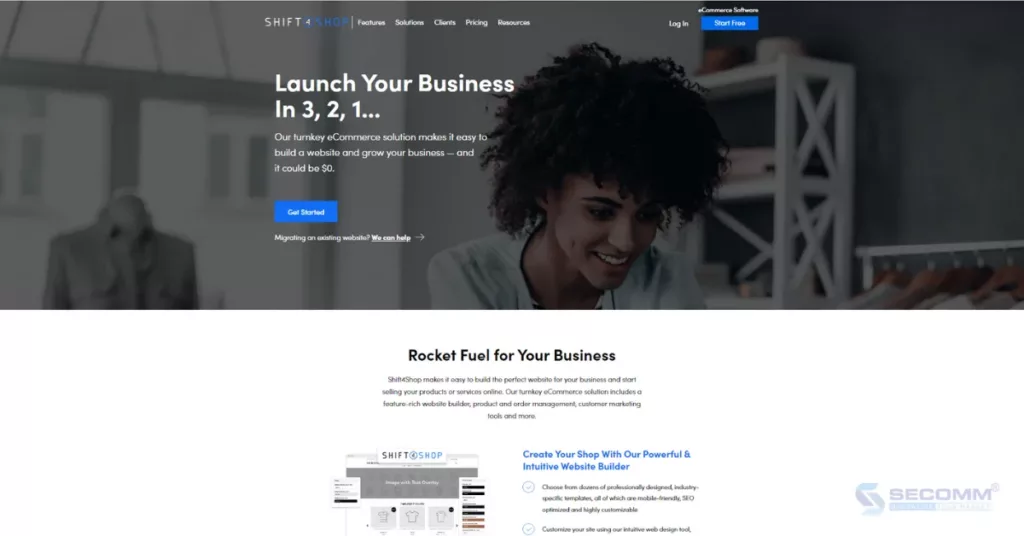
Key Features:
Pros:
Cons:
Pricing
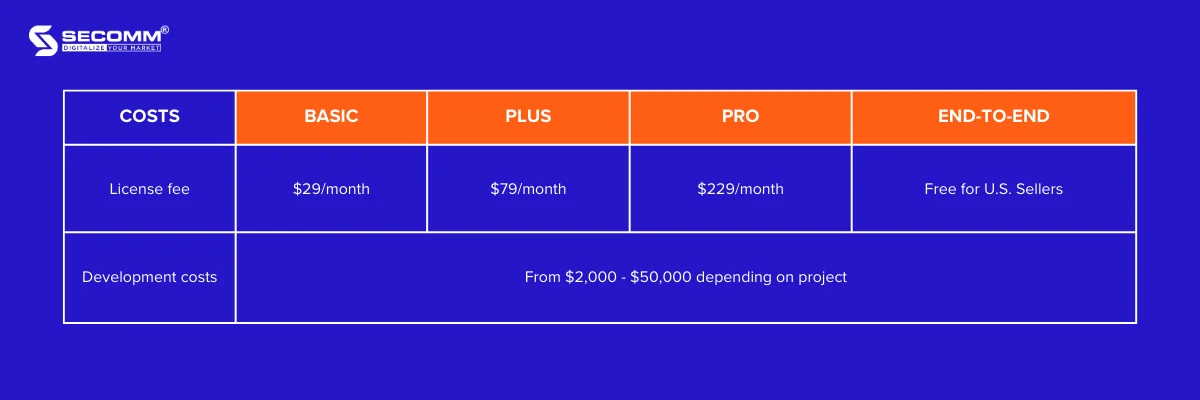
Brands built their Baby website with Shift4Shop: eLeMeNO-Pee, Sugar Babies, Nicki’s Diapers, Enfant Style, Ideal Baby & Kids, v.v
The above are the top 5 platforms that have been preferred by the majority of Baby businesses for establishing their eCommerce websites.
After years of eCommerce implementation across various countries, SECOMM has accumulated invaluable insights to expedite the process of website development and growth for Baby businesses.
Get in touch or directly call SECOMM‘s hotline at (02871089908) for immediate guidance on platform selection and eCommerce implementation today
 2
2
 10,700
10,700
 0
0
 1
1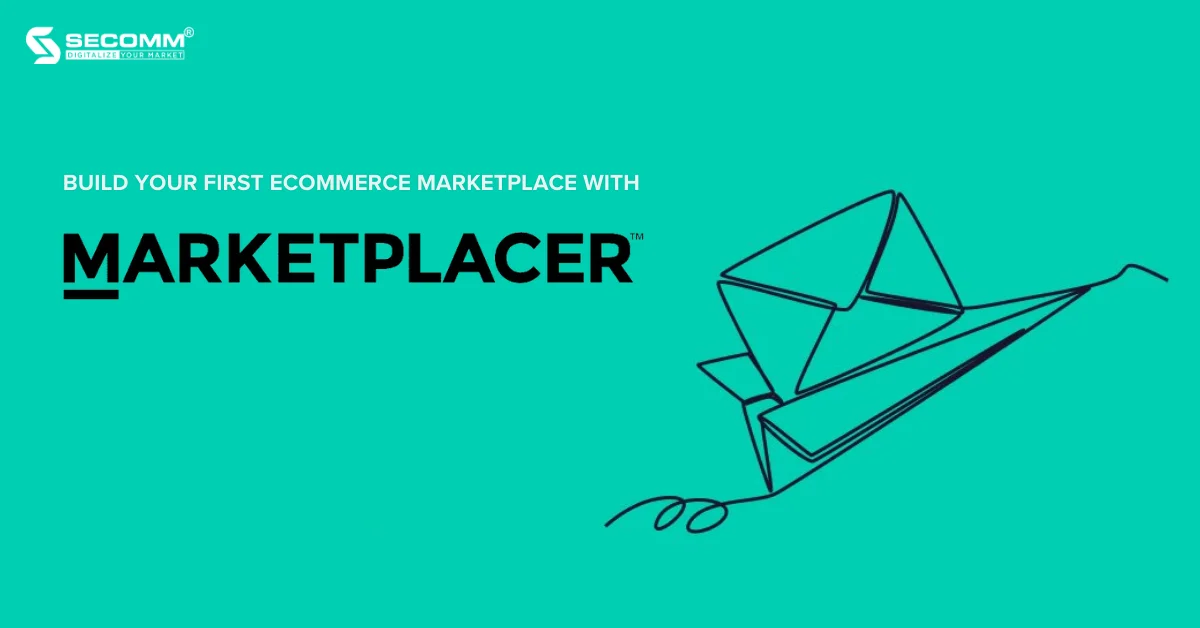
As reported by Digital Commerce 360, global consumers have collectively expended more than $3.25 trillion on famous eCommerce marketplaces such as Amazon, Ebay, and Alibaba. This indicates the increasing significance of online marketplaces in customer shopping experiences.
Therefore, many businesses have promptly devised strategies to enter the race for market share in eCommerce landscape. To achieve this goal, businesses must first develop their own marketplaces. The initial but crucial step in this process is selecting the ideal platform.
The following article focuses on introducing this platform as a recommendation for large businesses among countless optimal choices out there.
Marketplacer is a Software as a Service (SaaS) platform hosted on AWS, providing businesses with essential tools and features for building professional and highly adaptable eCommerce marketplaces capable of rapid scalability and swift page loading.
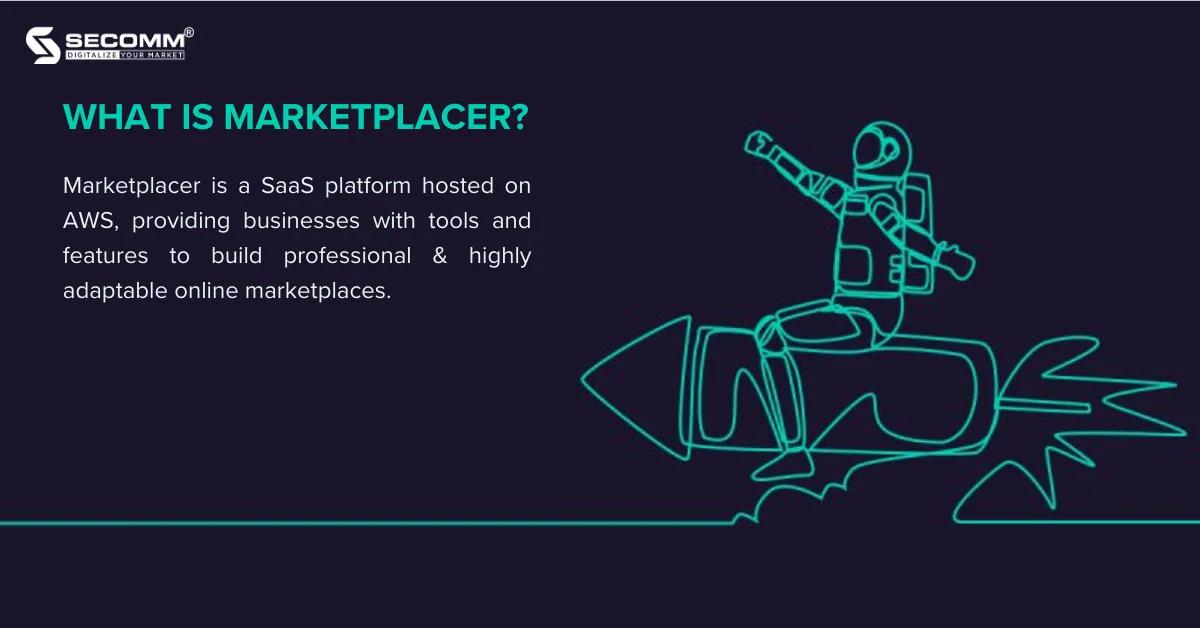
This platform streamlines the management and administration of eCommerce marketplaces. It simplifies tasks like order fulfillment, product category adjustments, third-party extension integration, cross-marketplace operational synchronization, and the implementation of strategies for revenue optimization.
To date, this platform has successfully established and expanded over 100 eCommerce marketplaces, forging connections with more than 13,000 sellers spanning the globe.
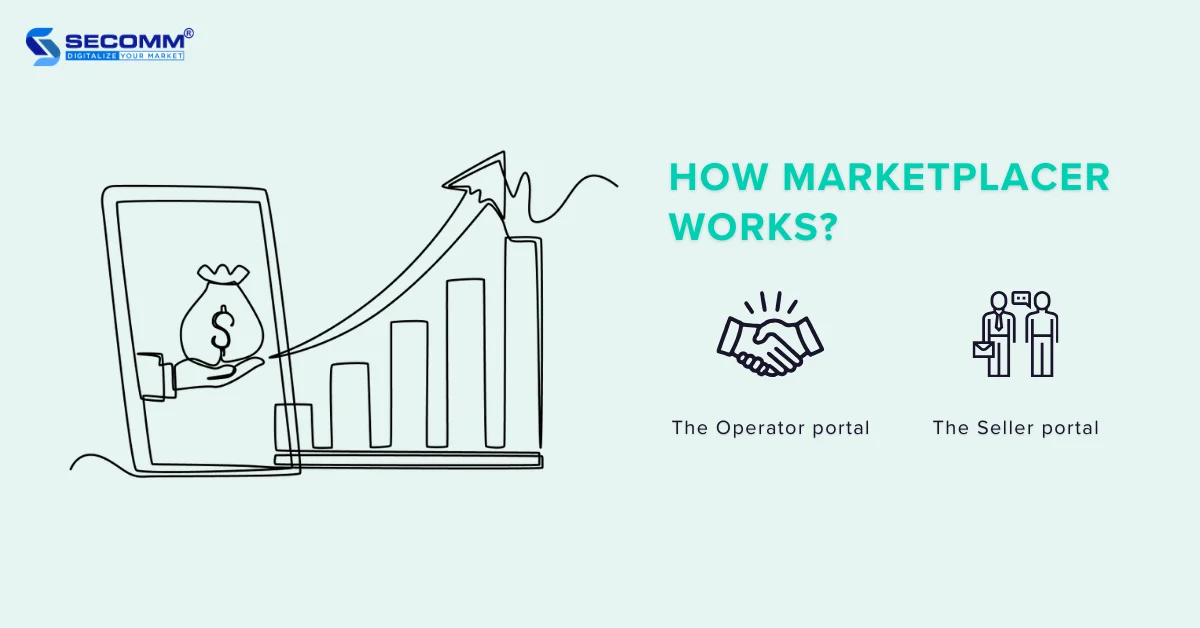
This platform offers businesses a Marketplace-wide API based on GraphQL API, allowing them to:
Furthermore, Marketplacer provides businesses with access to Webhooks, enabling them to receive notifications from the Marketplacer platform for any changes or updates during their operations.
This platform provides sellers on the marketplace with Seller API based on V2 (REST) API to
Similar to how businesses operate their business on the marketplace, sellers also have access to webhooks for receiving notifications regarding changes throughout their selling journey.
This platform offers two implementation models, allowing businesses to tailor the development of their online marketplace to align with their specific goals.
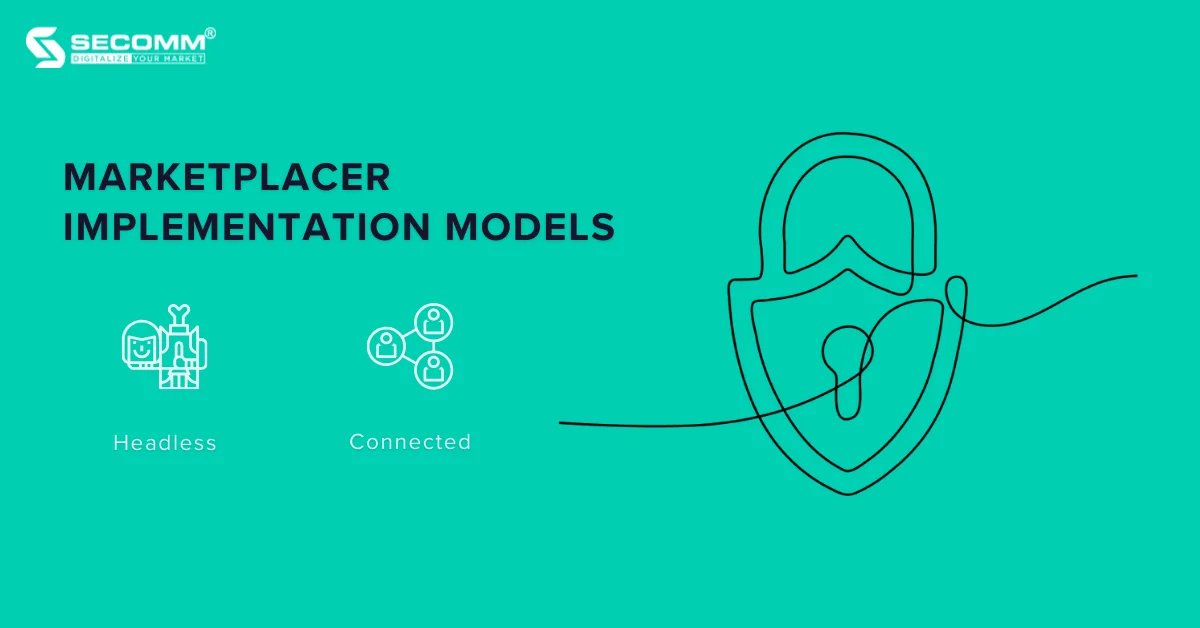
The Headless model empowers businesses to utilize their tailor-made frontend, commonly known as the “head,” which represents the user interface. This frontend is integrated with Marketplacer’s fundamental backend through APIs to execute the marketplace.
Therefore, opting for the Headless model is ideal for businesses seeking extensive control over the user experience while leveraging Marketplacer’s core technology to foster eCommerce growth.
In the Connected model, businesses can efficiently integrate a pre-built eCommerce system into Marketplacer’s backend, avoiding the need for an extensive time and financial resources to build from scratch. This integration allows businesses to maintain the full functionality of the pre-existing system while benefiting from this platform’s advanced infrastructure for seamless marketplace deployment.
It’s worth noting that Marketplacer currently offers pre-built connectors exclusively for three prominent platforms: Adobe Commerce, Salesforce Commerce Cloud, and commercetools. As a result, the Connected model is best suited for businesses utilizing one of these three platforms to facilitate their eCommerce.
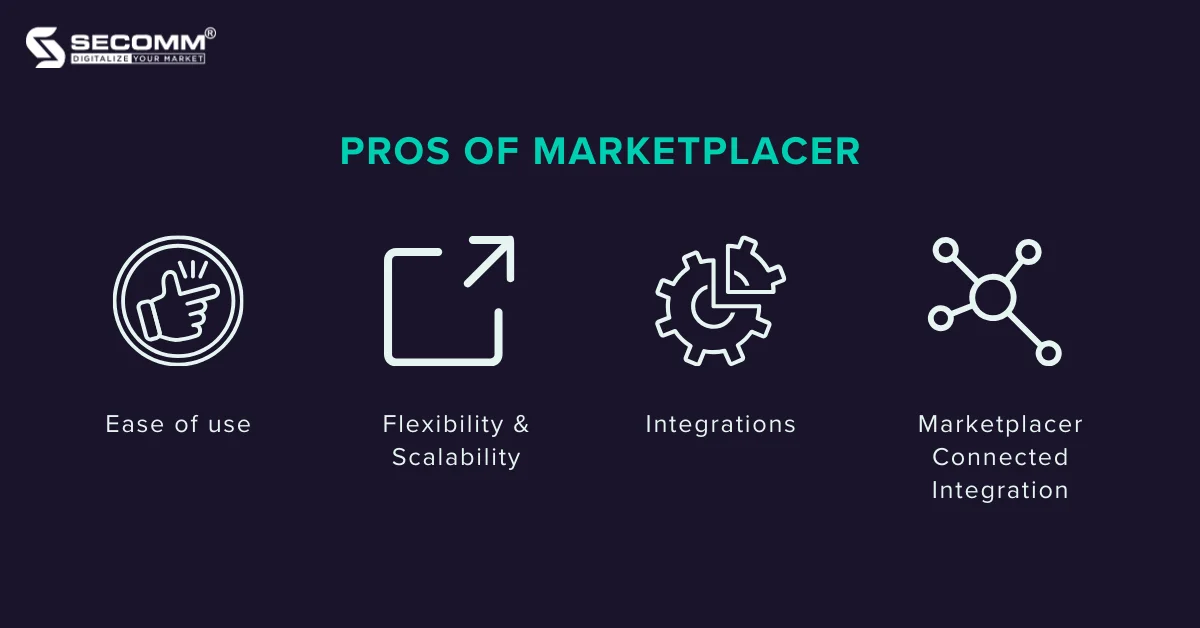
This platform offers a user-friendly interface and intuitive tools, making it simple for businesses to build and manage their online marketplace.
This platform is tailored to suit online marketplaces of diverse sizes. The platform boasts excellent scalability and remarkable flexibility, empowering businesses to manage an ever-increasing volume of sellers, customers, and listing products. This facilitates seamless expansion of operations as needed.
Businesses can easily discover well-known applications and extensions within Marketplacer’s growing collection of available integrations. Some noteworthy integrations include popular social media platforms like Facebook, Twitter, and LinkedIn, as well as payment gateways such as PayPal, Zooz, Yotpo, and advertising management tools like Fuze, Firstpage, and Citrus Ad.
Marketplacer’s success is attributed to its ‘Connected’ technology, enabling businesses to deploy their marketplaces with two versatile options: crafting a tailored frontend or integrating seamlessly with existing systems.
Also, businesses can effortlessly blend third-party products into their current inventory, broadening their product range and portfolio with minimal investment and mitigating product lifecycle management tasks. This model is known as the Hybrid Marketplace and has been successfully adopted by enterprises like Amazon, Walmart, and others.
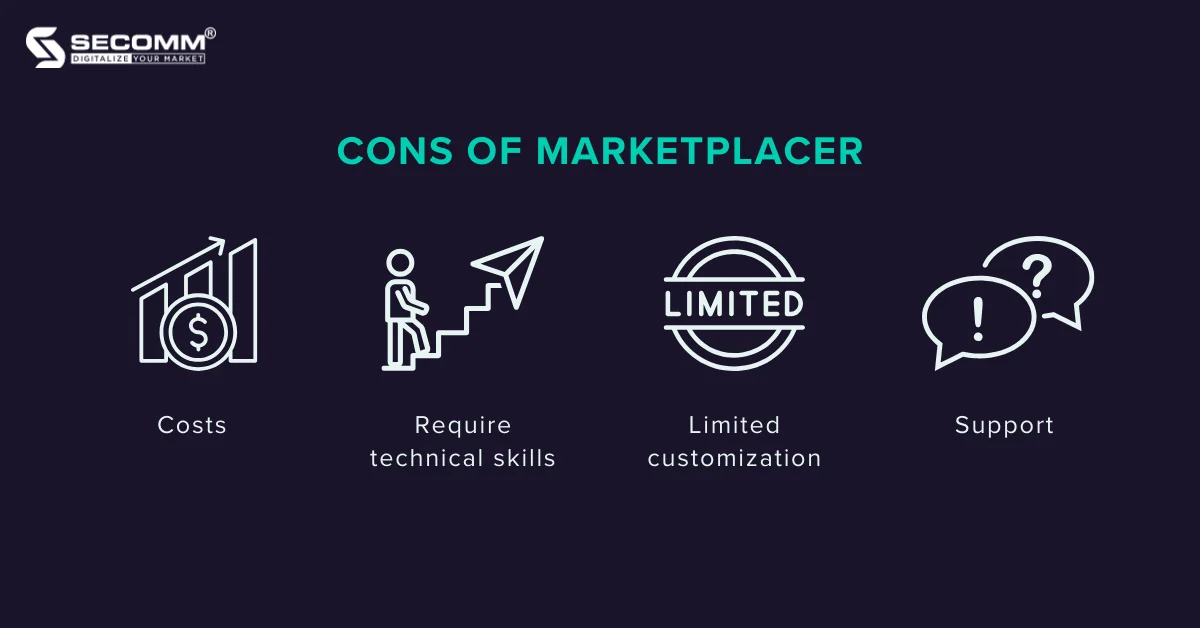
The license fee isn’t publicly available and businesses are required to reach out to the Marketplacer team for a personalized consultation and cost estimates. Furthermore, the platform doesn’t offer a trial version, which may pose challenges for businesses when planning their implementation budget.
While this platform offers a user-friendly interface, it may pose challenges for users who are not familiar with building and operating an eCommerce marketplace. Therefore, the implementation process will require businesses to have technical expertise, or they can seek specialized assistance to efficiently build and optimize the platform.
Despite its flexibility and high degree of customization, Marketplacer’s ability to meet the highly complex deployment needs of large-scale eCommerce systems may pose challenges.
This platform provides 24/7 support services and offers learning resources, but there is room for improvement in the quality and responsiveness of their support. Plus, as an Australian-based company primarily serving the Australian market, some of their terminology might be less clear to international customers.
To successfully build and operate a thriving eCommerce marketplace, the first thing businesses need to do is choose a platform. This platform is one of the standout platforms that businesses should consider.
Feel free to contact or call SECOMM’s hotline at (028) 7108 9908 for free consultations.
 2
2
 14,820
14,820
 0
0
 1
1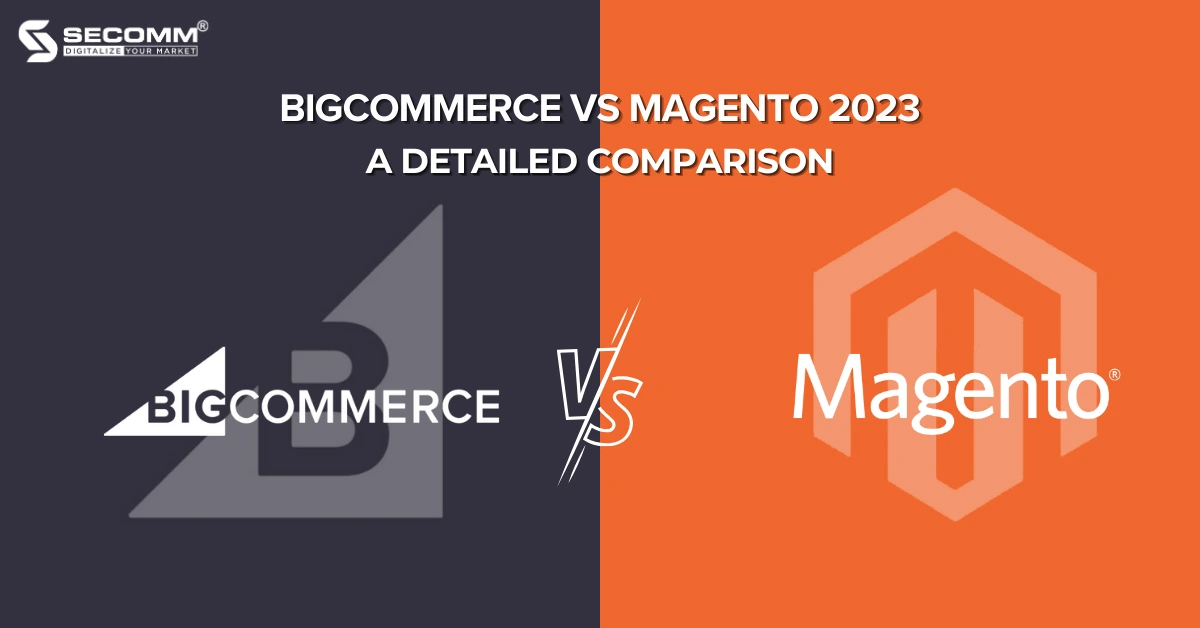
BigCommerce and Magento are trusted names representing two types of eCommerce platforms: SaaS and Open Source. The demand for developing eCommerce websites on these platforms is increasing. However, deciding between the two is a complex task.
This article aims to highlight the pros and cons of each and provide a thorough comparison, helping you as a business make informed decisions.
BigCommerce is a robust SaaS eCommerce platform, boasting an array of integrated features packaged to accommodate businesses of all scales and technical proficiencies. This platform facilitates the swift development of eCommerce websites. Beyond its inherent capabilities, BigCommerce extends a diverse suite of tools and extensions covering sales, marketing, SEO, data analytics, and transformation, empowering businesses to drive eCommerce growth.
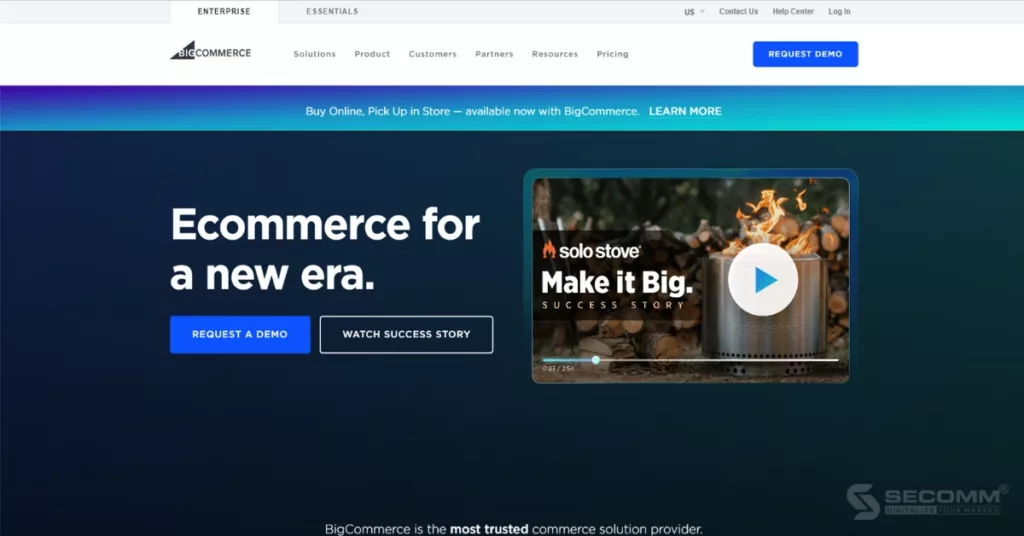
Magento (now owned by Adobe) is an open-source eCommerce platform that empowers businesses with full control over developing and managing their eCommerce websites. Known for its high level of customization and scalability, Magento offers a wide range of advanced features and extensions, making it an ideal choice for meeting the complex requirements of large-scale enterprises with ample budgets and a certain level of technical expertise. Magento currently comes in two main versions:
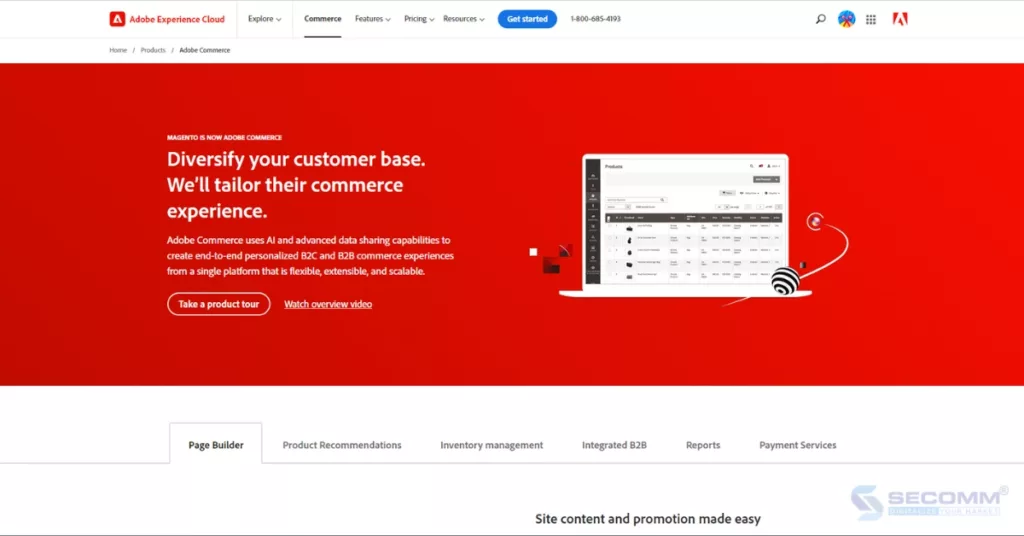
Pros:
Cons:
Pros:
Cons:
Ease of use of a platform is one of the primary considerations for an eCommerce business when selecting one. A platform with an intuitive interface that is easy to set up and manage allows businesses to focus on their core operations.
BigCommerce
BigCommerce is a SaaS platform, making it more accessible for businesses that may not possess technical expertise or have a strong tech background in building eCommerce websites. It eliminates the need for complex programming; businesses simply need to provide basic information to gain access to the BigCommerce dashboard, where they can configure and manage all aspects of their online store, from product additions to layout modifications.
What’s more, BigCommerce offers a user-friendly drag-and-drop page builder that empowers businesses to create a storefront without the necessity of coding skills. Moreover, themes and extensions can be swiftly integrated with just a few clicks.
Magento
On the other hand, Magento users should have a certain level of technical expertise to execute tasks during the setup of an eCommerce website, including configuring FTP files and integrating themes into the Magento website, among other things. Tasks like modifying themes, integrating extensions, applying security patches, and optimizing speed require coding skills.
Therefore, many businesses opt to collaborate with Magento agencies to develop and maintain their Magento eCommerce websites. However, following the initial technical setup challenges, businesses can readily customize attributes and functionalities for their websites through the platform’s backend.
BigCommerce
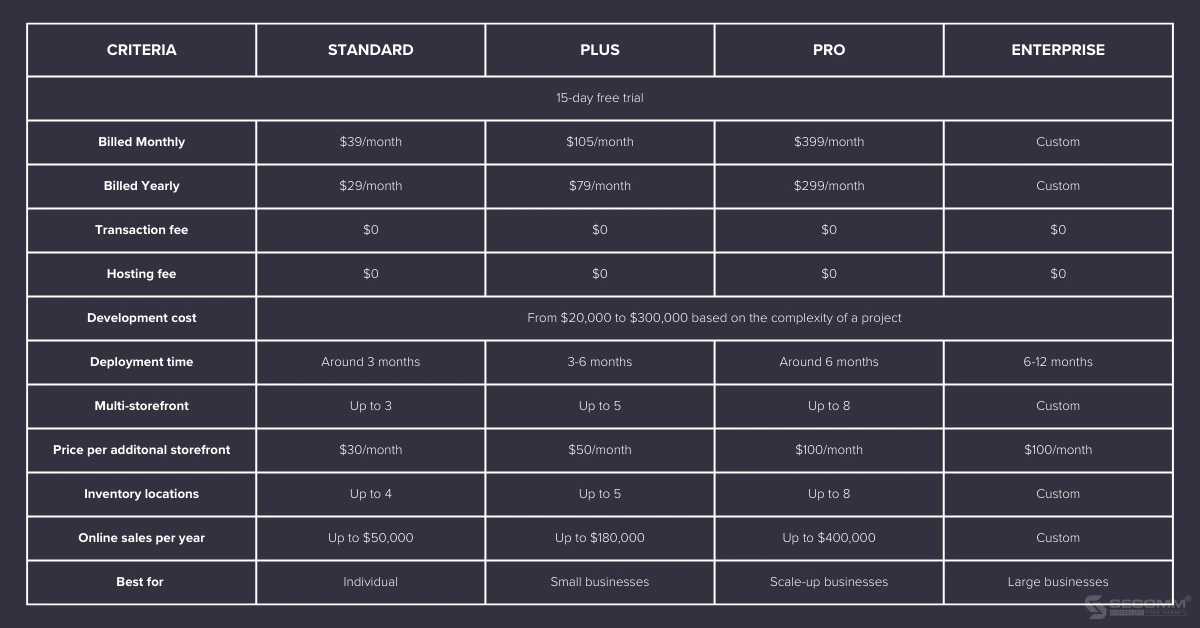
Magento
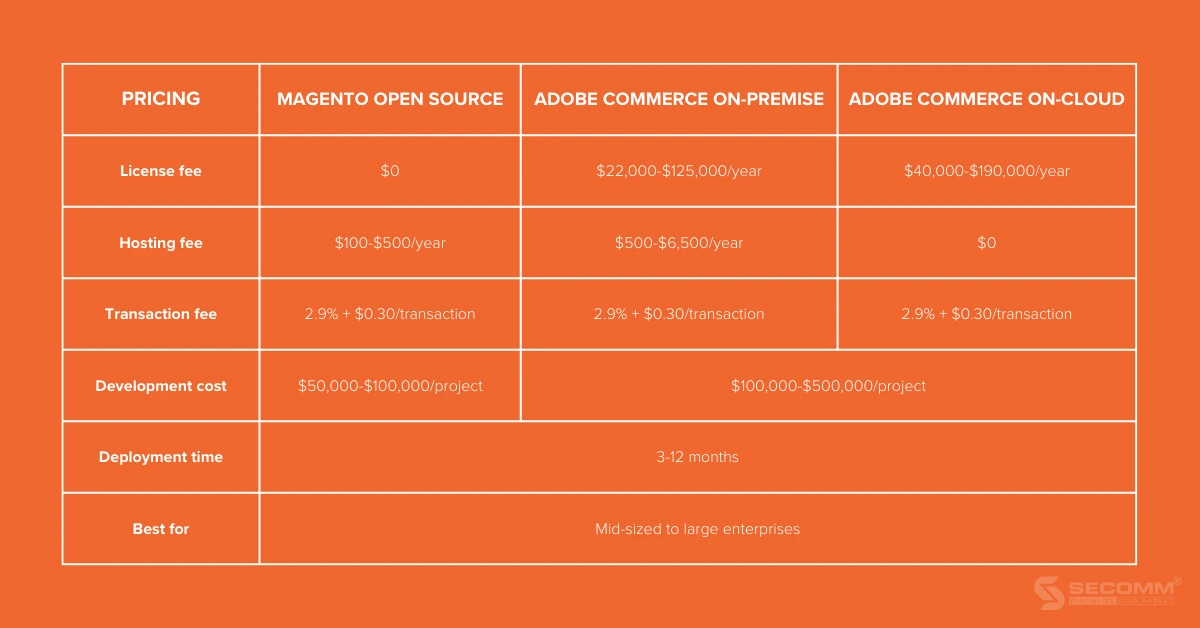
BigCommerce
Being a SaaS platform, BigCommerce offers support for various hosting-related issues, ensuring an impressive average uptime of 99.99%, quick page loading, and minimal website maintenance.
Magento
Adobe Commerce on-cloud: Hosting for the business’s Magento eCommerce site is provided, configured, managed, and stored on virtual servers offered by cloud service providers (CSPs) like AWS and Microsoft Azure.

SEO
SEO is a crucial feature that every eCommerce website needs and it’s an important factor for businesses to consider when assessing a platform. Both BigCommerce and Magento offer essential SEO optimization features, which include:
However, BigCommerce includes a built-in ‘blog’ feature in its solution packages, while Magento requires businesses to integrate a ‘blog’ extension to use this feature.
Plus, businesses can enhance their website’s SEO by using extensions available in the Magento and BigCommerce marketplaces. It’s worth noting that Magento offers a wider range of advanced SEO tools, although the cost of Magento extensions may be higher than those available for BigCommerce.
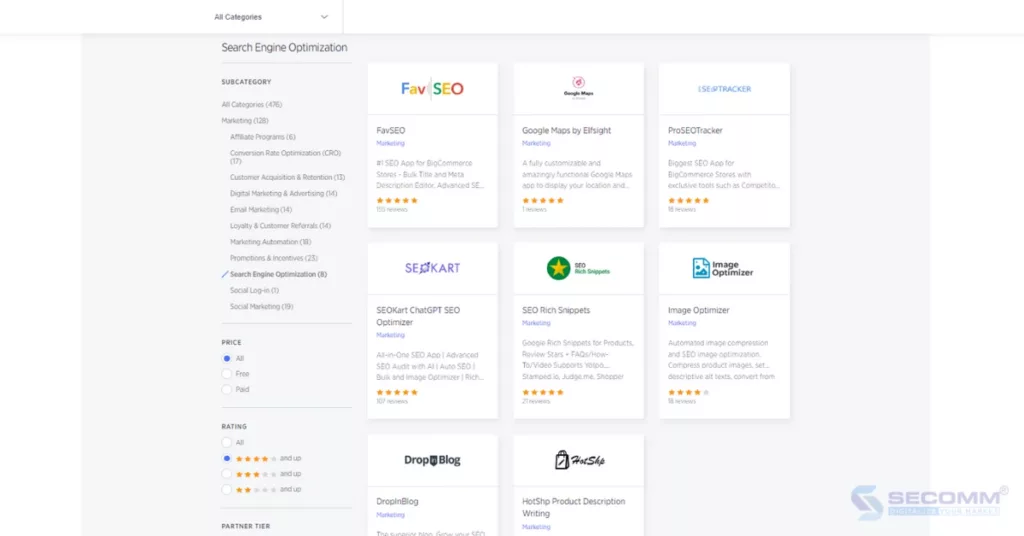
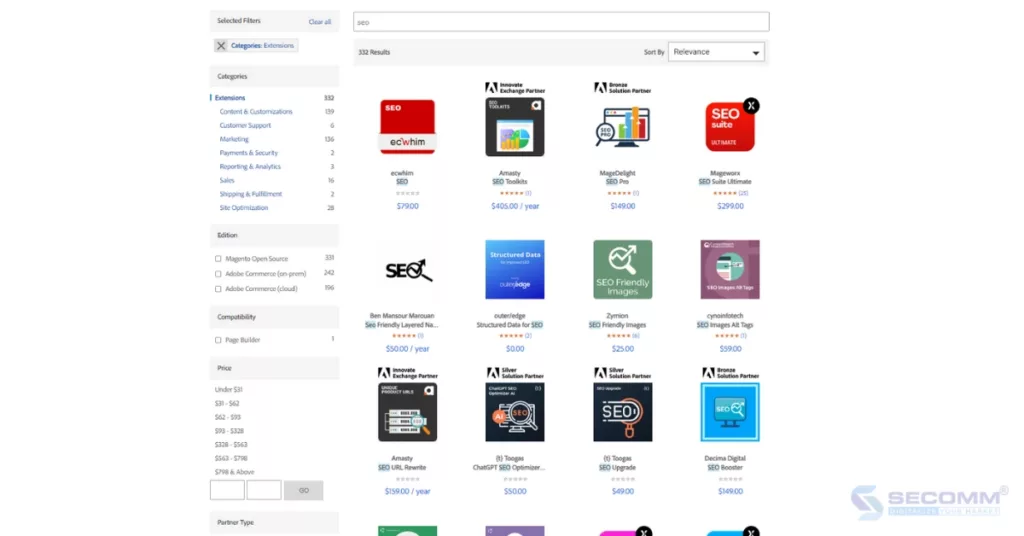
Multiple channels integration
With this feature, BigCommerce excels over Magento by pre-integrating the most prevalent sales channels like Amazon, eBay, Walmart, Facebook, and Instagram into all pricing plans. However, if businesses require integration with additional sales channels beyond these pre-set options, they can do so by utilizing apps from BigCommerce’s marketplace.
On the other hand, Magento offers businesses the flexibility to implement multi-channel sales by integrating various desired sales channels into their eCommerce website, each with its own associated costs. Notably, Amazon integration can be done for free.
Purchase flow
eCommerce businesses have to ensure a seamless, swift, and user-friendly customer buying journey, encompassing features like product search support and an effortless payment process. Both Magento and BigCommerce provide capabilities to facilitate online shopping, including
Payment options
BigCommerce provides businesses with 65 integrated payment gateways, including popular options like Apple Pay, Google Pay, and Amazon Pay, all with no transaction fee.
In contrast, Magento offers only PayPal and Authorize.net for payments, requiring businesses to integrate third-party payment providers for more choices. Magento’s marketplace features over 450 payment-related extensions with various costs, but businesses will need time to select and integrate them.
Aside from features, themes, and extensions also contribute significantly to the growth of an eCommerce website. Therefore, this is another factor that businesses take into account when selecting a platform.
BigCommerce
The platform provides 266 themes with prices ranging from $195 to $395, including 12 free themes. Businesses can purchase BigCommerce themes on ThemeForest at prices ranging from about $16 to $179.
These designs are modern, suitable for various industries, and offer good responsiveness across multiple screen sizes, including smartphones, tablets, and desktops. However, when compared to other SaaS platforms like Wix or Squarespace, BigCommerce’s customization options and the quantity of both free and paid themes may appear relatively limited. Moreover, the exact count of free and paid themes might not be entirely precise, as some themes share very similar layouts, differing mainly in color schemes.
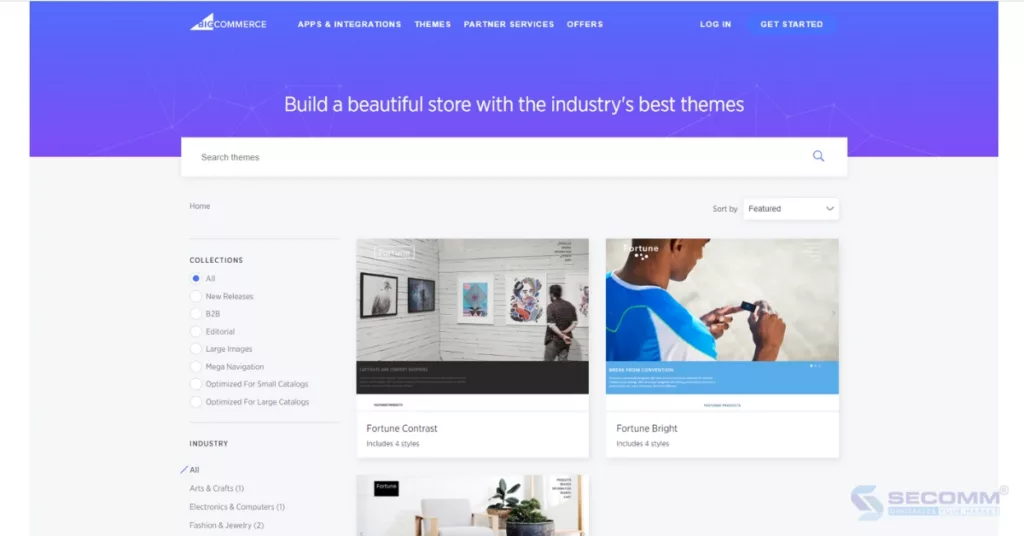
Magento
Unlike BigCommerce, Magento provides a limited selection of themes, with just 9 options available. Among these, only 3 themes are free, while the rest range in price from $150 to $499 each. If businesses opt to purchase Magento themes on ThemeForest, they can expect prices ranging from $39 to $299 per theme.
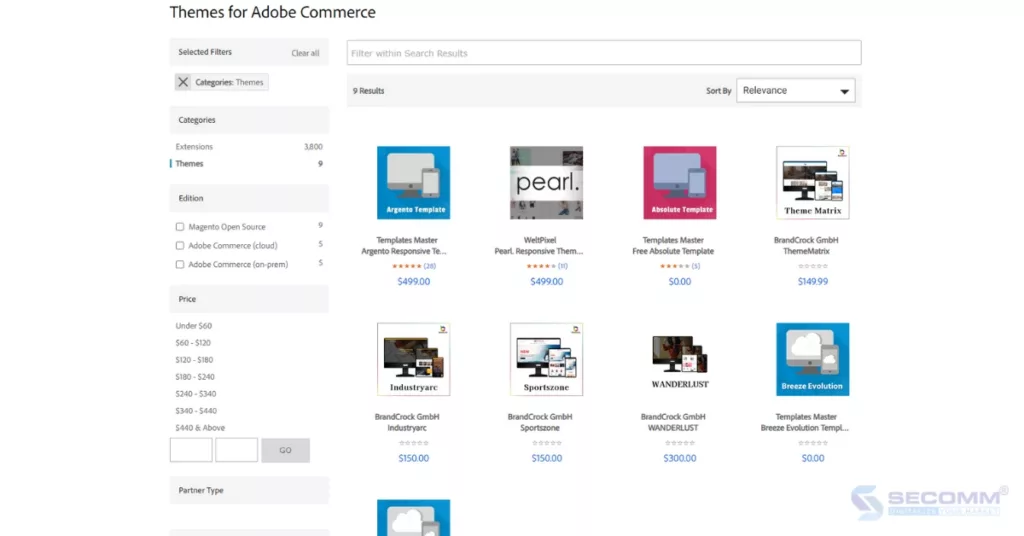
Moreover, businesses have the option to create custom interfaces tailored to their unique requirements by partnering with specialized providers, incurring costs typically ranging from $1000 to $5000.
Regarding extensions, both BigCommerce and Magento offer extensive extension libraries to support businesses in growing their eCommerce stores. However, Magento has a slight edge in this regard.
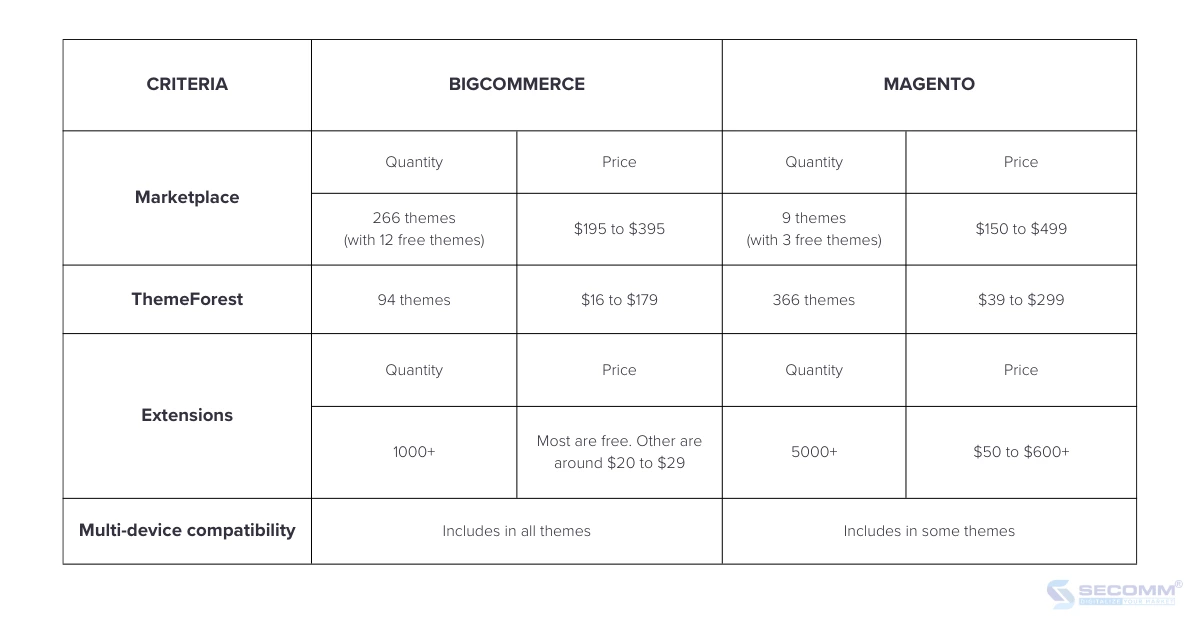
Customization involves the capacity to adjust any feature, theme, or integrated extensions to meet specific requirements for an eCommerce website. Scalability, on the other hand, refers to the ability to maintain platform performance as the eCommerce site expands. Therefore, these factors play a vital role in platform selection.
Customization
Magento operates as an open-source platform, giving developers full access to and control over the source code.
On the other hand, BigCommerce functions as a SaaS platform, restricting businesses from making backend modifications. While certain frontend interface adjustments are possible with a few code snippets, most modifications need to be done in the backend. Hence, BigCommerce’s customization is somewhat limited compared to Magento.
Scalability
Both Magento and BigCommerce can handle large website traffic and sales volumes. However, Magento outperforms BigCommerce in this aspect, which is also why Magento doesn’t have sales volume limits.
Meanwhile, BigCommerce imposes annual sales volume limits based on the pricing plan being used. When businesses reach the sales volume limit of their current pricing plan, they need to upgrade to a higher-tier plan.
Both BigCommerce and Magento are prominent names in the eCommerce industry, trusted by numerous businesses for their security features. Nevertheless, when it comes to providing security-related assistance, these platforms exhibit notable differences.
As a SaaS platform, BigCommerce includes security support as an integral component of its solution packages. This encompasses SSL certificates, firewalls, backups, and intrusion detection. In case any complications arise during the eCommerce deployment process, businesses can readily access 24/7 customer support for swift assistance.
In contrast, due to Magento’s open-source nature, businesses bear the responsibility for managing the security aspects of their Magento eCommerce websites. This entails tasks such as overseeing SSL certificates, implementing two-factor authentication, and adhering to PCI compliance. Additionally, while Magento periodically releases security updates, the manual update process can pose challenges for users without technical expertise.
Magento’s support options also present limitations when compared to BigCommerce. Businesses can seek assistance during Magento’s specified operating hours or engage with third-party intermediaries, a potentially time-consuming and complex process.
BigCommerce and Magento are both leading options for eCommerce businesses, but their levels of popularity differ somewhat.
According to BuiltWith, at the present time, there are 142,010 active websites using Magento, whereas there are only 44,796 active websites using BigCommerce.
Thus, when it comes to popularity, Magento has the upper hand.
Well-known brands such as Coca-Cola, Nike, and Tesla utilize Magento, while renowned brands like Skullcandy, LARQ, and Molton Brown opt for BigCommerce.
After many years of implementing eCommerce solutions for clients all around the world, using both the BigCommerce and Magento platforms, SECOMM has gained invaluable experience in helping businesses develop and operate their eCommerce websites quickly and efficiently.
Contact us or call SECOMM’s hotline directly at (02871089908) for a free consultation on implementing eCommerce websites with BigCommerce or Magento.
 2
2
 11,804
11,804
 0
0
 1
1
Recently, the trend of Headless CMS deployment has significantly influenced the eCommerce landscape. The emergence of diverse platforms offering various solutions, features, and top-notch customer support can be attributed to this phenomenon.
Building upon Part 1, this article highlights 5 more Headless CMS platforms that numerous large enterprises leverage to enhance their seamless multi-channel content distribution process.
Kontent.ai is a cloud-based Headless CMS platform that helps marketers simplify their content creation and management while providing developers the capability to deliver responsive digital experiences across various devices.
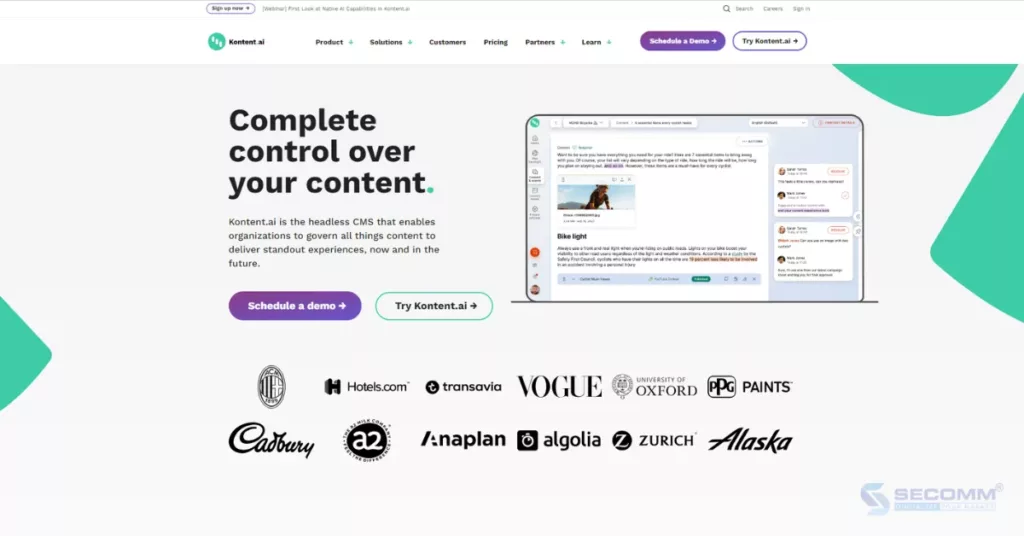
The platform offers support for developers through a range of APIs, including REST, GraphQL, Management v2, and Custom Element JavaScript. Furthermore, Kontent.ai is compatible with programming languages such as JavaScript, .NET, PHP, Java, Ruby, and iOS.
Kontent.ai offers three solution packages

Contentstack stands out as a leading Headless CMS platform, facilitating seamless content distribution across multiple channels and devices, ranging from websites, and mobile apps to IoT devices. It offers robust support for popular frameworks like REACT, Vue.js, Angular, and a variety of programming languages such as JavaScript, PHP, Ruby, and Python, among others. Moreover, Contentstack allows businesses to integrate with various platforms, including BigCommerce, Commercetools, Shopify, YouTube, Vimeo, and more.
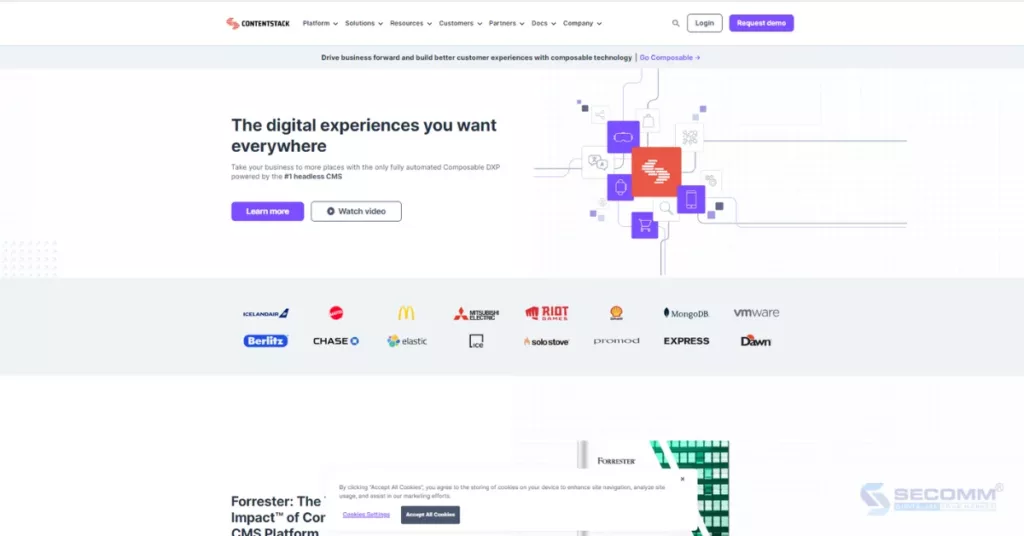
Contentstack offers businesses three solution packages:
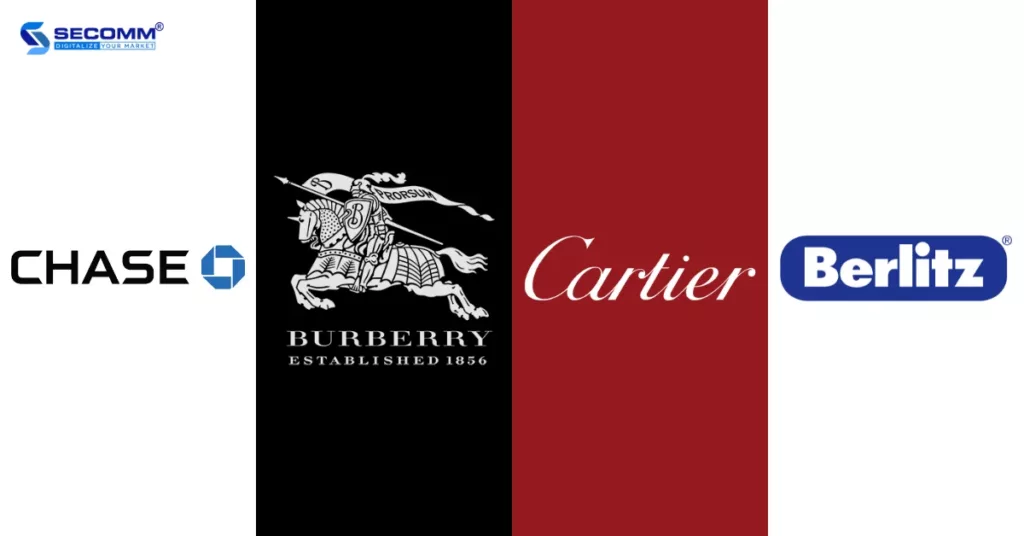
dotCMS is an open-source Headless CMS based on Java, offering numerous solutions and features that enable businesses to create and reuse content for building personalized and seamless digital experiences across channels. dotCMS supports APIs like REST and GraphQL and can integrate with platforms such as HubSpot, Google Analytics, Salesforce, and more.
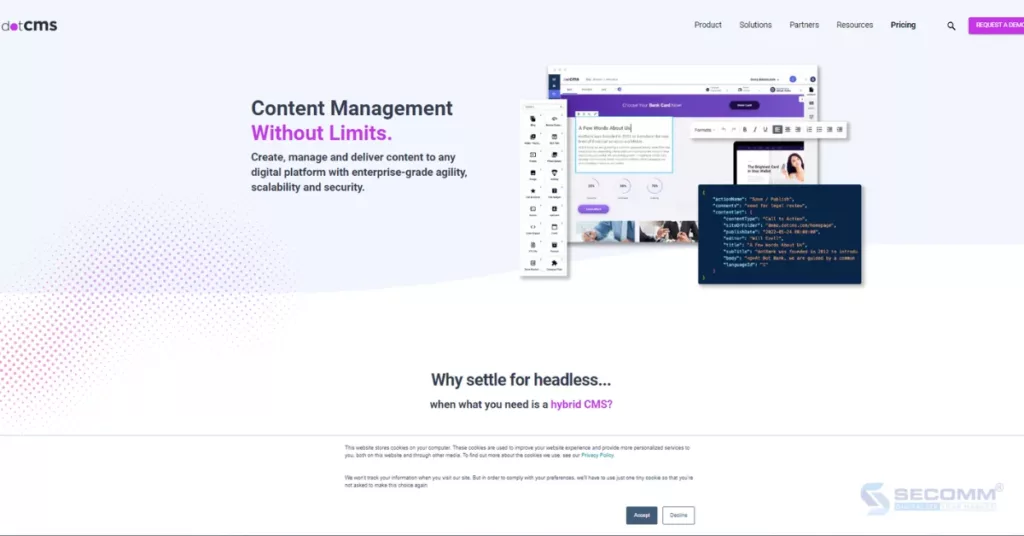
dotCMS offers three solution packages for users to choose from:
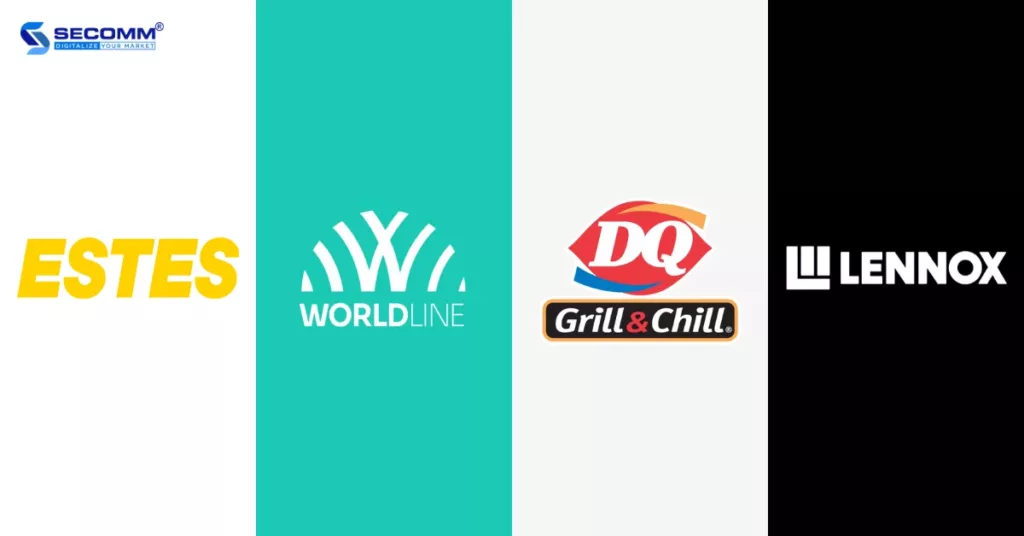
Butter CMS is a Headless CMS platform that simplifies content development and management for businesses. The platform supports frameworks such as React, Vue.js, Node.js, Angular, and various programming languages like PHP, Python, Java, Swift, Kotlin, Ruby, and more.

Butter CMS offers a variety of solution packages, including

Builder.io is a Headless CMS platform that allows businesses to visually build and optimize web and mobile experiences. The platform supports developers with frameworks like React, Vue.js, Gatsby, and Next.js. Additionally, businesses can integrate Builder.io with popular platforms such as Shopify, BigCommerce, Salesforce, Magento, Cloudinary, Yotpo, Commercetools, and more.
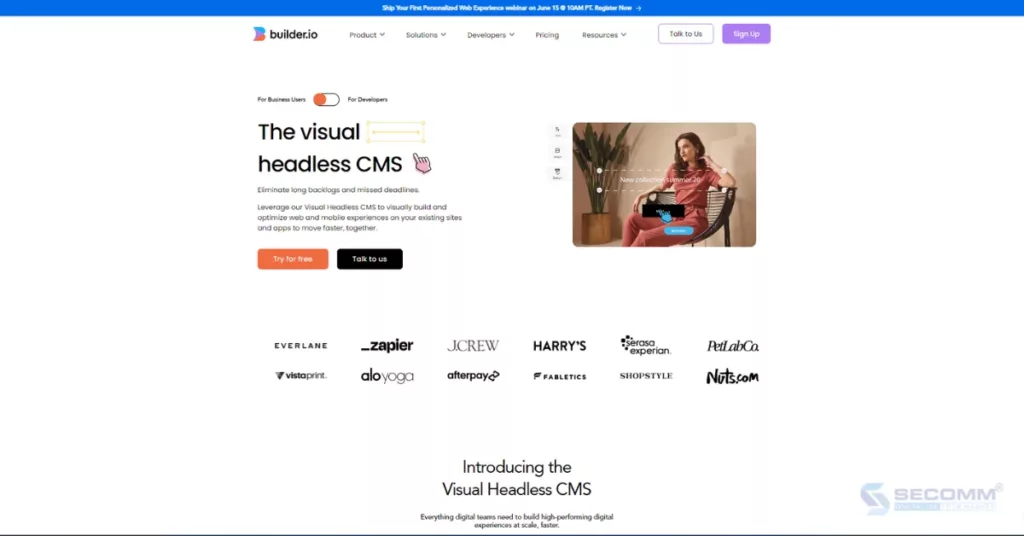
Builder.io offers a range of solution packages:
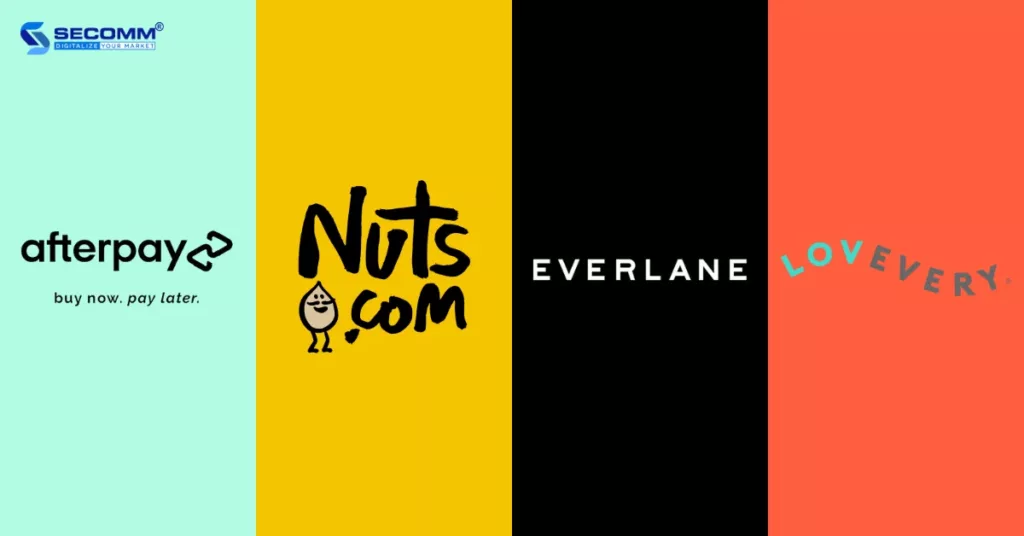
So, SECOMM’s comprehensive overview of the top 10 Headless CMS platforms (P1+P2) has concluded, with the expectation that enterprises will find the platform that aligns with their development requirements. By adopting a Headless CMS, businesses can promptly establish an online presence and efficiently connect with numerous potential customers through compelling content distribution.
Feel free to get in touch with SECOMM or directly call our Hotline at (02871089908) for expert guidance and assistance in implementing a Headless CMS.
 2
2
 10,571
10,571
 0
0
 1
1Subscribe to get the latest eBook!
Hotline